As published in July by the East-West News Service

An American journalist in search of Southeast Asia

As published in July by the East-West News Service

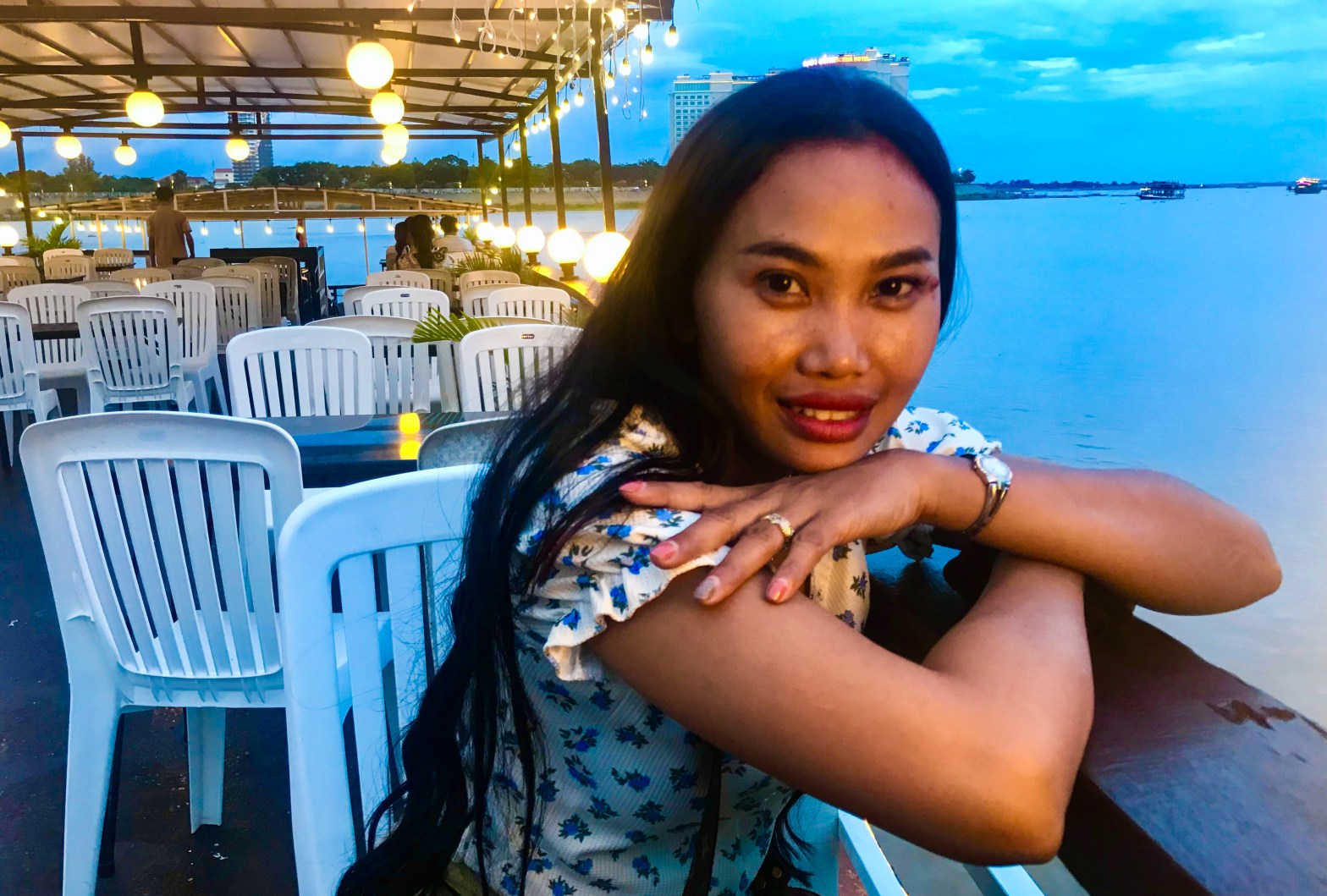
Fresh crab, provocative spices, wildlife-rich national parks, and French colonial heritage: There’s a lot to like about these coastal towns.

Chili sauce dripped down my chin as I dabbed the sweetness from the corners of my mouth. The fresh crab, with its striking resemblance to the Dungeness variety, was like nothing I’d eaten since I left my home in the Pacific Northwest four years ago.
Minutes earlier, it had been bathing in seawater off the pier at Kep, a fishing village and minor beach resort beside the Gulf of Thailand on the southern coast of Cambodia. Now it was on my plate, cracked and served with chopped chunks of garlic and strings of local Kampot peppercorns that lent a tantalizing aroma.
Judging from the number of cracked claws I counted, I must have consumed at least three crabs — a full kilogram, or 2.2 pounds. The price tag? In Cambodian riels, about 41,000. In US dollars? $10. (Rice and a can of Ganzberg beer brought the total to $11.)
The crab market at Kep is famous throughout Cambodia. It’s not just fresh crab that’s sold here, of course; it’s all manner of seafood, from fish to shrimp, octopus, squid, skate and shellfish. Nearby, other merchants sold local fruit: It was clearly the season for rambutan and durian.
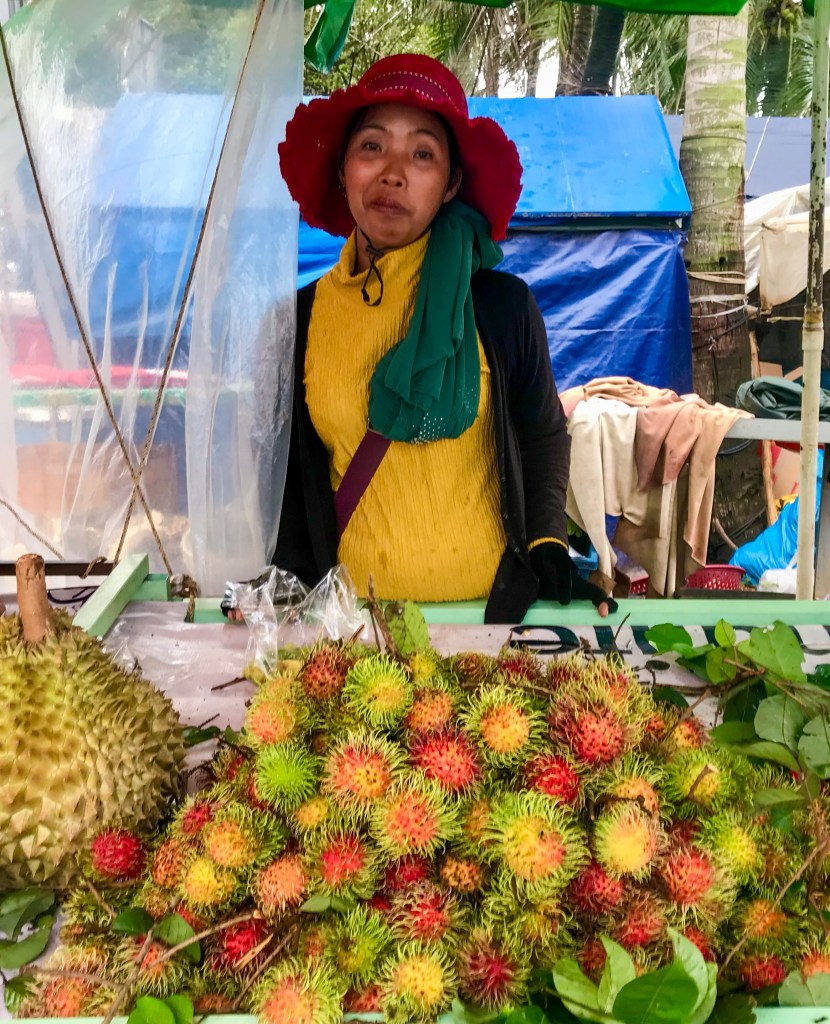
Island dreams
As I sucked the delicious meat from one claw after another, deftly avoiding bonelike shards of shell from sticking between my teeth (I mostly succeeded), I looked from my open-air table across the narrow beach to see a lofty island rising above the sea in the distance. This was Phu Quoc, an exquisite tropical resort island that is very much a part of Vietnam, but which actually lies closer to Cambodia.
I was fortunate to spend over a week on Phu Quoc in early 2021, a visit that I documented in blogs here and here. As the gull or tern fly, it’s only about 15 miles (24 km) to Phu Quoc from where I now sat. Currently, it takes a journey of over three hours from Kep, four hours from Kampot, by bus and ferry. But if a proposed speedboat shuttle service ever becomes a reality, the trip will require far less time … even if the land-sea border crossing is complicated by visa issues.

Spicy sojourn
Phu Quoc also has excellent seafood, as well as an acclaimed nước mắm (fish sauce) factory. But it doesn’t have Kampot peppers. As this spice is world-famous, why wouldn’t I be eating peppercorns with my pepper crab?
Here in the neighboring provinces of Kampot and Kep, in the quartz-rich soil at the foot of the 3,500-foot Elephant Mountains, pepper has been cultivated at least since the 13th Century — the halcyon days of the Angkor civilization. The slope provides perfect drainage for the kamchay (small leaf) and lampong (large leaf) vines, both of which may sprout long strands of green, black, white and red peppers, often from the same plant.
Plantation tours are a popular agritourism activity for visitors to Kampot. Tour guides show how the spice is planted, nurtured, harvested and eaten. It’s not alone, but I can recommend Paradise Gardens as one of the handful of farms that welcome visitors.
Should you require salt with your pepper, Kampot has that, too. Salt is harvested from shoreline mines and the sea itself, and spread on flat land to dry. You won’t miss the salt farms as you travel by tuk-tuk between Kampot and Kep, for example.
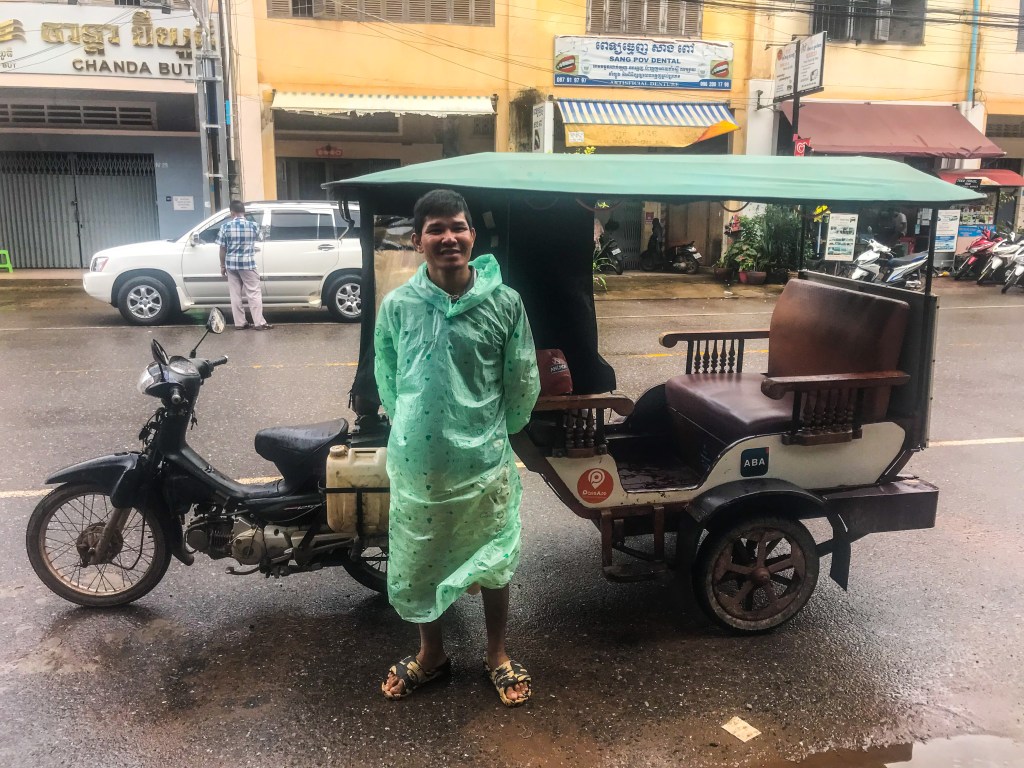
Colonial appeal
As throughout Cambodia and Thailand, tuk-tuk is the preferred form of local transportation in Kampot. There are plenty in service here, enough to get you through a couple of lazy days in Kampot, which is itself three hours (160km, or 100 miles) by express bus south of Phnom Penh.
Five km (3 miles) inland from the Gulf of Thailand on the wide and lazy Praek Tuek Chhu River, the former colonial market town itself is unremarkable, save for its well-preserved French architecture. For a brief time in the mid-19th Century, Kampot was Cambodia’s only international seaport. Atmospheric restaurants, bars and hotels look out upon the picturesque river; each end of its lone bridge is shaded by coconut palms.
The Old Market quarter was quiet at the time of my visit on the weekend of Cambodia’s national election — a “no-drinking” holiday loosely enforced to ensure that everyone went to the polls. Certainly, everyone who had cast their ballot had an inkpad-black index finger. (More than a couple of locals told me, though, that it didn’t really matter who they voted for. The same party has been in power for 38 years, and prime minister Hun Sen was simply planning to transfer his post to his son, Hun Manet.)
Between the girlie bars (closed for the holiday) and the excellent Indian restaurants (Simon’s Tandoor had the best navaratam korma I’ve found in Southeast Asia), I discovered an expat-owned new-and-used bookstore. I was delighted to snare the most recent “Jack Reacher” thriller: I had been unable to get it in Ho Chi Minh City!

Paradise found
Pending completion of a new highway to Kep, badly rutted red-dirt roads lead from town, past the pepper plantations and extensive rice fields, and through small villages. A couple of byways lead to Preah Monivong Bokor National Park, embracing a French hill station from the distant past, now abandoned and falling to ruin. Hikers can also enjoy caves, waterfalls and stunning mountain views. The forest is dense, the wildlife diverse (including bears, leopards, pangolins, macaques and gibbons) To the east there’s more panoramic hiking at Kep National Park. I’ll return with more time simply to go walking in the jungle.
I don’t often say this, but the highlight of my visit to Kampot was my accommodation. The unheralded Phoum Rumduol Bungalow was a little piece of heaven in a tranquil neighborhood just a couple of kilometers north of the night market. It’s quiet except for twice a day, when the Phnom Penh-to-Sihanoukville train comes through and stops across the street. But even the iron horse isn’t all that noisy.
Far from the noise of Saigon or even Phnom Penh, Phoum Rumduol was a true oasis. Although I was traveling alone, my private cabin (one of only nine) was extremely spacious, tastefully furnished and well-maintained. In the evening, I could sit on the porch and read or write. I was surrounded by a lush garden with orchids and a variety of other tropical flowers. I could enjoy a swimming pool and a tasty breakfast prepared by a genial English-speaking host. And best of all, during the rainy season, I paid just 64,000 Cambodian riel (US $16) a night.



Liberty doesn’t come without compromise and some “letting go.” On the day the USA celebrates its own freedom, the author leaves his past behind.
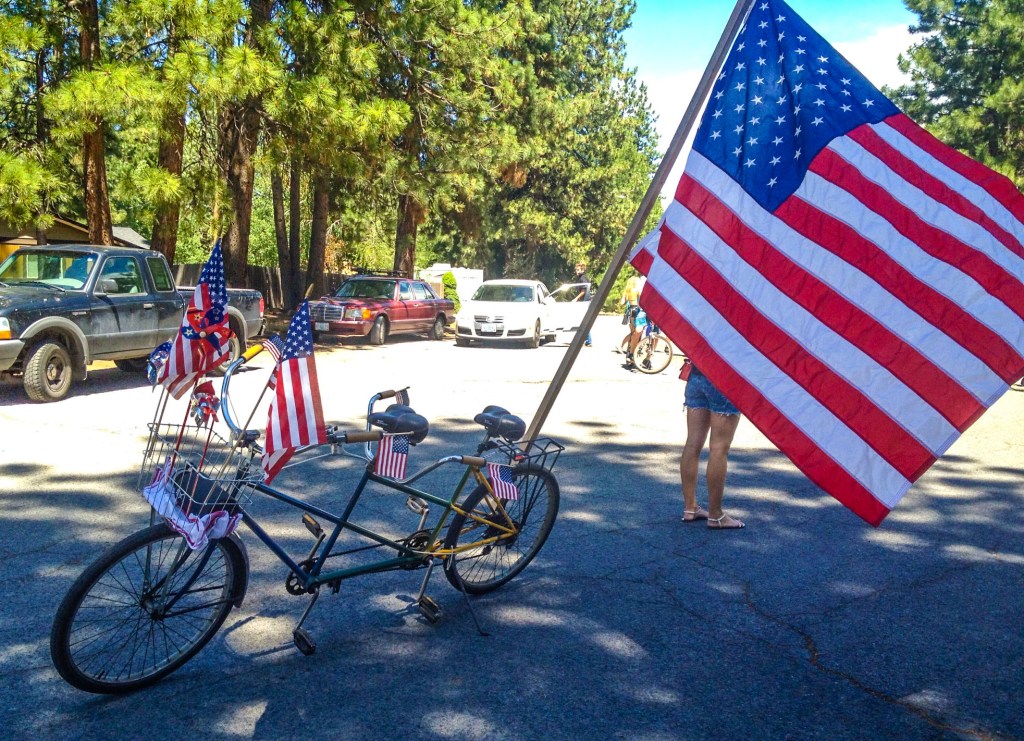
Today is July 4. In my native United States, it is a national holiday, Independence Day. On this date in 1776, the 13 original American colonies declared their freedom from England. When the Second Continental Congress ratified the Declaration of Independence, it established the United States of America.
Nearly every American today is decked out in red, white and blue. There’s lots of flag waving. Family barbecues. Other communities may have Animal House-style parades with floral floats and school bands — but Bend, Oregon, the city that I called home longer than any other, has a pet parade. It once had a bicycle “Freedom Ride” (perhaps it still does) until it got so popular that there was no freedom to ride. After dark, fireworks shoot from the summit of Pilot Butte, occasionally providing extra drama by igniting small fires in the dry grass.
For me, July 4, 2023, also represents freedom of a different kind. I have no need to celebrate. With huge help from my brother Fred, assisted by other friends, I have purged my storage locker. I have cut ties with personal history.
Am I feeling nostalgic? Absolutely. But there’s no room for sentimentality. My first 69 years are in the rear-view mirror. I’ll return to the U.S. for visits, to see friends and enjoy outdoor sports in my beloved Cascade Mountains, but not to live. Never say never, but I’m probably in Asia to stay.
Slowly but surely, by fits and starts, I’m creating a new life for myself here. The cost of living is manageable. My friendships are not based upon our politics. I’ve had to adjust my thinking to accommodate a very different culture, a different way of thinking; but I’ve always been willing to do so.

Purging a life
I suspected this would be the case. When I left Oregon in October 2019, just after my 69th birthday, I did so with a one-way ticket to Vietnam. I didn’t have a plan to return. Oh, I knew it was possible, so I rented a portion of my ex’s storage locker. I thought I had eliminated a lot in the weeks and months before my departure. I hadn’t rid myself of as much as I thought I had.
Family memorabilia, photographs and various knickknacks, were important to my siblings and I. But Fred and his family live in Japan, and my sister Lisa and her family have an unstable housing situation. So the keepsakes stayed in the locker for another 45 months.
As fortune would have it, Fred spent the past year on a visiting professorship at a university on the U.S. East Coast, following his retirement from teaching in Osaka. On his return home to Asia this week, he was able to pause in Oregon to collect those family memories and to share them with Lisa.
I asked him, while he was there, to get rid of the rest for me. He generously obliged. It was the great purge. The souvenirs I had collected from my childhood, my teen-age years, my early working life, my world travels as a young adult, book contracts, relationships and marriage were all here. There were memories of my parents and my son, all of them now gone.
I live from suitcases. I have no descendants since my son passed seven years ago. I have my sister, a few cousins, some dear friends … but were I to return, where would I go?
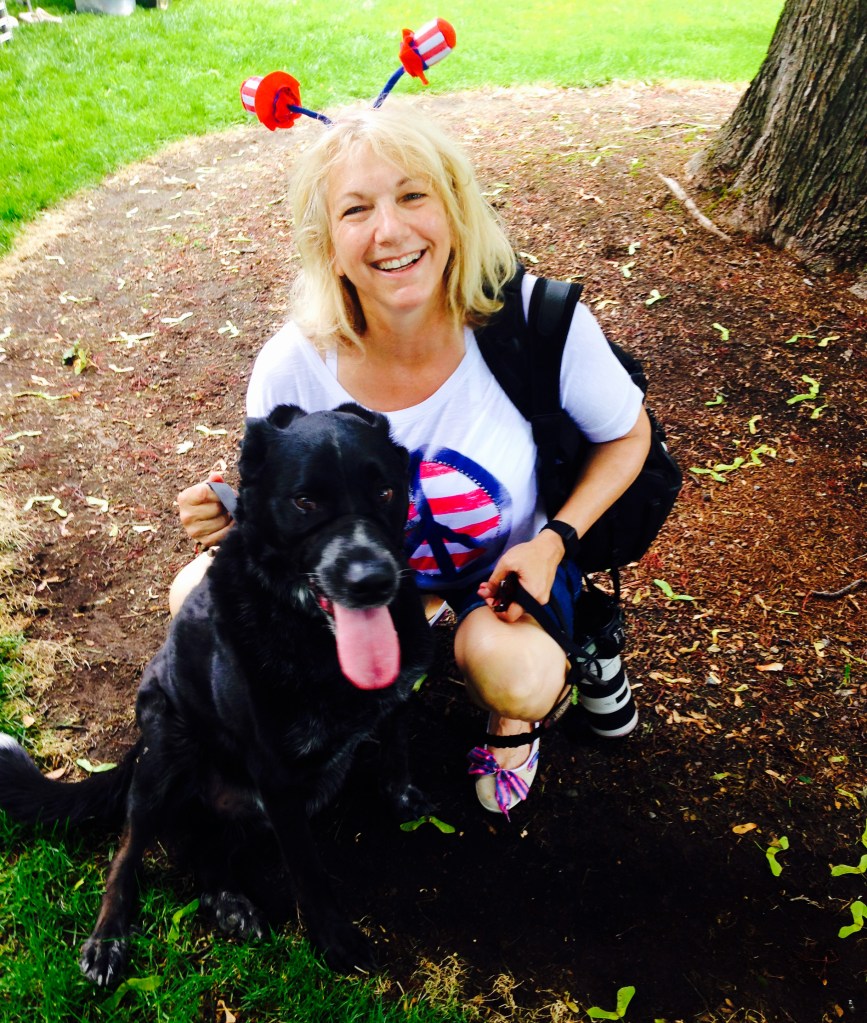
Be Here Now
Fifty-plus years ago, I was captivated by the teachings of Baba Ram Dass, the Harvard psychologist and cohort of Timothy Leary who became a guiding light for many young would-be hippies of my generation. After I met him in Hawaii, where he spoke to several dozen truth-seekers at an outdoor arena, I embraced him as my guru. His first book, Be Here Now, carrying heavy doses of Hindu-Buddhist belief, was the only one I toted in my backpack for three years during my first trip around the world in the mid-’70s. Here’s one particular lesson I remember (my paraphrase):
Think of yourself as an onion. Lots of layers beneath the skin, yes? And each layer represents a different “you,” a different way that you perceive yourself. So John can strip off his clothes and stand naked. Lookin’ good, man! But there’s more. There’s John the writer. Peel off that layer. It’s gone. There’s John the skier. Say goodbye! John the traveler, John the music lover, John the philosopher. Throw away those skins. There’s John the lover. Whoops, that’s a hard one. Hadn’t thought about giving that up, eh? Time to say, ‘Hasta la vista, baby.’ But hey, guess what. You’ve peeled off every layer, and there’s still something there. Hmm, you say. So who’s minding the shop? Take a close look: It’s still YOU.
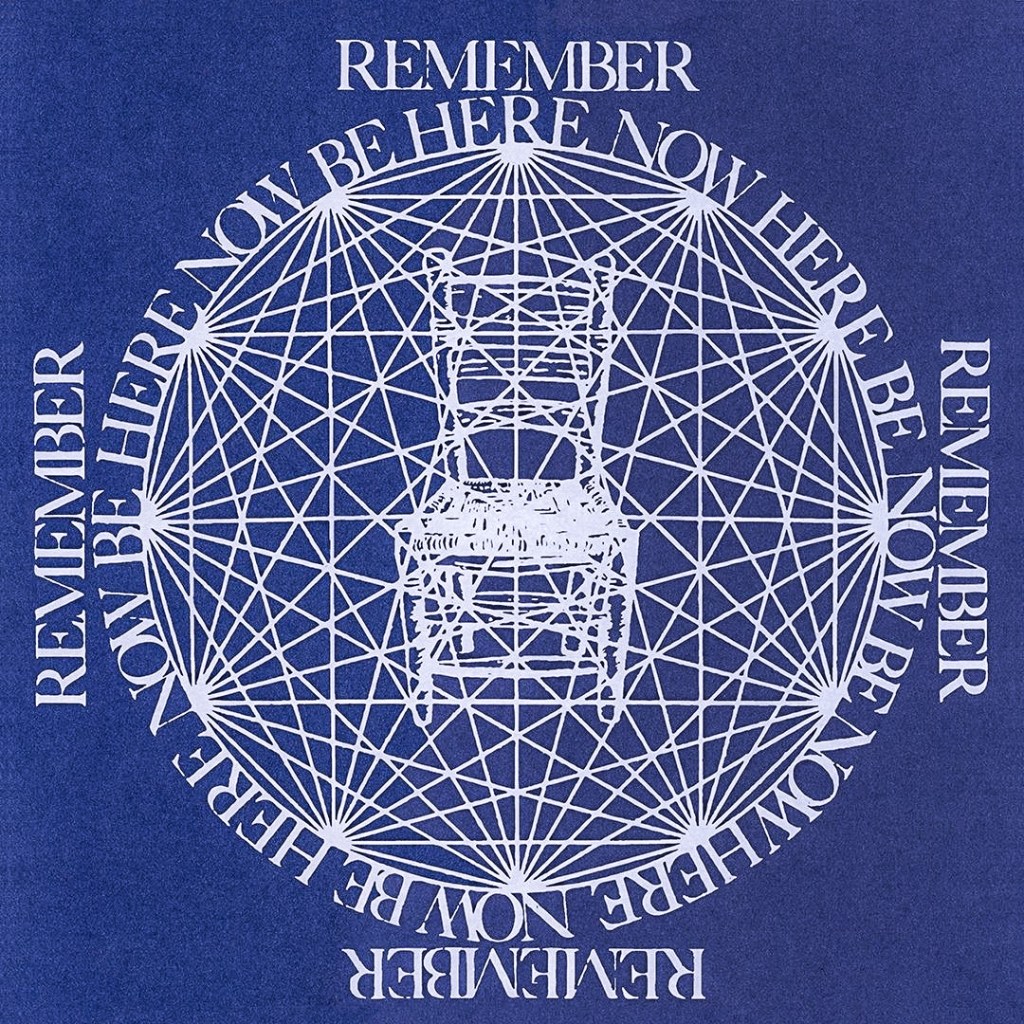
Stripping the past
These are some of the layers that I’ve stripped off and said goodbye to in the last few days:
* Copies of the books I’ve written, and everything I ever published in books, magazines and newspapers, starting with my mimeographed junior high-school newspaper, The Wilsonian.
* My stamp collection. Perhaps more than any other single thing, it was this that launched me into a career as a travel journalist. As a child, I studied each foreign stamp to learn something about the place it came from. I especially loved the pictorial issues with exotic African animals or stamps that recalled historical events. I learned something from them all.
* My mask collection, amassed during decades of travel on five continents.
* Old sports programs, magazines and press passes: I began my career in journalism as a sportswriter. Boxes of baseball cards. Sports equipment — skiing, fishing, tennis, golf, you name it.
* Some classic jazz records. Brubeck, Coltrane, Miles Davis, Pharaoh Sanders, to name but a few.

* Books and maps. My collections were heavy on Asia, philosophy and travel destinations, along with scores of paperback thrillers that were often my escape. I also loved maps, even in this era of GPS technology. As a child, I’d often spin the globe, close my eyes, put my finger on the orb, and imagine traveling there. By now, there’s a good chance I have been.
* Boy Scout memorabilia from the ’60s, including uniforms, neckerchiefs, merit badges and souvenirs from national and world jamborees that I attended.
* Clothes and more clothes. Old love letters in several languages. A number of framed and unframed paintings, including batik art I created in Java in 1976.
Preserve your memories
Many of these things have been welcomed to new homes. Others have been taken to the city dump or to the Goodwill store.
I’m especially grateful to my friend Kathleen who collected thousands of my 35mm slides with a promise to digitize what she’s able. Long before cell phones (and certainly before phones with built-in cameras), my best friend in my travels was my camera. Now, perhaps, I can keep my whole life on a thumb drive.
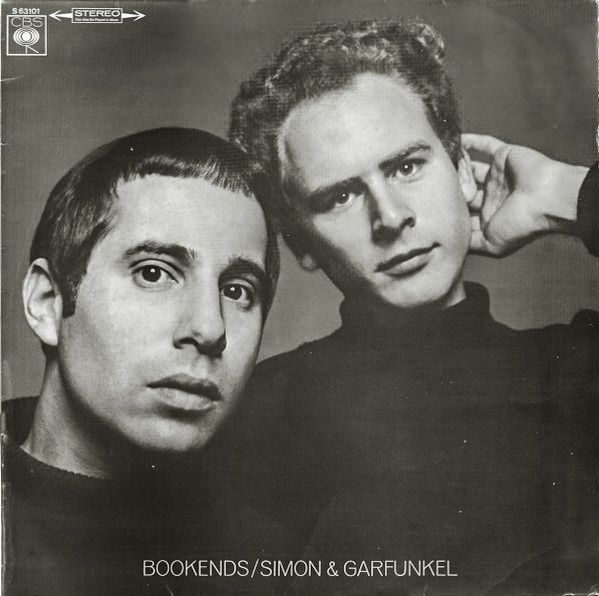
In the winter of 1969, as a student at the University of Oregon, I was fortunate to attend a concert by the effervescent folk-rock duo of that era, Simon and Garfunkel. It was one of the final dates of their “Bookends” tour. And as they left the stage that night in McArthur Court, they did so with a serenade that a 72-year-old man can understand far more clearly than an 18-year-old child:
Time it was / And what a time it was, it was
A time of innocence / A time of confidences
Long ago it must be / I have a photograph
Preserve your memories / They’re all that’s left you

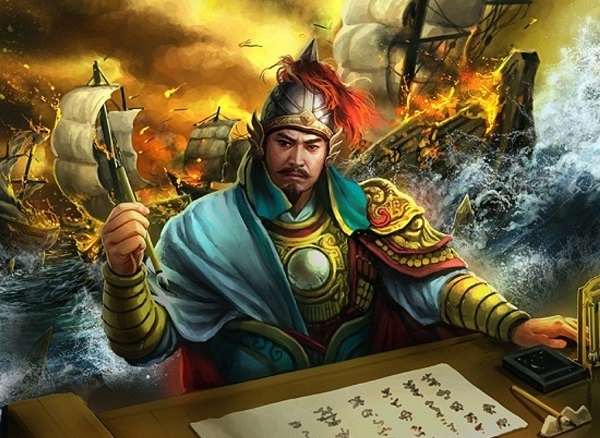
You don’t need a history book to learn something about Vietnam’s past. You’ll do just fine with a city map that encourages you to read the street signs.

City by city, district to district, Vietnamese street names are very much the same. They change with the government, of course. The current communist administration will never honor traitors to its cause, and many names used in the eras of French colonialism and South Vietnamese republicanism — those not commemorating ancient history — have been erased and replaced.
Many 20th-century martyrs and revolutionary leaders are now exalted on urban corners, along with historical figures who lived more than two millennia in the past. Places and events important to the regime in Hanoi are represented, as well.
What follows is a list of more than two dozen names that repeatedly appear throughout Vietnam, from Ho Chi Minh City to Haiphong, Nha Trang to Can Tho. The list by no means exhaustive. But it might perhaps be considered a starting point for further diving into the rich history of this Asian nation.

Bạch Đằng
A short but strategic river in northern Vietnam (near Ha Long Bay), famed as the site of three historical battles between the 10th and 13th centuries. Sharpened poles were hidden in the river to impale foreign naval ships and successfully drive away Chinese and Mongol invaders.
Bà Tháng Hai
The Third of February (3/2) is important to Vietnam for two reasons: In 1930, it was the day the Communist Party of Vietnam was founded in Hong Kong. Hô Chí Minh, then known as Nguyen Ai Quoc, was among the founding fathers. And on February 3, 1994, U.S. President Bill Clinton announced the lifting of the American embargo on Vietnam, a first step in reestablishing relations between the countries. Clinton is still highly esteemed by Vietnamese.
Cách Mạng Tháng Tám
The “August Revolution,” as it’s known in English, was launched in late August 1945 by the Hô Chí Minh-led Viet Minh armies against the empires of French Vietnam and Japan. Although the Việt Minh was supported by the Indochinese Communist Party, the movement was designed to appeal to a wider population than purely Marxist-Leninist ideals could command.

Điện Biên Phủ
Now a city of 150,000, Điện Biên Phủ’s name is synonymous with the 1954 siege and battle that put an end to the French colonization of Vietnam. After World War II, when Japan occupied Indochina, France failed to regain control of its lucrative opium trade in Vietnam’s northwest. Việt Minh sympathizers, who were growing rice here, rebelled when France tried to take the land back. That set the stage for a 57-day siege of the garrison, March 13 to May 7, 1954. The consequent Viet Minh victory led to the Geneva accords, partitioning Vietnam into North and South.
Đinh Tiên Hoàng
The founding emperor of the short-lived Dinh dynasty, Hoàng (also known as Đinh Bộ Lĩnh, 924–979) defeated a dozen other warlords, declared independence from China’s Southern Han dynasty, and became the first emperor of a unified Vietnam in 968. He renamed the country Đại Cồ Việt.
Đồng Khởi
The name means “Uprise Together.” A Viet Minh-inspired movement active in 1959 and 1960, it urged farmers and other rural Vietnamese to revolt against the South Vietnamese government and its American advisors. That led to the disintegration of federal control in the Mekong Delta and parts of the Central Highlands, and to the establishment of the National Liberation Front.
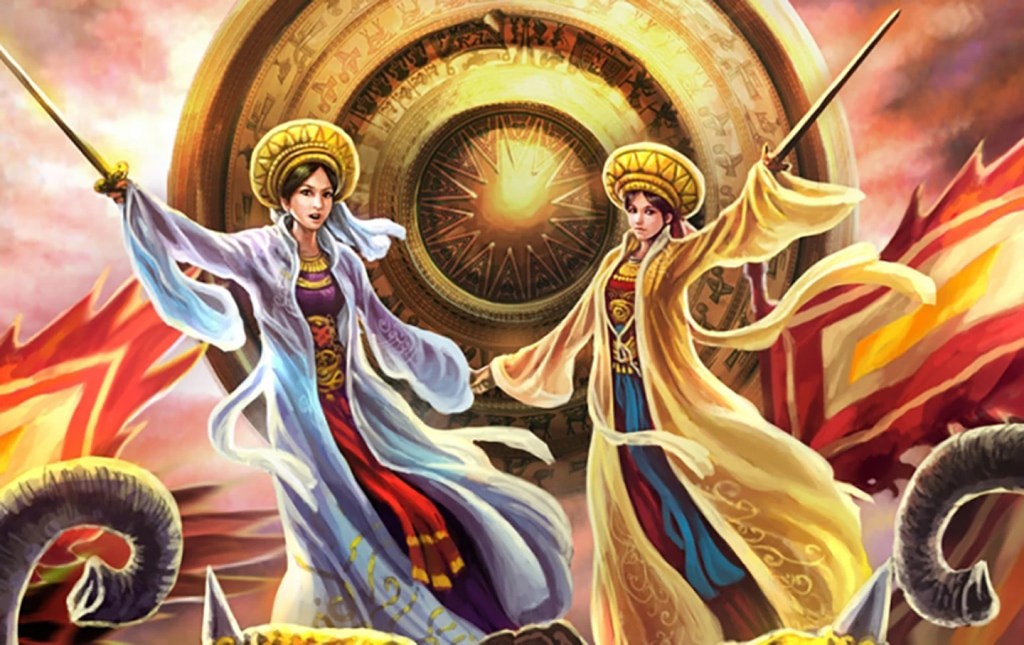
Hai Bà Trưng
No women in Vietnamese history are more famous than the Trưng sisters, heroines who continue to capture the national imagination 2,000 years after they lived. Trưng Trắc, Vietnam’s first female ruler, and Trưng Nhị, her younger sister, rallied armies against the controlling forces of China’s Han dynasty and reigned for three years — until the Han emperor sent 20,000 troops after the young women, still in their late 20s. Rather than allow themselves to be captured, they threw themselves into the Sung River and drowned.
Hùng Vương
The “Hung Kings” were the legendary monarchs of the Lac Viet people of the Vietnamese-Chinese kingdom of Van Lang. They used magic to control the diverse tribes between 2879 and 258 B.C., also known as the Hồng Bàng era. Since the 15th century A.D., they have been regarded as national ancestors, with a national holiday honoring them in mid- to late April.
Lê Duẩn
Born Lê Văn Nhuận (1907-1986), he led Vietnam in the two decades following the decline and death of Hồ Chí Minh (in 1969). As general secretary of the Central Committee of the Communist Party, Lê Duẩn continued Hồ’s policy of ruling through collective leadership
Lê Lợi
Also known as Lê Thái Tổ (1384-1433), he became the first emperor of the restored kingdom of Đại Việt. From 1418 to 1427, he and his followers rose up against Ming dynasty rule, using guerrilla tactics in the Lam Sơn Uprising.
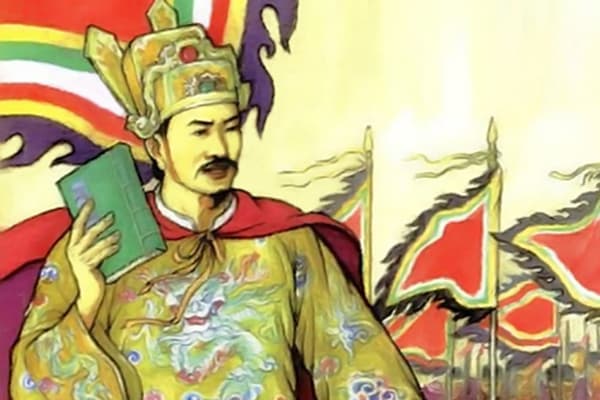
Lê Thánh Tông
Considered one of Vietnam’s greatest emperors, Tông ruled Đại Việt from a 1460 coup d’état, when he was 18, to his death in 1497, the longest reign of the Later Lê dynasty. He is credited with many administrative, military, educational and fiscal reforms, conquests of Champa states in the south, and a cultural revolution that replaced the old aristocracy with a generation of scholars.
Lý Thái Tổ
The founding emperor of the Lý Dynasty, Tổ (974-1028), reigned from 1009 until his death in 1028. Although the dynasty lasted until 1225, he is best remembered for establishing his capital at modern Hanoi. (The city celebrated its 1000th birthday in 2010.) He named it Thang Long because, legend says, he dreamt of dragons flying as he entered the city.

Lý Thường Kiệt
Kiệt (1019–1105) was a Lý dynasty military leader who served three emperors. He invaded Champa (1069) and defeated the Song invasion of Vietnam in the late 11th century.
Lý Tự Trọng
A Vietnamese revolutionary executed by the French in 1931 when he was 17 years old: During a nationalist speech in Saigon, he had fired a gun at French secret police. His martyrdom was seen as symbolic of French brutality. On Lý Tự Trọng street in Ho Chi Minh City is the former USAID building, famous for the helicopter evacuation of U.S government employees during the Fall of Saigon in 1975.
Ngô Quyền
Quyền (898-944) first achieved widespread fame as an admiral in 938, when he defeated the Southern Han dynasty at the Battle of Bạch Đằng River (see above). The battle ended more than 1,000 years of Chinese rule over Vietnam dating back to 111 BC. He subsequently founded the Ngô dynasty and reigned until 944.
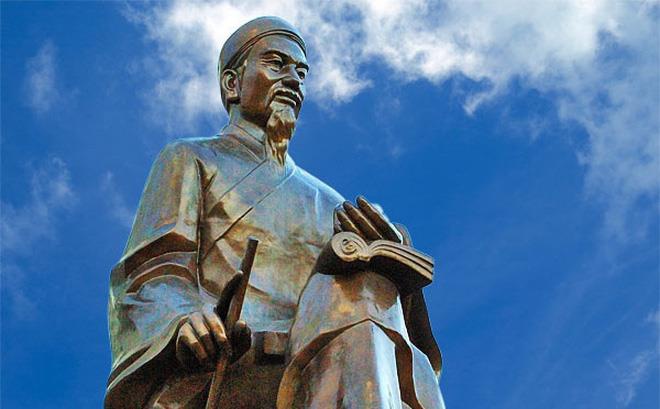
Nguyễn Bỉnh Khiêm
A Confucianist civil servant (1491-1585) whose sage advice to opposing political leaders led to a peaceful division of Vietnam that lasted for 200 years, Khiêm was thereafter seen as a Nostradamus-like prophet. He predicted the creation of the Vietnamese nation before the name Việt Nam had ever been coined. In the 20th century, he was posthumously embraced as an avatar of the Cao Dai religion and a saint of the new School of Teaching Goodness.
Nguyễn Đình Chiểu
A poet known for his nationalist and writings against the French colonization of Cochinchina (southern Vietnam). Chiểu (1822–1888) wrote the epic poem Lục Vân Tiên, one of the most celebrated works of Vietnamese literature.
Nguyễn Du
No other piece of Viet literature is as famous as The Tale of Kiều (Truyện Kiều), an epic poem of 3,254 verses written by Nguyễn Du (1765–1820). A story of lovers forced apart by the girl’s loyalty to family honor, it recounts the trials of Thúy Kiều, a beautiful young woman who sells herself into marriage with an older man to save her father and younger brother from prison. Sadly, her husband coerces her into a life of prostitution.

Nguyễn Huệ
Nguyễn Huệ (1753-92) and his two brothers were the leaders of the Tây Sơn rebellion. They overthrew the Later Lê dynasty, ended a war between the feudal houses of Nguyễn in the south and Trịnh in the north, repelled an attack by China’s Qing empire, and united Vietnam for the first time in 200 years. Installed as Emperor Quang Trung in 1788, Huệ planned to march south to destroy the remnant Nguyễn army. But he died young and his successors were defeated by Nguyễn Ánh, who established the Nguyễn dynasty in 1802.
Nguyễn Thị Minh Khai
In 1927, at the age of 17, co-founded the New Revolutionary Party of Vietnam, a predecessor of the Communist Party. Assigned as a secretary to Hô Chí Minh in Hong Kong in 1930, she was imprisoned for three years for revolutionary activity. She returned to Vietnam in 1936 and became the top communist leader in Saigon. Arrested by the French in 1940, she was executed by firing squad the next year, together with fellow revolutionaries Võ Văn Tần and Nguyễn Văn Cừ.
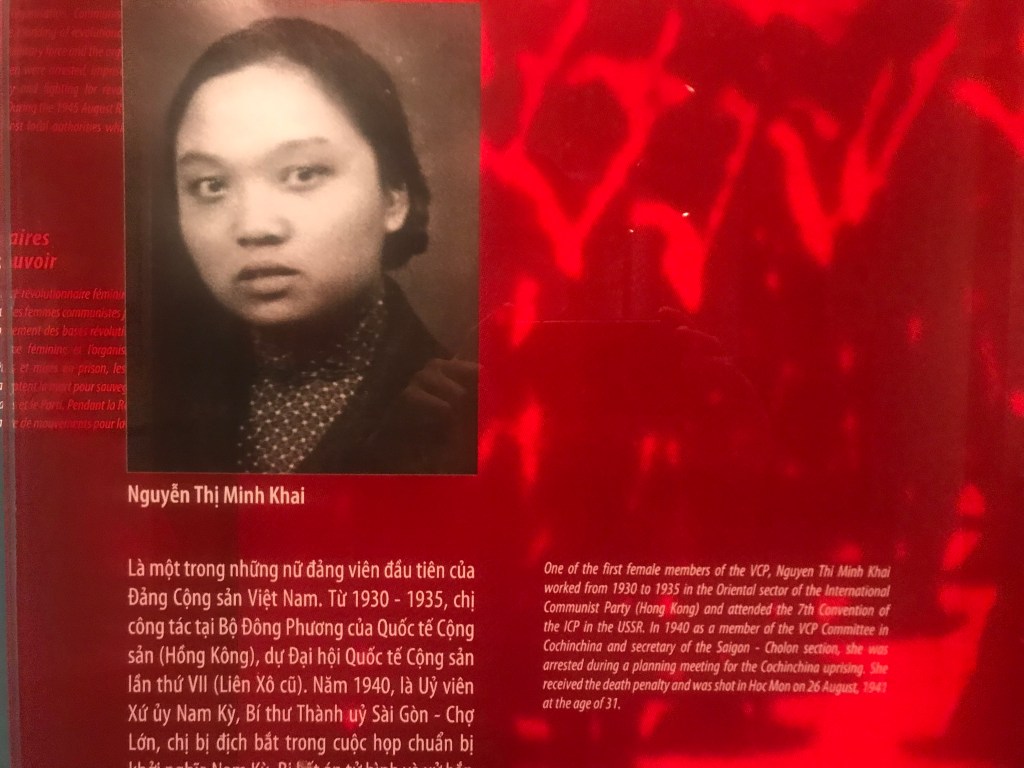
Pasteur Institute
The few remaining French names on Vietnam streets owe their existence to the achievements of the Pasteur Institute. To manage hygiene and epidemics in southern Vietnam, it was established in Saigon in 1891 by immunologist Albert Calmette (1863-1933), famed for his snakebite antivenom and tuberculosis vaccine.
Another Pasteur physician was Alexandre Yersin (1863-1943), who co-discovered the bacillus responsible for the bubonic plague and proved that it could be transmitted from rodents to humans. He built a laboratory at Nha Trang to manufacture the vaccine and helped to establish the hill town of Da Lat (where a university bears his name) and the Ha Noi Medical University. He farmed both rubber and quinine trees imported from South America, the latter for their anti-malarial qualities. Throughout Vietnam, there are Pasteur, Calmette and Yersin streets in many locations, and Yersin’s house in Nha Trang is now a museum.

Phan Bội Châu
For 20 years in Japan and China, Châu (1867-1940) was an outspoken critic of French colonial rule, writing political tracts that called for the independence of Vietnam. In China he formed the Việt Nam Quang Phục Hội (“Vietnamese Restoration League”), modeled after Sun Yat-sen’s republican party. French agents arrested him in Shanghai in 1925 and convicted him of treason. He spent the rest of his life under house arrest in Huế.
Tôn Đức Thắng
As Hô Chí Minh’s successor, Thắng (1888-1980) was the last President of the Democratic Republic of Vietnam (1969-76) and the first President of the new Socialist Republic of Vietnam (1976-80).
Trần Hưng Đạo
Hưng Đạo (1231–1300) was an imperial prince and military commander during the Trần dynasty. He commanded the armies that in the late 13th century repelled two major Mongol invasions by the Yuan dynasty under Kublai Khan. These are considered among the greatest military feats in Vietnamese history. Today he is conferred god-like status at Taoist shrines.

Trần Phú
The first general secretary of the Indochinese Communist Party. Trần Phú (1904-31) studied in China and Moscow before returning to Vietnam in 1930. A year later, while editing Theses on the bourgeois revolution of civil rights, he was arrested by the French. He was executed five months later.
Võ Văn Kiệt
The prime minister of Vietnam from 1991 to 1997, Kiệt (1922–2008) is best remembered for his promotion of the nation’s Đổi mới (“innovation”) economic reforms of the 1980s and ‘90s. Designed to create a “socialist-oriented market economy,” they enabled private ownership of businesses and helped to accelerate Vietnam’s return to the world market after decades of war isolation.
Võ Thị Sáu
This teen-age rebel with a cause has a cult following in the Côn Đảo Islands. A guerrilla fighter, she was the first woman to be executed (by firing squad) at Côn Sơn Prison in 1952, age 19. Devotees shower her her grave on Côn Sơn Island with flowers to remember her as an ancestral spirit.




Subscribe to get access to the rest of this post and other subscriber-only content.
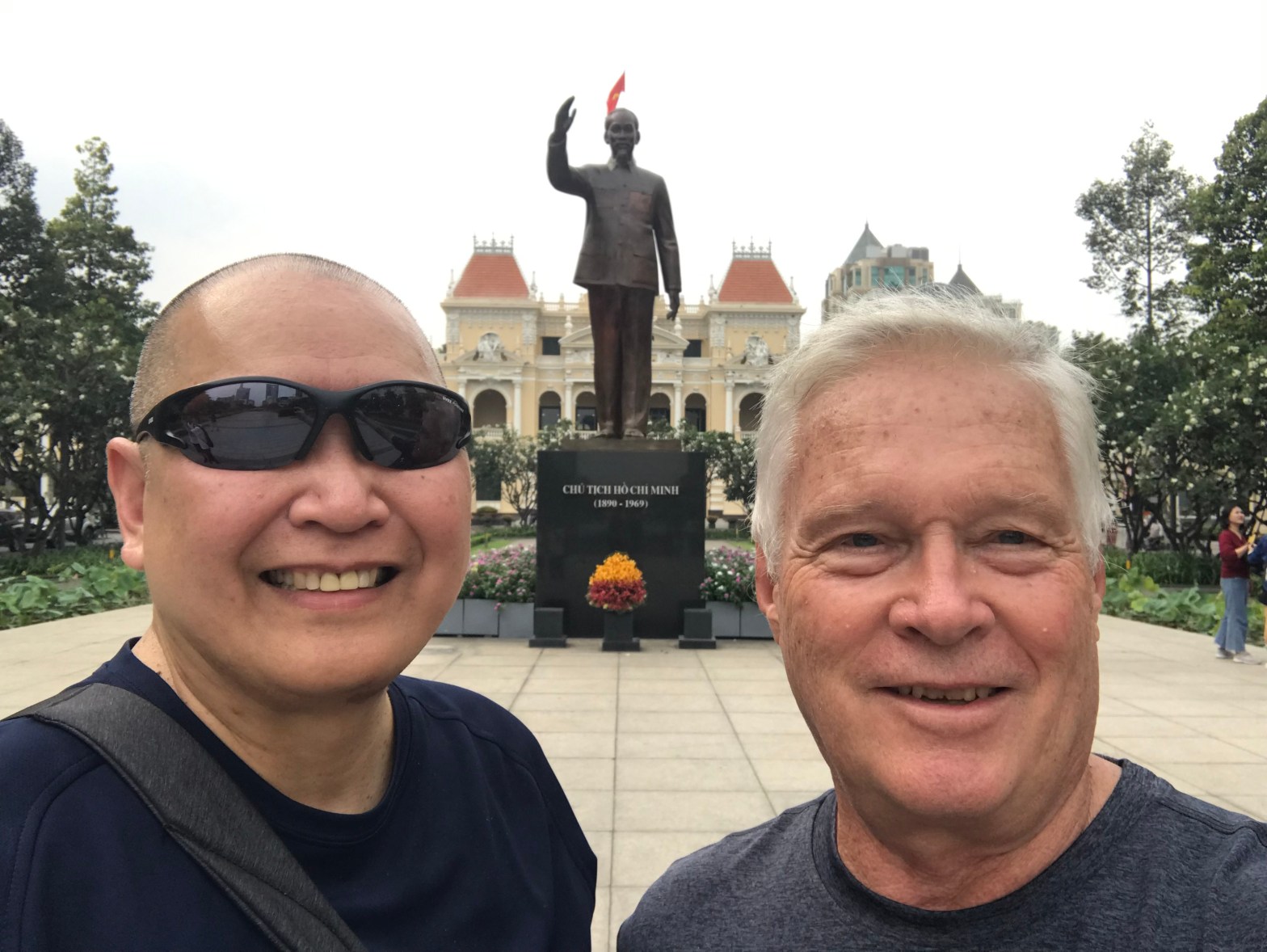
Twenty-four years after its publication, a book by a visiting Viet Kieu — an overseas Vietnamese — suggests the culture hasn’t changed much in the subsequent generation.

I have been living in Vietnam for 3½ years now. The cultural challenges that I face on a daily basis haven’t diminished. Those that at first seemed daunting may now appear less so, but others are more evident. And judging from what a Vietnamese American man wrote more than two decades ago, I shouldn’t expect otherwise.
Known as Pham Xuan An when, as a child in the late 1970s, he escaped as a boat person, this author returned in 1997 as Andrew X. Pham. His book — Catfish and Mandala: A Two-Wheeled Voyage Through the Landscape and Memory of Vietnam — was published in 1999 by Farrar, Straus and Giroux.
Pham was struggling with self-identity, like many Asian Americans of his generation. Armed with a college degree but no real profession, he would often leave his California home on extended solo bicycling trips. His parents struggled unsuccessfully to understand him, and they were even more frustrated and baffled by his gender-challenged siblings.
When Pham returned to the country of his birth, he quickly realized it wasn’t the place he thought he left. To start, he was not accepted as Vietnamese. He was now labeled as a “Viet Kieu,” an overseas Vietnamese, and his Americanized lifestyle — from clothing and diet to accent and simple mannerisms — immediately told Vietnamese that “he’s not one of us.”
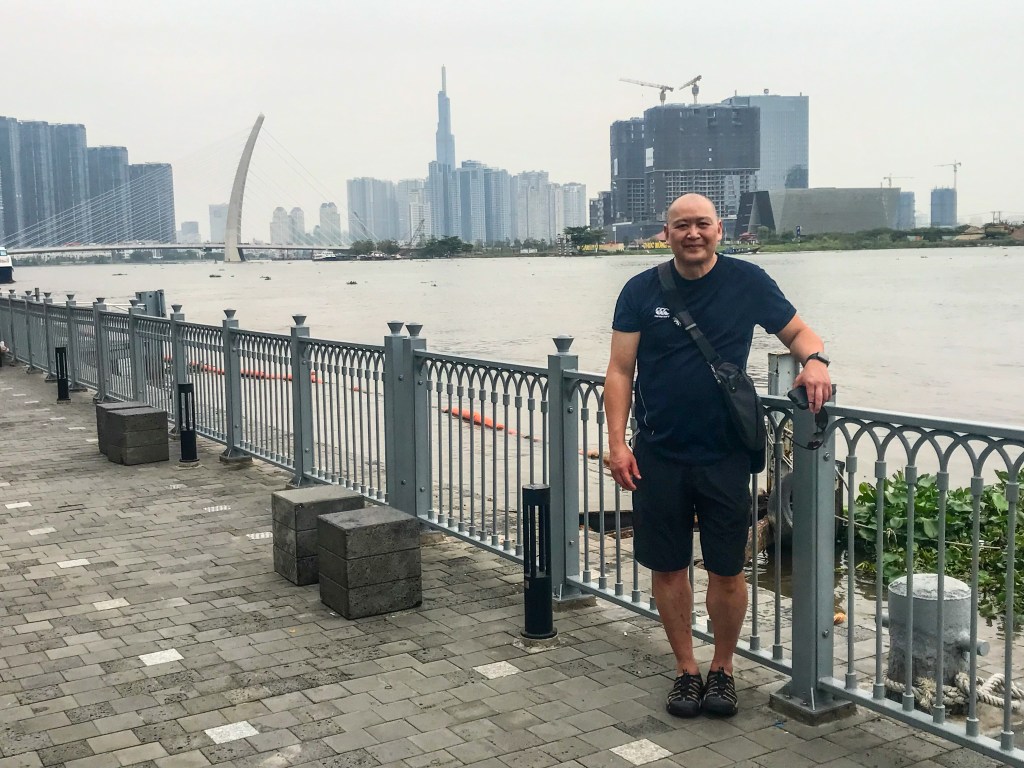
Fresh off the boat
I shared Catfish and Mandala with Vin Vu.
Like Pham An, Vin is a Vietnam-born American. Like Pham, he left the country of his birth as a youth, albeit a couple of years earlier. When he was 12, his family of 11 boarded an empty cargo freighter in the Saigon River to flee the “reunification” of Vietnam. It was April 30, 1975, and the passenger load of 2,000 refugees became known as the original “boat people” of the Vietnam War. Eight months later, after stops in Singapore, Subic Bay (Philippines) and Wake Island, they disembarked ion San Diego.
The Vu family never looked back. Vin’s father found a job and a family home in Spokane, Washington, and there Vin has remained for 48 years, never leaving. Until now, that is, in his 60th year.
I was privileged to play a small part in that experience. With a mutual writer friend in America as the go-between, I welcomed Vin to his boyhood domicile on the afternoon of his arrival at Ho Chi Minh City’s Tan Son Nhat International Airport. We walked to the gates of Independence Palace, which North Vietnamese Army tanks had crashed as his freighter floated down the river, and to the Nôtre-Dame Cathedral, where his parents had often celebrated Catholic Mass. We passed the central statue of Hô Chi Mính, founder of the modern Vietnamese communist state, en route to the precise platform on the Saigon River from which he had departed Vietnam in 1975. After a proper Vietnamese dinner, he called it a night.
Vin was on an independent one-week tour. The following day he went searching for some childhood memories, then continued to Da Nang and Hanoi before returning to Washington state. I wonder if some of his experiences matched those of Andrew Pham.
‘Smile and lie’
What did Pham discover? First and foremost, perhaps, he learned that, in Vietnam, anything goes. “Vietnamese have a saying,” he writes: “‘A thousand years of Chinese rule, a hundred years of French subjugation, and ten years of American domination, but we survived, unified.’ Survive. That’s the word. Survive at any cost.”
I get it. Survival justifies everything — the petty and not-so-petty corruption, the obsession with capital gain at the sacrifice of human dignity, the lack of awareness of basic courtesy, the ability to only hear what they want to hear.
There’s another common saying here: “Smile and lie.” Don’t let the other guy know what you’re thinking. Pham admitted to being awkward with Eastern sensibilities, so: “I lie — the typical (and acceptable) Vietnamese thing to do.”
“My Saigon was a whore, a saint, an infanticidal maniac,” he confessed. “She sold her body to any taker, dreams of a better future, visions turned inward, eyes to the sky of the skyscrapers foreign to the land, away from the festering sores at her feet. The bastards in her belly — tainted by war, pardoned by need, obscured by time — clamored for food. They laughed, for it is all they know.”
And this: “Sometimes it is as though every Vietnamese is seeking a godfather, a sugar daddy, a saint. In the stark neediness of their lives, dignity doesn’t ride shotgun to opportunism. But again they learned to separate both eons ago.”

‘A barbarous joy’
Pham writes about many things with which I easily identify. His family home, in an urban alley, “is narrow and long, … a two-floor cell block, each residence sealed with a massive sliding steel door of mesh wire and bars.” That description could very nearly apply to my last three apartment residences in Ho Chi Minh City.
His description of traffic is as true today as it was 25 years ago: “Nobody gives way to anybody. Everyone just angles, points, dives directly toward his destination, pretending it ís an all-or-nothing gamble. People glare at one another and fight for manuevering space. All parties are equally determined to get the right-of-way — insist on it. They swerve away at the last possible moment, giving scant inches to spare. The victor goes forward, no time for a victory grin, already engaging in another contest of will. Saigon traffic is Vietnamese life, a continuous charade of posturing, bluffing, fast moves, tenacity and surrenders.”
Pham’s ultimate description of Saigon sounds like P.J. O’Rourke’s Holidays in Hell, and I, for the most part, find it hard to disagree: The city “is a collage, a vanishing flavor, a poison, a metallic tinge, a barbarous joy, strange impressions unconvictable in usual ways.”
It’s all true. This is the Saigon where I live today, in 2023. And why do I live here? Because in spite of its severe warts, it is unrelentingly fascinating.
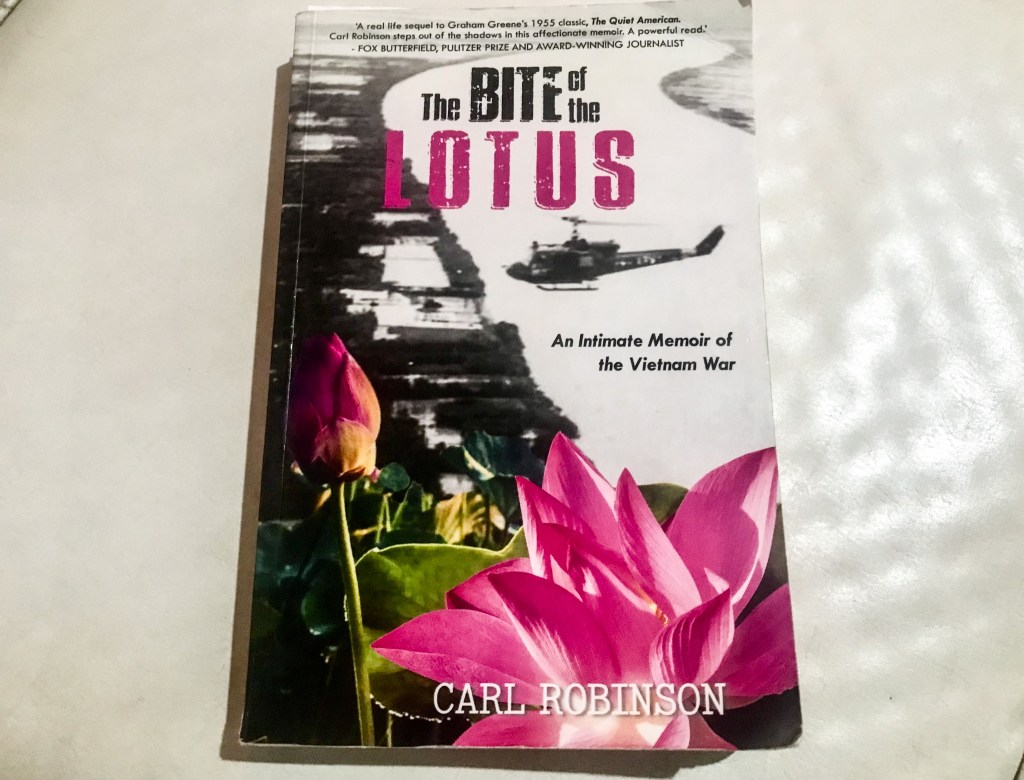
The Bite of the Lotus
I have one other friend who departed Vietnam in 1975, and who also wrote about it.
Carl Robinson was a green-at-the-gills 21-year-old college student when he arrived in Vietnam in 1964 and found work with the US Agency for International Development (USAID). By the time he was ordered to leave (one day before Vin Vu), he was 32, an Associated Press war correspondent and photo editor, a married father of two, and a heroin and opium addict. He shared the sometimes-harrowing details in his memoir The Bite of the Lotus. (First published in 2019 by Wilkinson Publishing in Australia, it is now undergoing revision.)
Robinson’s Saigon experiences were, naturally, very different from those of his younger Vietnamese counterparts. Pham’s and Vu’s memories were those of children; Carl was older, an (arguably) mature adult. Eternally disillusioned with U.S. policy, he shared wartime Vietnam with writers and photojournalists like David Halberstam, Peter Arnett, John Steinbeck IV and Sean Flynn, the estranged son of actor Errol Flynn who disappeared on a motorbike trip in Cambodia in 1970.
Carl did not return to the United States to live; instead, he and his family settled in Australia, where they reside today. He will turn 80 this fall. But he and Kim-Dung, his wife of 54 years, return at least annually to Ho Chi Minh City and the adjacent Mekong Delta region, where she was raised.



Adventurous Khmer cuisine provides an unexpected introduction to the gateway city of Siem Reap and the ruins of Angkor.
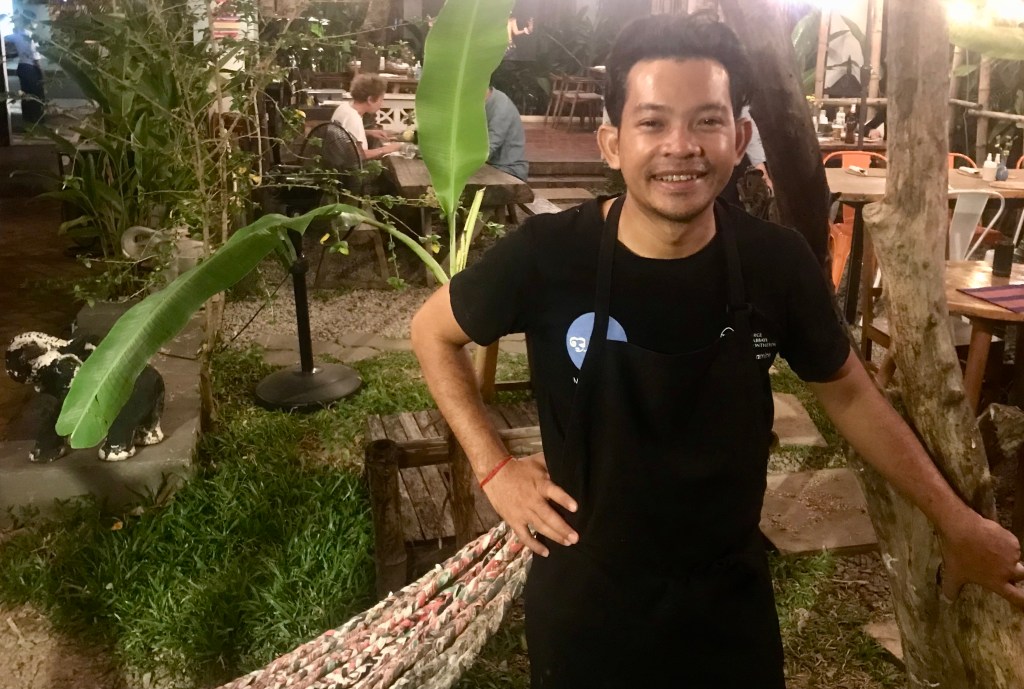
Savory red ants. Grilled beehive salad. Padi crab smashed in coconut broth. Pork sausage with peanuts and mung beans. What’s not to like when you’re dining with Chef Mengly in Siem Reap, Cambodia’s second city?
Mork Mengly, 33, is the owner and executive chef at POU Restaurant, an open-air oasis of casual fine dining on Wat Bo Road, a short tuk tuk ride from the urban center. Together with his wife, who runs the front of the house (sometimes assisted by their two young children), and an enthusiastic team of servers and cooks, the young chef has captured the hearts and palates of tourists and locals alike.
Mengly couples his own creativity with time-tested family recipes and a gentle ambience reflective of Cambodian nature. I found my way here on the recommendation of my friend Jeff Hunt, an American chef who travels the world to find unique dishes worthy of his own kitchen. Here, he found a culinary gold mine.

Before my visit to POU, I was already impressed by Cambodian cuisine. The flavors of traditional plates like fish amok (a steamed coconut-cream curry) and beef lok lak (“shaking beef,” sauteed with vegetables) are as ubiquitous in this country as are noodle soups in neighboring Vietnam. These of course appear on Mengly’s menu, though disguised as catfish curry with sugar palm and egg, and chunks of beef marinated in a pepper lime sauce.
Following Hunt’s suggestion, I ask Mengly simply to cook for me. This is what he makes:


Gateway city
Siem Reap, with a population of around a quarter million, is the gateway city to Cambodia’s internationally renowned tourist attraction, the ancient ruins of Angkor Wat. Siem Reap has a sort of fading French colonial-era charm, even as Chinese investment in the hospitality and transportation sectors is steadily on the rise. As a tourism hub, it has scores of comfortable lodgings to complement dining and nightlife options.
I enjoy late afternoons beside the Tonlé Sap River, a sleepy stream not much wider than an irrigation canal. From my sunlit stool at the Scribe Bar on Pokambor Avenue, I gaze at a park strip and watch the human traffic — walkers, joggers, bicyclists, none of the frantic motorists I’ve become accustomed to Ho Chi Minh City — follow the flow of the river southward through the city toward the Great Lake (the Tonlé Sap) and, eventually, the Mekong River.

I finish my chilled chardonnay, easier to find in this Francophile city than in beer-happy Saigon, and join the promenade. More than a dozen colorfully lit bridges, some for pedestrians only, add personality. I pass a long stretch of street-food stalls along the riverbank, then cross to the Psar Chaa, the Old Market, where a cluster of vendors sell everything from gaudy wardrobe additions to tourist-ready Buddha images, day and night.
Unlike most Asian countries, Cambodia accepts American dollars as readily as it does its own currency, the riel. Indeed, nearly every ATM machine dispenses U.S. cash at a rate of 4,000 riel to the dollar.
Angelina’s shadow
I pass through the Old Market corner to corner and find myself on Pub Street, at the heart of Siem Reap. Only about two blocks long, not counting a matrix of narrow cross-passages linking to The Lane and The Alley, Pub Street is the hub of visitor activity in the twilight and evening hours.
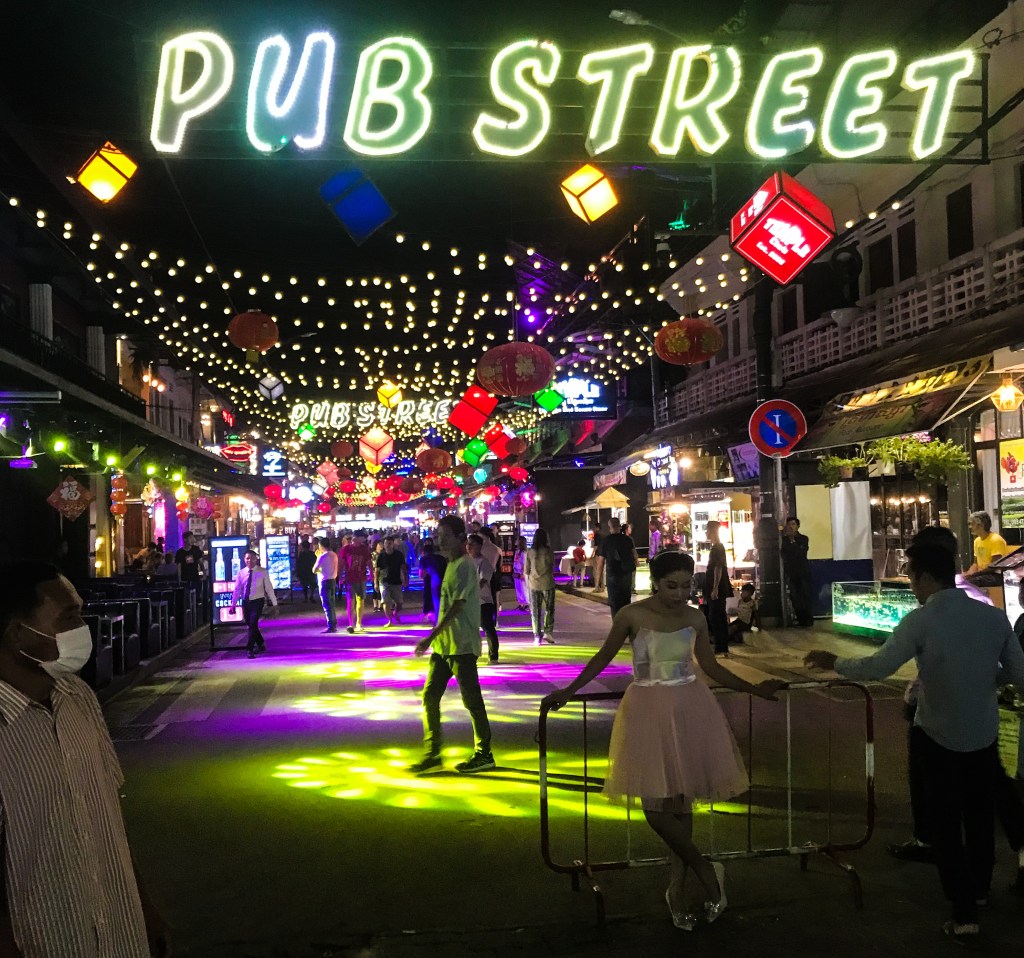
With its bright lights and colored streamers, Pub Street is impossible to miss. The Red Piano and the Temple Club, which face one another at the intersection of Street 11, are at the center of the action; both start the evening as restaurants but shift their emphasis to alcohol as the night progresses. (Angelina Jolie was said to have been a regular at the Piano when she was filming Lara Croft: Tomb Raider in 2000.) Nearby is Angkor WHAT?, a local institution for 25 years.
I see plenty of street food to shock tourists (think scorpions and tarantulas) and more fried ice-cream stalls than I can count. But the restaurant food is good. On different nights, I enjoy freshly grilled seafood at the K.R. Kitchen, Sri Lankan food at Serendib, and enchiladas at Viva! Mexican and Khmer Cuisine (a combination I didn’t believe possible).
At the end of an evening, I can count on finding a tuk tuk driver to return me to my lodging. The motorized three-wheelers are often customized to reflect their owner’s individual exuberance.

Taking in the sights
Aside from Angkor Wat and the Angkor ruins, which cannot be properly appreciated in fewer than three days, there are at least three other essential sites for visitors to Siem Reap, all of them within the city itself.
First is the elegant Angkor National Museum, north of the gracious Royal Residence and the stately Raffles Grand Hotel d’Angkor. After my first-day survey of the grounds of ancient Angkor, I made a point to stop at the museum before returning for a second and third day. It proved to be an astute choice. The museum lays out the historical arc of the Angkor civilization: its precursors, its demise, the kings who directed its fortunes, including the 12th-century turn from Hinduism to Buddhism. Detailed explanation of inscriptions and bas-relief artworks enhanced my understanding, and the Gallery of One Thousand Buddhas displays more icons of the revered spiritual teacher than I’ve seen in any one place before.

As a lover of traditional cultural arts and crafts, I also thoroughly appreciated my visit to Artisans d’Angkor. Designed as a school for artisans, Les Chantiers Écoles teaches job skills to young and not-so-young Cambodians. Free guided or self-guided tours lead through a series of workshops where apprentices study wood- and stone-carving, silk weaving and painting, lacquerware production, and other arts that can produce a reasonable profit in today’s tourist economy.
Of several memorable Buddhist pagodas in Siem Reap, my favorite is Wat Preah Prom Rath, which faces the Tonle Sap River a few hundred meters north of the Old Market. Neither as historic nor as elegant as others, it nonetheless has a sort of pop culture appeal. Cartoon-like murals on gallery walls tell the life story of Prince Gautama Siddhartha, who became the Buddha (the “Enlightened One”) in the 6th Century B.C. Outside, life-size replicas depict some of the chapters illustrated inside, such as the young prince’s discovery of human misery outside the palace walls. Another reproduction recalls a 15th-century monk’s frequent travels by boat.
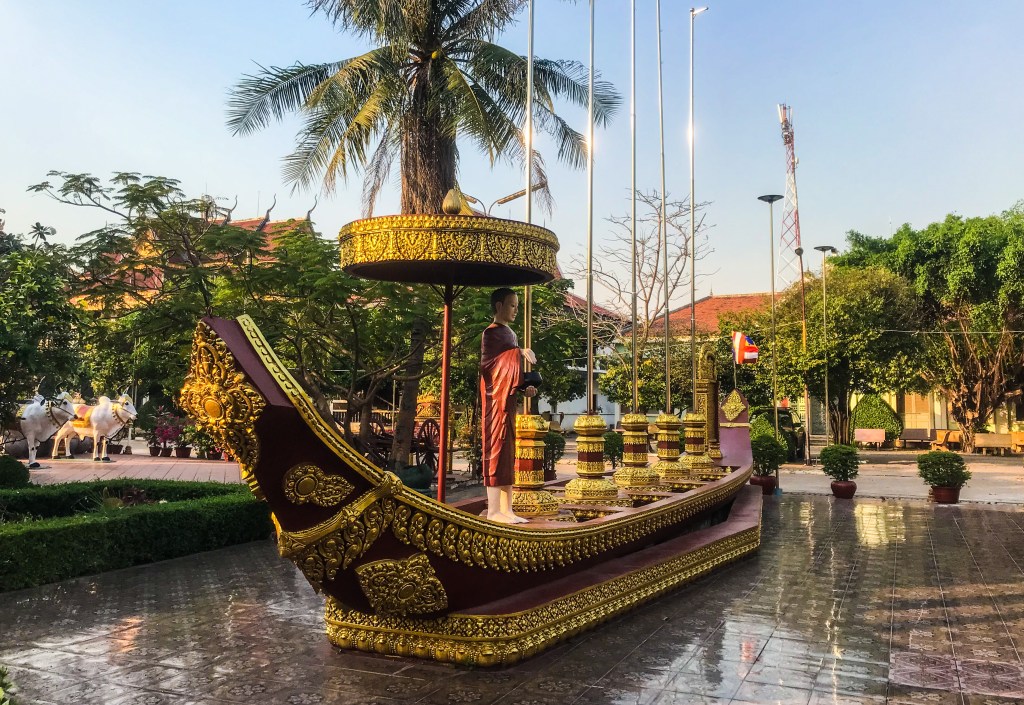
For anyone coming to Cambodia from Vietnam, the dissimilarities in Buddhist sites cannot be understated. Cambodia, a Theravada Buddhist country, is more like Thailand in its worship and architectural styles, including towering chedi and pavilions covered with gold leaf. Vietnam, a Mahayana Buddhist land with a strong “mother goddess” element in its worship, is more subdued. Indeed Vietnam’s brown-robed monks are seen far less than the saffron-robed adherents I meet in Cambodia. I was grateful for the opportunity at Wat Bo to sit and converse with a young apprentice monk, quietly reading but wanting to practice English.
Getting there
Flights into Siem Reap are expensive — in part, I’m sure, because dollars are helping to pay for a new international airport presently under construction (thank you, China) — so I take the bus, six hours from Phnom Penh, twice that from Ho Chi Minh City, a bit less from Bangkok, including passport controls at the borders. The journey is not unpleasant, and sleeper buses with reclining seats and private cubicles are widely available.
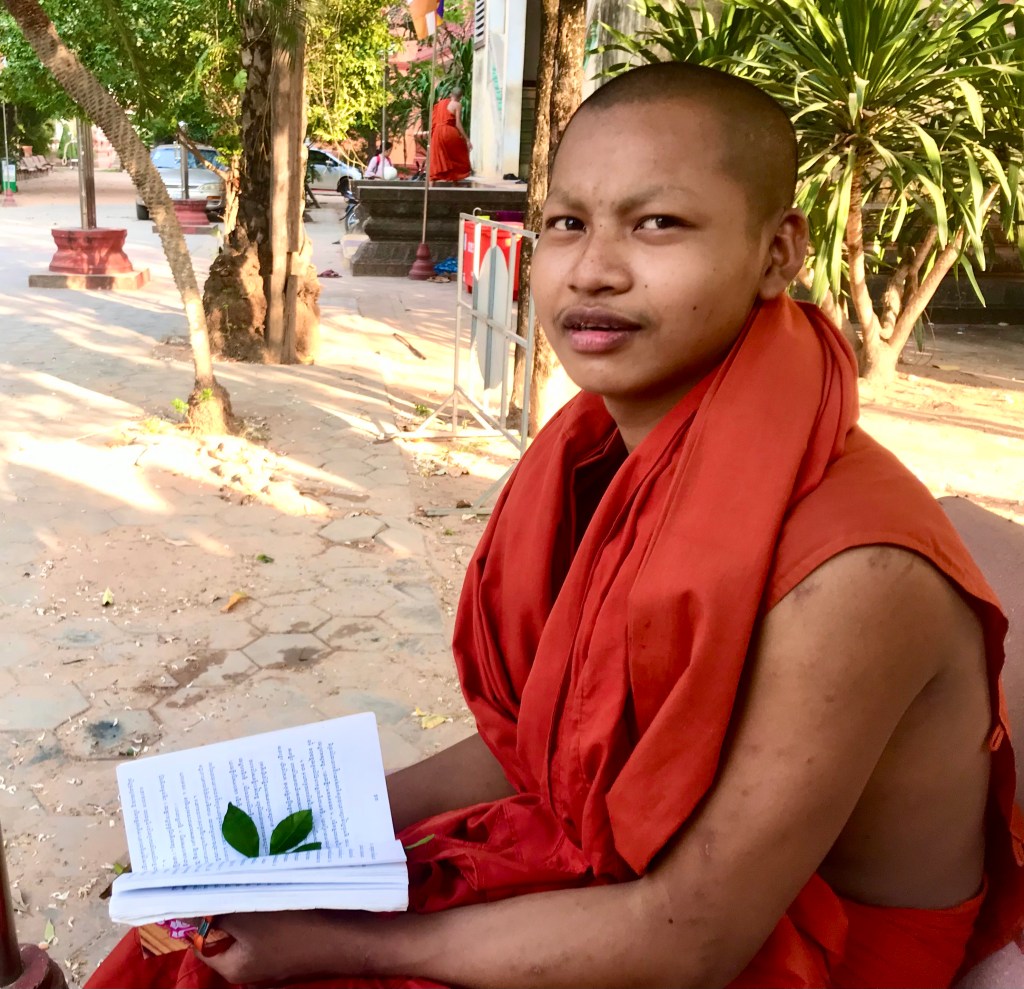
I stay 10 days in Siem Reap and split my sojourn between two budget hotels. The Okay 1 Villa has spacious rooms and a rooftop pool and restaurant, but it has a dark, outdated feel; I eat breakfast each day at the brighter Bokre Angkor Hostel, just next door. My private quarters are less attractive when I move to the Five Rose Siem Reap Hostel, across the river to the east, but Five Rose has a more upbeat vibe than the Okay 1. And another excellent, low-priced dining spot is nearby at the Brother Bong Café.
Before departing Siem Reap, I return once more to Pou to visit Mengly and dine on green duck curry with num banhchok rice noodles. “When you come back,” says Mengly, who speaks excellent English, “you might like to join one of my cooking classes.”
Wow! Bonus! I don’t know where I’ll find red tree ants at my local market, but I’ll certainly welcome the opportunity to learn how to make fish amok and beef lok lak!
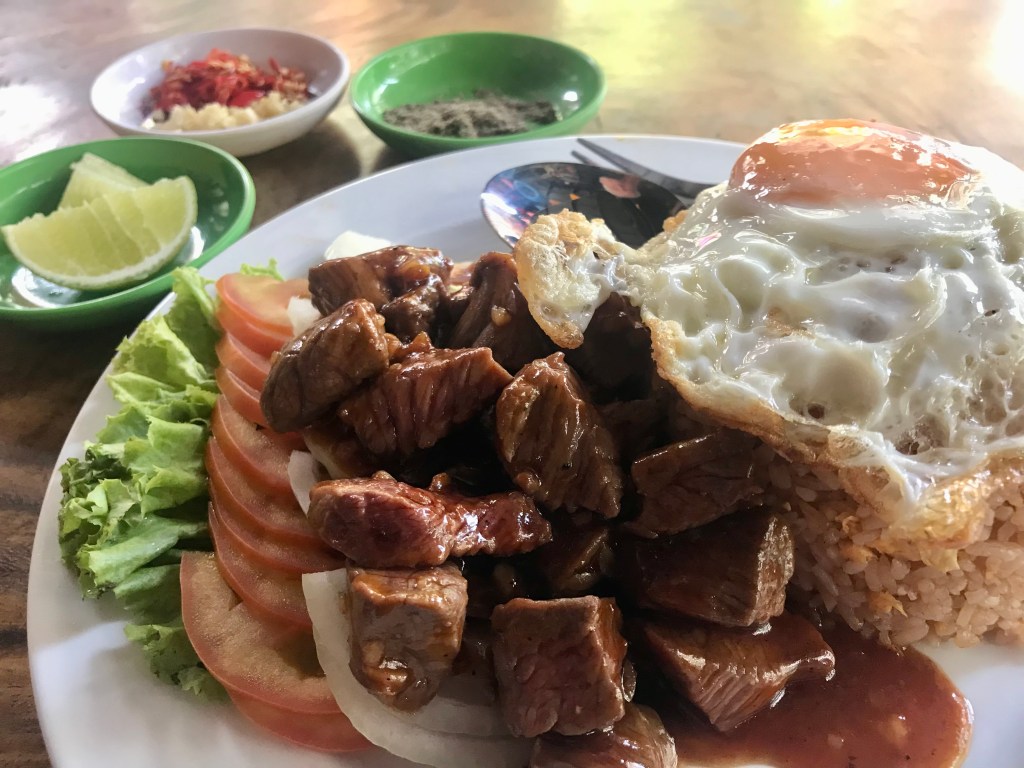


Two historical sites in Phnom Penh recall the terrible reign of the Khmer Rouge during the Cambodian Genocide of the late 1970s.

I find it impossible to fathom the inhumanity of genocide. What can be said about the deliberate killing of an entire group of people simply because they are the “wrong” ethnicity, or the “wrong” religion, or the “wrong” ideology?
The Holocaust is the most widely known example. As many as 7 million European Jews, and a similar number of Slavs, died during Nazi Germany’s World War II-era ethnic purification program as directed by Adolf Hitler. But that wasn’t the first, nor the last. Only a few years earlier, Russia’s Josef Stalin had slaughtered at least 3 million Ukrainians during the forced famine called the Holodomor. The Ottoman Empire decimated Turkey’s population of Armenians, Assyrians and Greeks between 1915 and 1920. A century earlier, Tasmanian Aboriginals were slain to extinction in colonial Australia.
Genocides continue today. Consider the Tutsis in Rwanda, the Darfurs in the Sudan, the Uyghurs in Chinese Xinjiang and the Rohingya in Myanmar, to name several recent (and, in the latter two cases, ongoing) examples.
But of all post-Holocaust slaughters, none was as profound as the Cambodian Genocide. Over a period of not many more than 3½ years (1975 to 1979), about 25 percent of Cambodia’s population was systematically massacred. At least 2 million people were tortured and murdered. Entire families, men, women, children, were eliminated. Satan was alive and well in “The Killing Fields.”

Agrarian utopia
During the last days of the Vietnam War in April 1975, Cambodia’s pro-American government was overthrown by the Communist Party of Kampuchea under the leadership of Pol Pot. His ideology deeply rooted in Marxist-Leninist thought, Pol Pot rallied his Khmer Rouge army in support of his vision of a self-sufficient agrarian society, founded on the principles of Mao’s Cultural Revolution in China and free of foreign influence.
Pol Pot set out to achieve this goal by forcing citizens out of the cities and into forced labor camps. Of course, urbanites were ill-prepared for 12-hour days of manual labor. Physical abuse, malnutrition and disease were more the rule than the exception. Those who couldn’t keep up were summarily executed.

Anyone who might be considered a threat to the new regime, which called itself Democratic Kampuchea, was arrested and killed. Anyone with ties to the former government was dispatched post-haste. The list extended to teachers, students and other intellectuals; doctors, lawyers, journalists and business leaders; even Buddhist monks. If you just looked like you might be smart — wearing glasses, perhaps, or speaking a foreign language — you were in trouble.
Ironically, for the most part, the Khmer Rouge and their victims were all members of the same ethnic group, the Khmer. This gave the Cambodian Genocide a unique and insidious character. Persecutors and victims spoke the same language and had the same (Theravada Buddhist) religious beliefs. Yes, there were ethnic minorities, including Vietnamese and Chinese Cambodians and the Islamic Cham people; but the millions who died were overwhelmingly Khmer.
Mercifully, the bloodshed ended at the start of 1979. On Christmas Day 1978, angered by Khmer Rouge attacks on towns in the lower Mekong Delta, Vietnam invaded Cambodia. Within two weeks, the brutal regime had fallen as the Vietnamese took control.

Confess and die
The horror will not soon be forgotten. In the capital city of Phnom Penh, two somber sites are constant reminders. I visited both of them — the Tuol Sleng Genocide Museum and the Choeung Ek Genocidal Center — in the same day.
More than 18,000 prisoners passed through the gates of Security Prison 21 (“S-21”), now known as Tuol Sleng. Only seven survived. A public high school in the heart of Phnom Penh before the Pol Pot era, S-21 was one of 196 prisons the Khmer Rouge operated throughout Cambodia. (Admission is $5, or $10 with an audio tour guide.)
In prisons such as this, suspects were tortured and interrogated until their “confessions” pointed to others, and thus arrests multiplied a hundredfold. Separated from their parents, children were often manipulated to invent stories and squeal on their family members.
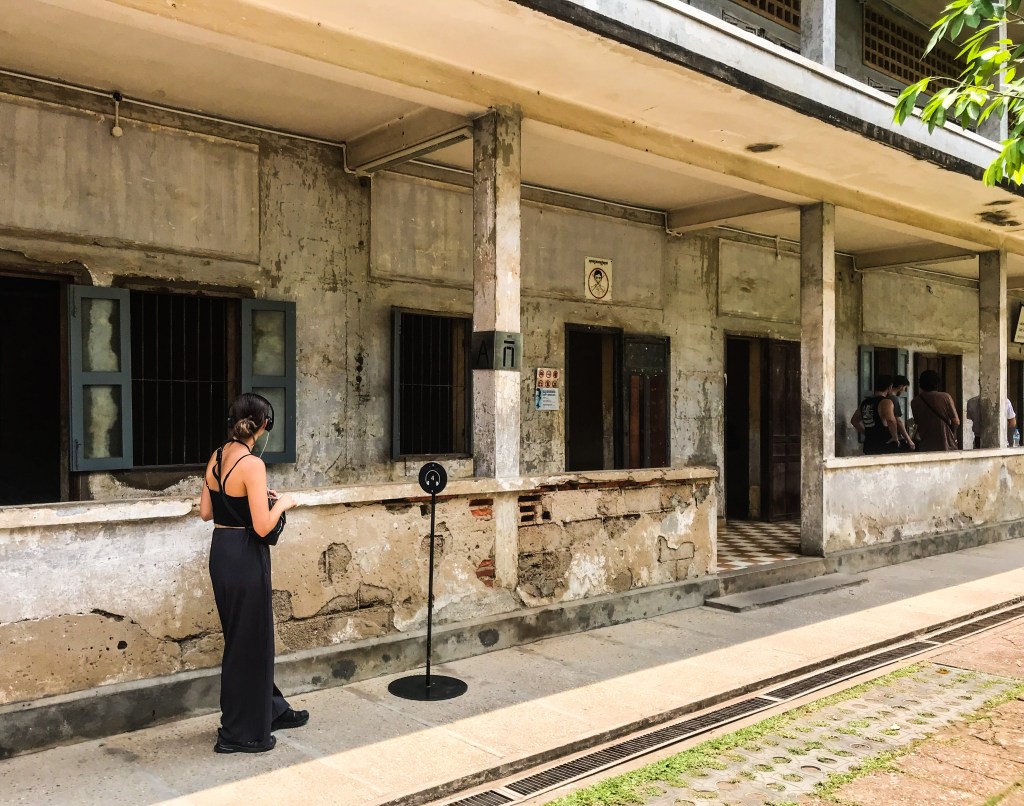
Four three-story buildings that surround a quadrangle comprise the largest part of the museum. Classrooms, converted to cells, contain solitary metal-frame beds and photos of death. Some of the upper levels have exhibits with mug shots of men, women and children who suffered here, along with clothing and instruments of torture. It is indeed heartbreaking to look at the tattered remnants of boys’ shorts and little girls’ frilly dresses,
The ground level of Building C is wrapped in barbed wire, reportedly a suicide-prevention device. This baffled me: If the prisoners were going to be executed in any event, why try to stop them?
Indeed, when torture and interrogation at S-21 had run their course, the prisoners were loaded into trucks and taken to the Killing Fields for execution.

Eliminating enemies
Tuol Sleng displays graphic photographs that illustrate unspeakable horror. Choeung Ek takes it a step further. Here, mass graves and bones leave nothing to the imagination. The memorial pagoda at the heart of the grounds is stacked with skulls — thousands of them. These were, indeed, the Killing Fields.
An audio tour, included in the $6 admission, is absolutely the best way to explore the grounds. (Plan at least 90 minutes.) It guides you past a series of interpretive signs describing buildings and functions that no longer exist, but whose specter lives for all time.
I was led past a truck stop, the final terminal for prisoners from S-21 and other prisons. Blindfolded and no doubt terrified, as many as 300 a day were promptly executed, their bodies tossed into a pit. To save bullets, they were often beaten to death with pick axes, hatchets, shovels or garden hoes. Victims who had to wait for their doom were shackled and held overnight in a pitch-black building. Chemicals such as DDT were stored nearby; immediately upon execution, these substances were spread over dead bodies to mask the stench.

The adjacent grounds had been an orchard and Chinese cemetery before they were taken over by the Pol Pot regime. The earth was receptive to digging. Sunken depressions, only partially redeemed by two generations of rainfall and erosion, still indicate a series of mass graves. One fenced plot has been retained. A sign indicates that 450 bodies were piled here.
In some places, even 45 years later, bone fragments find their way through the soft soil to break ground, where they are collected by caretakers. The walking-tour route winds past deposits of some of these skeletal remains, along with piles of blindfolds and strips of clothing. Two broad-trunked trees are particularly disturbing. One is noted as a place where infants and toddlers had their skulls fractured before they were tossed into a pit; the other was hung with loudspeakers that played martial music to drown out the screams and moans of the dying.

The horror culminates at the memorial pagoda at the heart of the complex. It is a repository for thousands of human skulls, a macabre tower of terror. Many of them have been categorized by age and gender, juvenile to elderly. With shoes and hats removed, visitors may reverently squeeze around all four sides of the glass-encased cenotaph.
Nearby is a bronze statue of a mother and child. A plaque, in the Khmer and English languages, reads: “Never will we forget the crimes committed during the Democratic Kampuchea regime. … 17.04.1975 – 07.01.1979”
The history of the human race is one of continual conquests. As one civilization falters, another rises to take its place. No society, no government, persists for more than a few centuries at best. But that’s a natural progression, and there is nothing natural about bullying and genocide. If we cannot keep our place of power, we can at least maintain our honor, our integrity. Mass murder is never the way.



A fond farewell to a mentor, a friend, a kindred spirit, and one of the most memorable characters this writer ever had the pleasure to know.
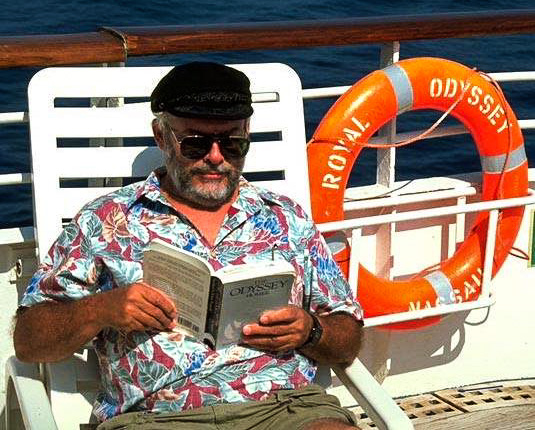
I have a bone to pick with someone. Sadly, it won’t be with Robert W. Bone. Bob, whom I credit with (or blame for?) my decision to become a travel writer, died recently at the age of 90.
I was 20 years old in 1971, just out of university and my first trip to Europe, when I met Bob at The Honolulu Advertiser daily newspaper. We immediately connected as kindred spirits. Eighteen years my senior, he was a traveler, a man of the world who had already made a name for himself.
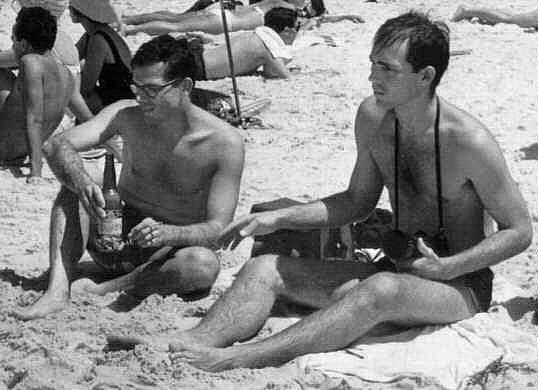
Bob graduated from Bowling Green State University in Ohio with degrees in journalism and Spanish, did a stint in the Army, then took a newspaper job in San Juan, Puerto Rico. There he became close friends with another renegade reporter, the infamous Hunter S. Thompson. (Bob and his car were portrayed as Hunter’s sidekicks in the movie The Rum Diary, unfortunately now better known as the set on which Johnny Depp met Amber Heard.) Chaos ensued. At some point, Bob fled to Brazil, where he resurfaced as a business editor in Rio de Janeiro.
Eventually Bob returned to the States, enjoying the single life in New York City — as an editor for Time-Life Books — until his bluff was called by a sassy Kiwi nurse named Sara Cameron. When Bob was hired as senior writer for Fielding’s Travel Guide to Europe, the couple headed across the Atlantic, settled in Majorca, Spain, and started a family.
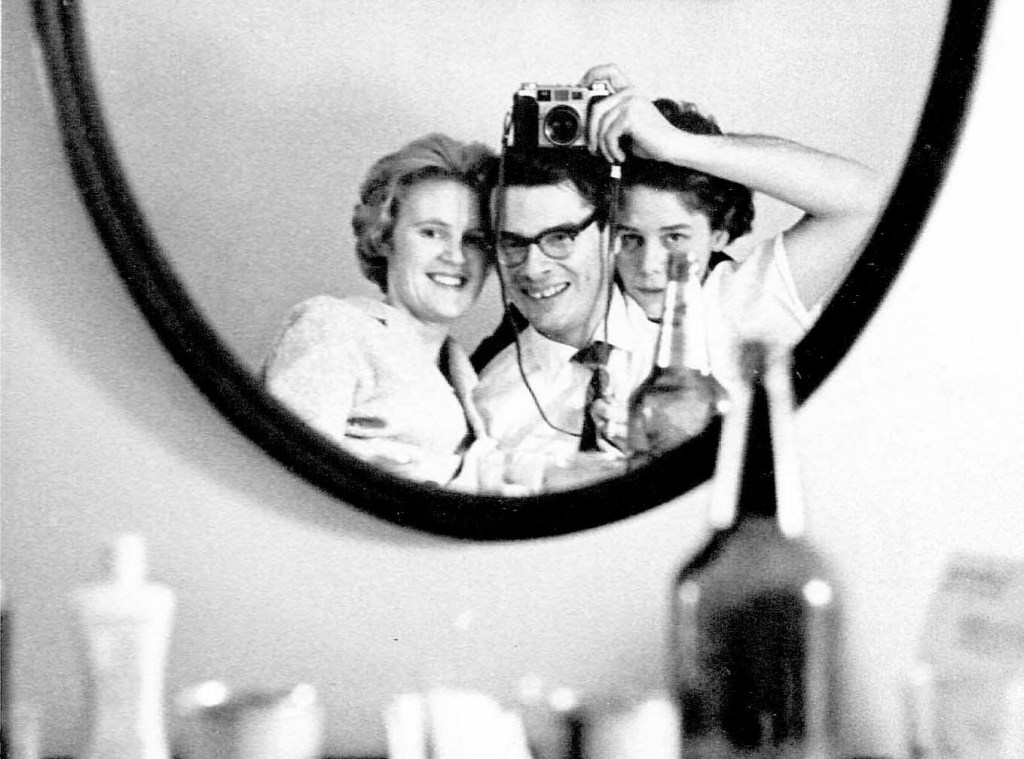
At the start of the ‘70s, the Bones set their sights on another tropical archipelago: Hawaii, more-or-less midway between Bob’s parents in Ohio and Sara’s in New Zealand. He became a staff writer for the morning Advertiser. That’s where we met.
I had spent my two previous semester breaks in Honolulu as a summer intern at The Advertiser. I wrote sports, sitting in the press box with Al Michaels, then 26, and hanging out with baseball legends like Tommy LaSorda and Jimmie Reese, who just happened to have roomed with Babe Ruth when the Yankees were on the road. When I returned full-time a year later, it was as a features and religion writer. My big interview was an hour spent with the Rev. Dr. Billy Graham in his hotel room at the Royal Hawaiian. But my passion was travel.
During the next 2½ years, I learned from Bob what it meant to be a travel writer. Was it all fun and games? Hell, yes. So was sports writing. (John Henderson understands.) The transition from one to the other wasn’t a big deal. (From transcribing televangelists, maybe a bit more so.) But I also learned that “organization” doesn’t have to be Kondo style.

Bob was one of the most disorganized organized people I ever knew. His family life with two young children (God bless Sara) was pure pandemonium. But his full collection of original “Green Hornet” radio episodes — something he would have grown up with in the ‘30s and ‘40s — were carefully labeled, filed and stacked in shelves next to his home office. The Green Hornet strikes again! (My own style of itinerant organization was more along the lines of Blind Faith. When Steve Winwood and Eric Clapton lapsed into 15 minutes of “Do What You Like” at a Honolulu concert, they might have been singing my life story.)
I left Honolulu late in 1974, armed with a multi-stop round-the-world ticket sold to me by Bob and Sara’s personal travel agent. I island-hopped across the Pacific, with stops in Samoa and Fiji before I reached New Zealand. One year later, I was still there. Indeed, after twice renewing my ticket, I didn’t make it back to the USA during nearly three years of vagabonding across Asia and Europe. I remained in steady contact with Bob, long before cell phones and e-mail, with hand-written correspondence collected at a variety of locations, and contributed to his Maverick Guides to New Zealand and Australia. I was on my way to becoming a bonafide travel writer.
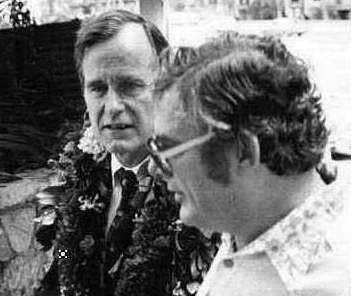
After a spell in Seattle, I made it back to Hawaii in 1980, having been awarded a graduate journalism fellowship to study Asian culture at the university there. This time, I came with a wife, Linda, and she was glad to bond with the Bones. (In fact, other than my immediate family, Bob anđ Sara were among the rare few people who met all three of my long-term partners.) My year’s study included intensive Japanese language, and with Bob’s support, I signed to write a guidebook to Japan … although I was forced to cancel that contract when another opportunity arose.
In early 1982 I went to Southeast Asia, to work for a Singapore-based publisher on a photo-laden travel guide to Sri Lanka. Over the next few years, as chief editor for APA Productions, I created numerous new and revised Insight Guides, editions of then mainly Asia- and Pacific-oriented books. But as the calendar pages flipped, I made fewer and fewer visits to Hawaii, where the Bones continued to reside.

In 1988, Bob was my primary sponsor when I joined the Society of American Travel Writers (SATW). In 1995, in Honolulu, I was able to introduce the Bones to my son, Erik (born in Singapore in 1984). I worked in travel journalism in Seattle; Los Angeles; Boise, Idaho; Greenville, South Carolina; and finally Bend, Oregon, as a magazine editor and newspaper columnist. But whenever I was in the islands, a visit with the Bones was something I never wanted to miss. And on other occasions, Bob’s hearty belly laugh and trademark gap-toothed smile were a welcome sound and sight at SATW conventions.
One of my favorite memories occurred at California’s Universal Studios in 1992 as the theme park hosted a special evening for travel writers. We were greeted by numerous celebrity impersonators, including Marilyn Monroe, James Dean and “Doc Brown” from the Back to the Future movies. After enjoying visits to the sets of Jaws and King Kong, we retreated to an intimate watering hole, Telly’s, for drinks and story swapping. Bob and I sat together at the bar. Bob was impressed when a debonair, bald-headed man of about 70 offered to top off his drink. “Of all the celebrity impersonators I’ve seen tonight,” he said, “you are the best! You look just like that guy from Kojak!” “Thank you, sir,” said Telly Savalas himself. “That’s very kind of you to say.”
By the time of my last visit to Hawaii in 2016, Bob and Sara had retired to the mainland, where they lived in a retirement community in Walnut Creek, California. I saw them there once more, too many years ago.
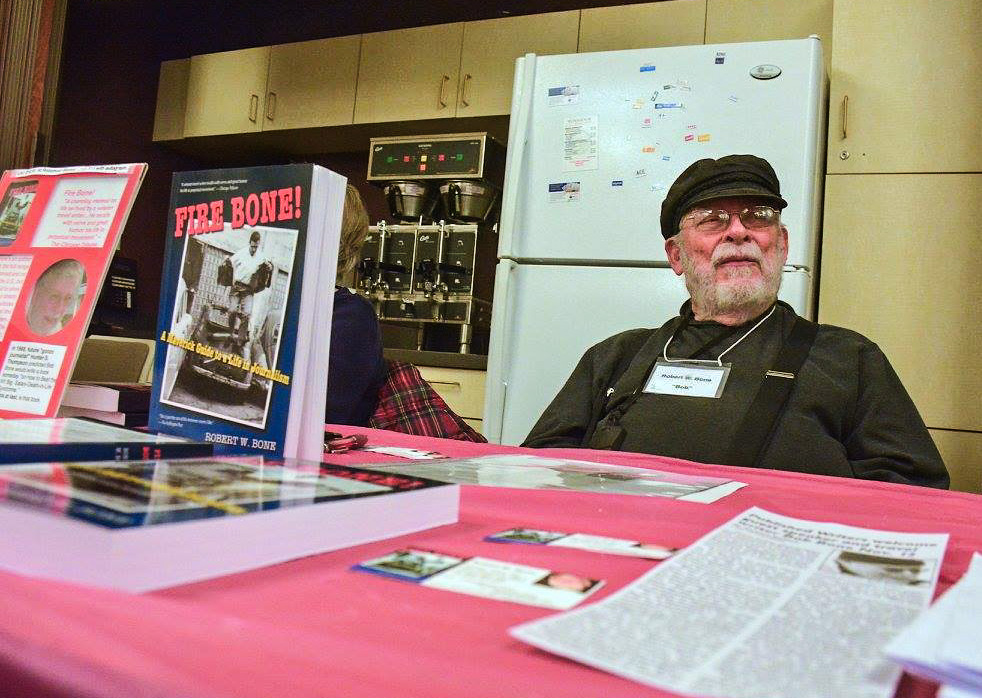
In 2014, Bob published his autobiography: Fire Bone! A Maverick Guide to a Life in Journalism. I was among the friends he asked to read, review and proof the book before its publication. Soon thereafter, he was encouraging me to write my own memoir. Perhaps I will, someday … and I may not wait until I’m 81, as he did. I only wish Bob were around to read it.
He wrote me this email when he was 85, before I embarked on my latest adventure in Vietnam: “Your career over the years since leaving Hawaii has really been dramatic, John. At some point you, too, should write a memoir. I’ll give you some ideas if I’m still around. I get exhausted easily these days. I’m in pretty good shape for my age, but I do feel it, to be sure.”
Bob Bone made it another five years. He passed away 10 weeks ago, on February 1, reportedly of complications from a broken femur (hip). I can barely imagine what it must have been like to be a lifelong traveler, deprived of his cherished mobility.
Sail on, dear friend. Bone voyage. See you on the flip side.


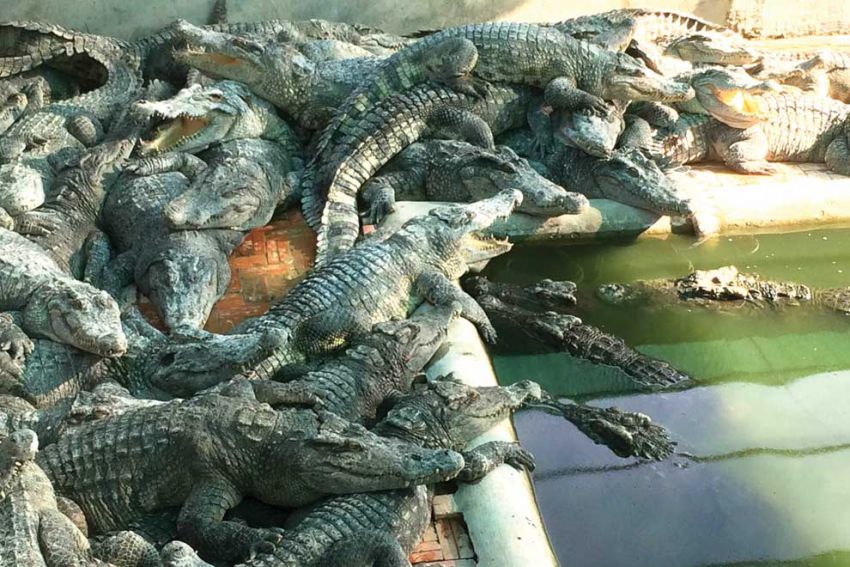
As published by the East-West News Service in March.

Once the largest city in Southeast Asia, Angkor is now a World Heritage Site of more than 1,000 ruins, beginning with Angkor Wat, a religious structure like no other.

The towers of Angkor Wat rise from the wooded plain like colossal spearpoints, piercing the Cambodian skies as if borne by Vishnu himself. At sunrise, they appear as giant cornstalks in a field of ultimate dreams, an Oz-like Emerald City at the end of a yellow brick road.
This is one of the great marvels of the medieval world, a bucket-list destination equal in grandeur to Egypt’s pyramids and Peru’s Machu Picchu. It is, of course, a UNESCO World Heritage Site. The world’s single largest religious structure, Angkor Wat was built in the first half of the 12th century as a Hindu center and soon thereafter became a Buddhist sanctuary that welcomes worshippers respectful of both faiths.
The name Angkor Wat means, literally, “City Temple” — and it is just one building. In fact, this was once the hub of one of the largest cities in the world. More than 1,000 temples spread across 400 square miles of jungle-dominated northwestern Cambodia. Long before Indiana Jones and Lara Croft popularized archaeological adventure, the Khmer Empire battled Chams from coastal Vietnam and their traditional enemies, the Thais, to preserve and sometimes expand their territory.

It would be impossible for me to say everything I want in a single blog. Besides, I have way too many great photos for that. This column is a mere sampler of what will come in the next few weeks, as “Travels in Vietnam” focuses on neighboring Cambodia.
Angkor Wat
With a footprint of 402 acres (more than 1,000 hectares), the main attraction is worthy of adulation. Angkor — if you pronounce it correctly, it sounds more like “uncle” than “anchor” — is indeed majestic. Each early morning, hundreds of international visitors leave their hotels in the gateway city of Siem Reap and travel by tuktuk or minibus to crowd the banks of a medieval moat that surrounds the great temple. There, they stand and patiently wait for 60, 90, 120 minutes as the pre-dawn sky fades first from black to inky blue, then to a pink blush and red-orange before the golden orb of first sun peeks out from behind a temple spire.

Angkor Wat was build on a model of Mount Meru, the home of the gods in Hindu cosmology, with its primary towers symbolizing that massif’s five peaks. It was designed in such a way that viewpoints from temple terraces (the uppermost of which are not accessible to tourists) place these towers directly before the rising sun on solstices. Concentric galleries around the lower levels of the temple are carved with intricate bas-relief story boards that honor Vishnu, the “preserver” in Hinduism’s three-pronged trinity of gods, and his epic battles in shielding good from evil.
Angkor Thom and Bayon
Angkor Thom (“Great City”) succeeded Angkor Wat as the Khmer capital in the late 12th century, after a Cham invasion. Built upon the ruins of an earlier palace, the walled and moated compound embraces grounds of more than 3 square miles, and was home to nearly 1 million people. Contemporary social scientists marvel at its elaborate infrastructure.

Five causeways — one at each of the cardinal points, and an additional Victory Gate reserved for royalty — approach the city from different directions. Each is flanked by rows of 54 statues representing gods (devas) and demons (asuras), under the watchful gaze of a four-faced, 75-foot-tall bodhisattva, a Buddhist saint who has devoted his life to assisting humanity in the physical realm.
At the heart of Angkor Thom is the Bayon, a central temple whose maze of towers and pavilions surmount steep stairways and surround three levels of courtyards. Galleries of bas-relief art occupy large sections of the walls, relating stories not only of historical and mythological battles, but also of daily life for the medieval Khmer, from chess games to childbirth to raucous partying.

Ta Prohm
Local guides call this site the “Tomb Raider” temple because it was heavily featured in the 2001 Angelina Jolie film Lara Croft: Tomb Raider. There is indeed something mystical, indefinable, about Ta Prohm. Left to be overgrown by the jungle in which it nestles, absorbed Borg-like into the tendrils of fig and kapok trees, it’s not hard to imagine it as a secret land of Hobbits and Lost Boys.
Built in 1186 as a royal temple-monastery, it was also a repository of gold, diamonds, pearls and other treasures, and was home to 12,000 people — including more than 600 dancers! Many of the walls have carvings representing their fluid movements.
As for Jolie: So moved was the actress by her experience here that she adopted a Cambodian child; established a charity to support peace, health and environment; and produced a 2017 documentary, First They Killed My Father, about the horrors of the Khmer Rouge era of the 1970s.

Preah Khan
Preah Khan was built in 1184 as a center for education. Although it was modeled after Buddhist universities in India, its carvings depict many Hindu scenes, especially from the great Ramayana epic, along with homage to royal ancestors.
Surrounded, as are so many Angkor structures, by a moat, Preah Khan has three towered entrances with a broad central gateway that welcomed chariots and elephants. They are guarded by menacing images of Garuda, a mythological eagle upon which Vishnu rode, holding snakes in their claws.
The main building is a couple of city blocks from the entry. I took my time to study the fine details of Hindu legends, from the ferocity and empathy of Shiva, to the loyalty of the monkey general Hanuman, to the pleasures and travails of Rama and Krishna, both incarnations of Vishnu.
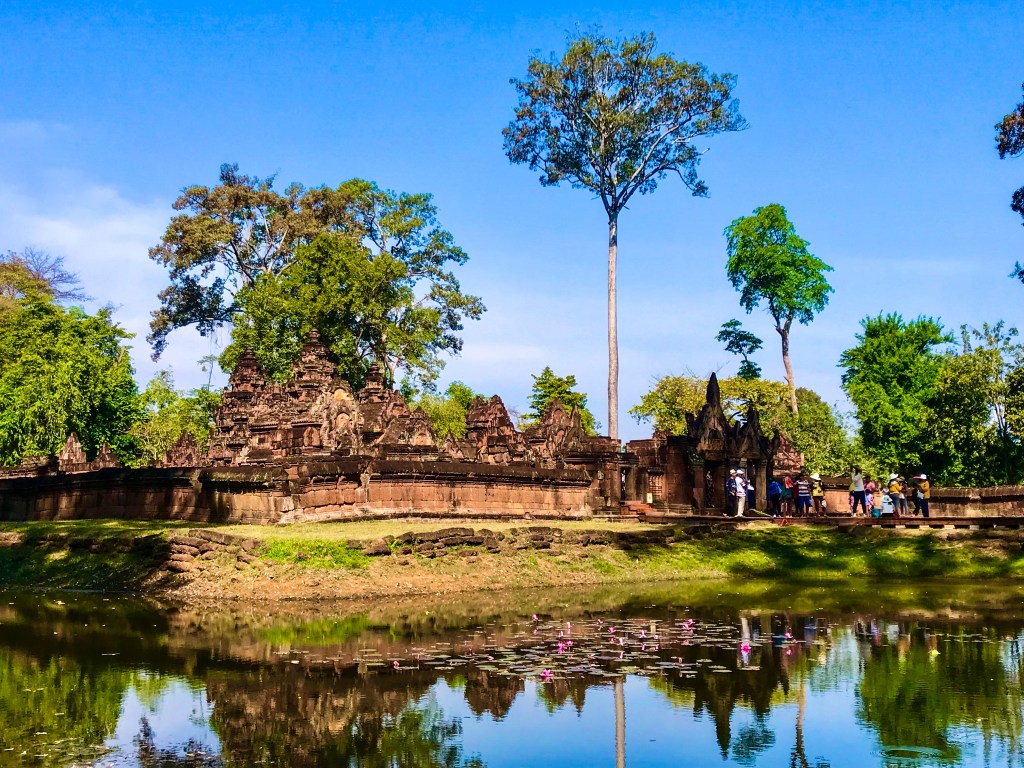
Binteay Srey
It’s a toss-up whether Ta Prohm or Binteay Srey is my favorite temple to visit. This site, about 16 miles (25 km) northeast of Angkor Wat, is well removed from the rest of the Angkor complex. Therein lies much of its charm. Built not by kings but by two wealthy and devout brothers, it is one of the earlier existing temples (completed in AD 967) and the first to be more-or-less fully restored.
Small but elegant, Binteay Srey is known as “the citadel of the women.” That name was conferred by nearby residents impressed by the voluptuous goddesses carved into the red sandstone of temple niches.
The Hindu god Shiva (“the destroyer”) is also more prominent here than at many other Angkor temples. In particular, I was enchanted by images of Shiva Nataraja, the many-armed “dancing Shiva,” and by a frieze of Kama, the god of love, raising his bow and arrow to shoot Shiva for the crime of ignoring his consort, Uma.
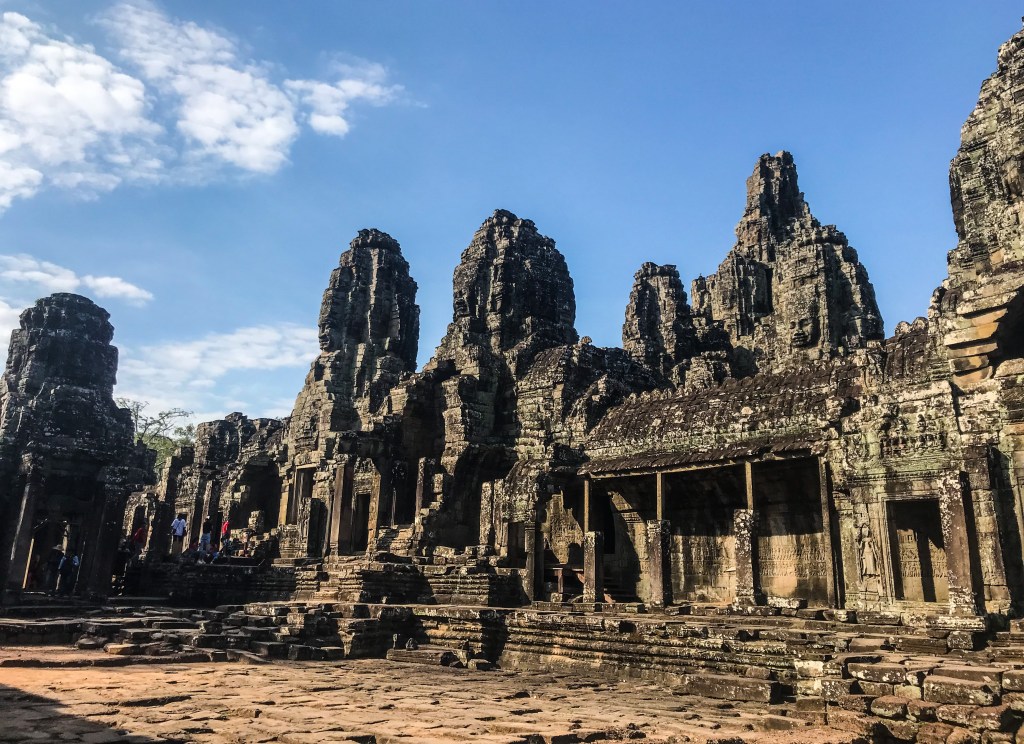
When you visit
Siem Reap, Cambodia’s second largest city, is the gateway to Angkor. Located just 4 miles (6.5 km) south of Angkor Wat, it is served by buses and airlines. A new international airport, now under construction, is due for completion in late 2023.
Most sites associated with the ancient city are protected within the Angkor Archaeological Park, open daily from 5 a.m. to 6 p.m. Visitors must purchase an admission pass (one day $37, three days $62) at the main entrance to the park, on the road north from Siem Reap. The ticket is checked and rechecked at many points throughout the park.
An aside: Although the official currency of Cambodia is the riel, the U.S. dollar is widely accepted and used almost interchangeably. Indeed, dollars are dispensed at ATM machines. The current exchange rate is about 4,000 riel to one dollar.
Transportation from the city is available by tuktuk (an enclosed, three-wheeled taxi) for $15, or by larger vehicles for $35 to $45. Bicycles ($3-$6) and motorbikes ($8-$12) are also available for rent. Several routes of exploration, including a “short circuit” and a “long circuit,” are well marked, and all major roads are paved.

I highly recommend hiring a private guide, at least for the first day. I was very pleased with Son Sorm, who charged $35 for a full day (5 a.m. to 2 p.m.). Son, who is 45 and speaks outstanding English, is a fount of information about Angkor and Cambodian history and spirituality. After his father and older sister were killed by the Khmer Rouge during his infancy, he spent his youth and early adulthood studying in a Buddhist monastery. He now devotes his free time and energy operating a rural school for underprivileged Khmer children, through the Cambodia Organization for Social Development.
I also suggest spending two or three hours at the Angkor National Museum in Siem Reap, perhaps after your first day’s visit. It will illuminate the historical and religious foundations of the Angkor era, from its rise in the 9th century to its decline in the 14th and 15th. In particular, the nuances of the artistic expression and architectural styles of various eras are brought to life.
As for Siem Reap: I will share much more about this charming city in a subsequent blog.



As the lunar calendar turns, I realize that what really matters in my life are the relationships that I create and nurture.
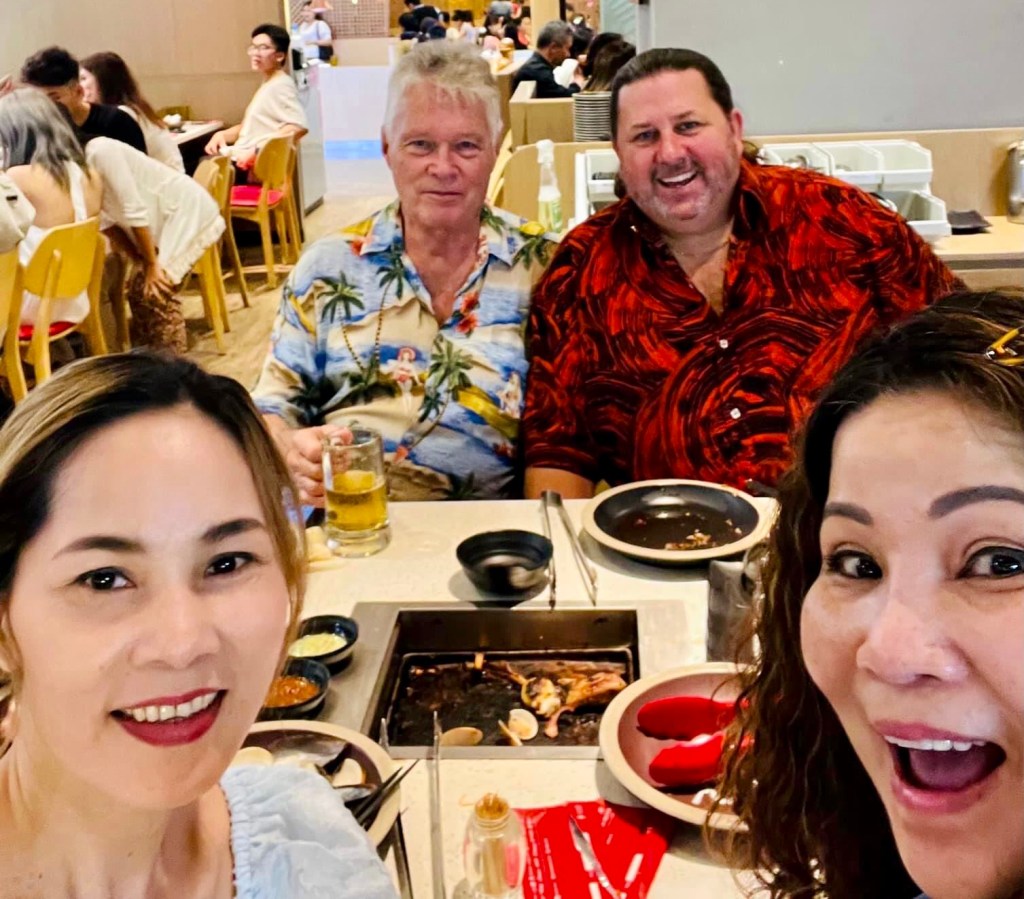
Happy Year of the Cat!
If you think the lunar calendar is about to turn to the Year of the Rabbit, you are clearly in China. Vietnamese are thinking far more feline.
The changing of the almanac is always a time of reflection. When I started out to select two photographs per month to illustrate my past year of life in Vietnam, I expected to post a lot of postcard-worthy photos of beautiful places, as I may have done in past years.
But I discovered something as I went through them: While I have a fair number of pretty pictures, those that I valued far more were shots of people who mattered to me this year. Certainly, the Year of the Tiger — MY YEAR — was about relationships more than it was about destinations.
So, herewith my holiday gift to my readers … and to myself.
JANUARY

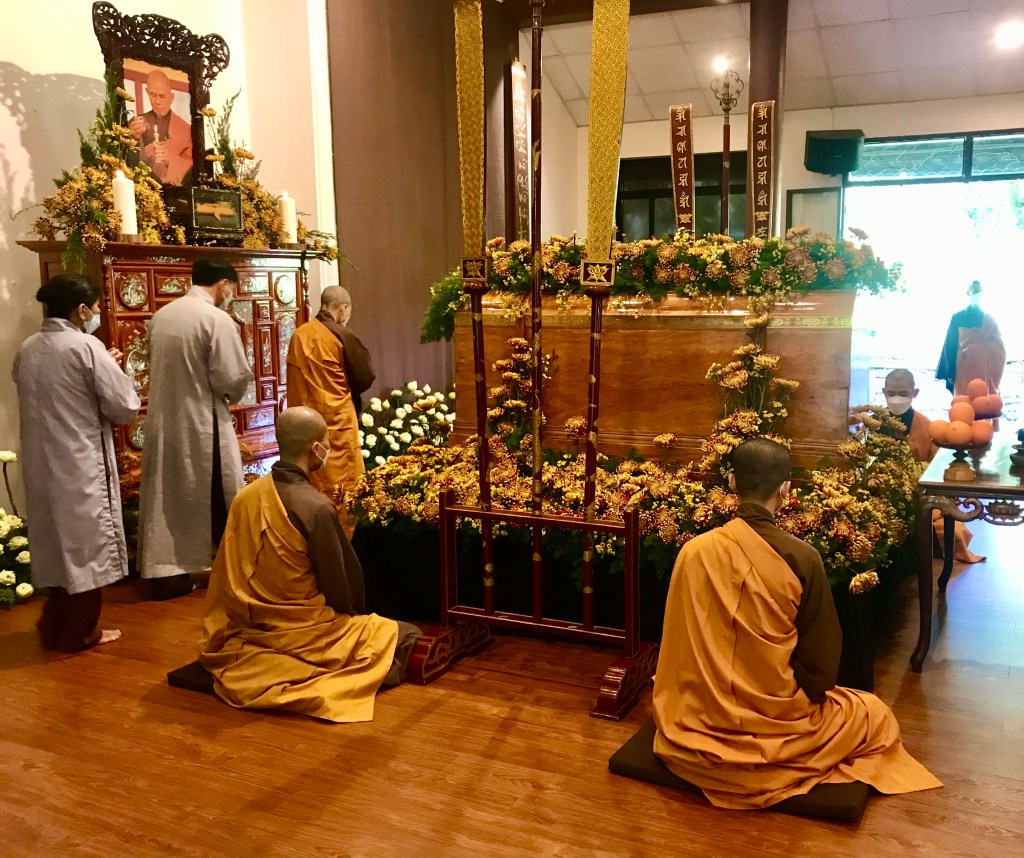
FEBRUARY


MARCH


APRIL


MAY


JUNE
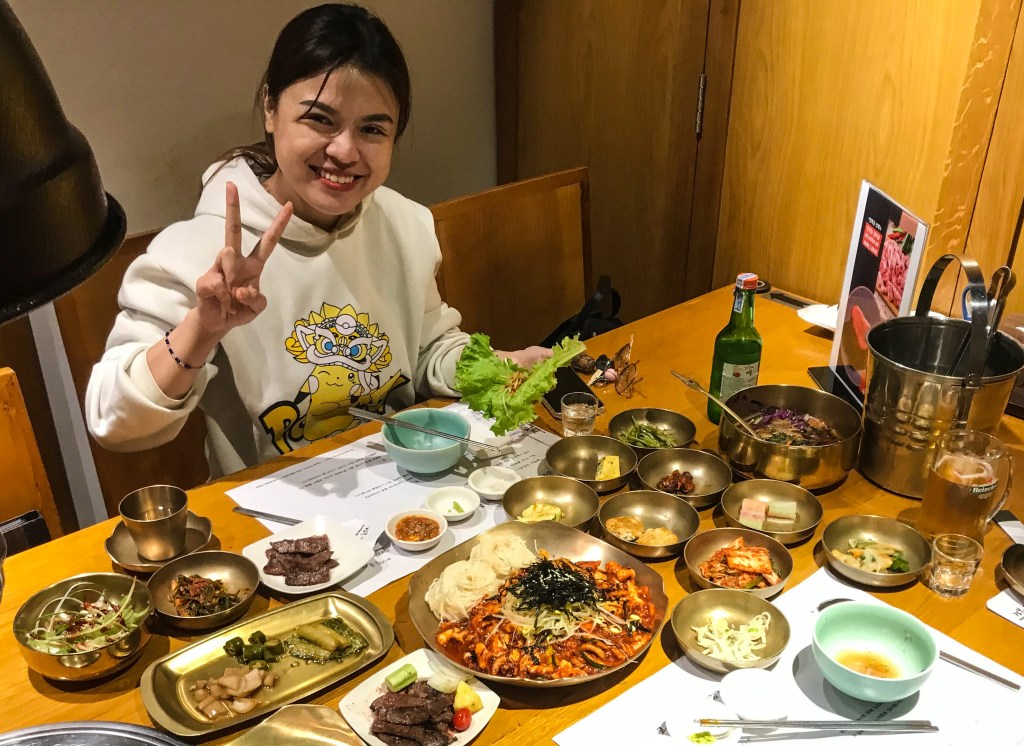
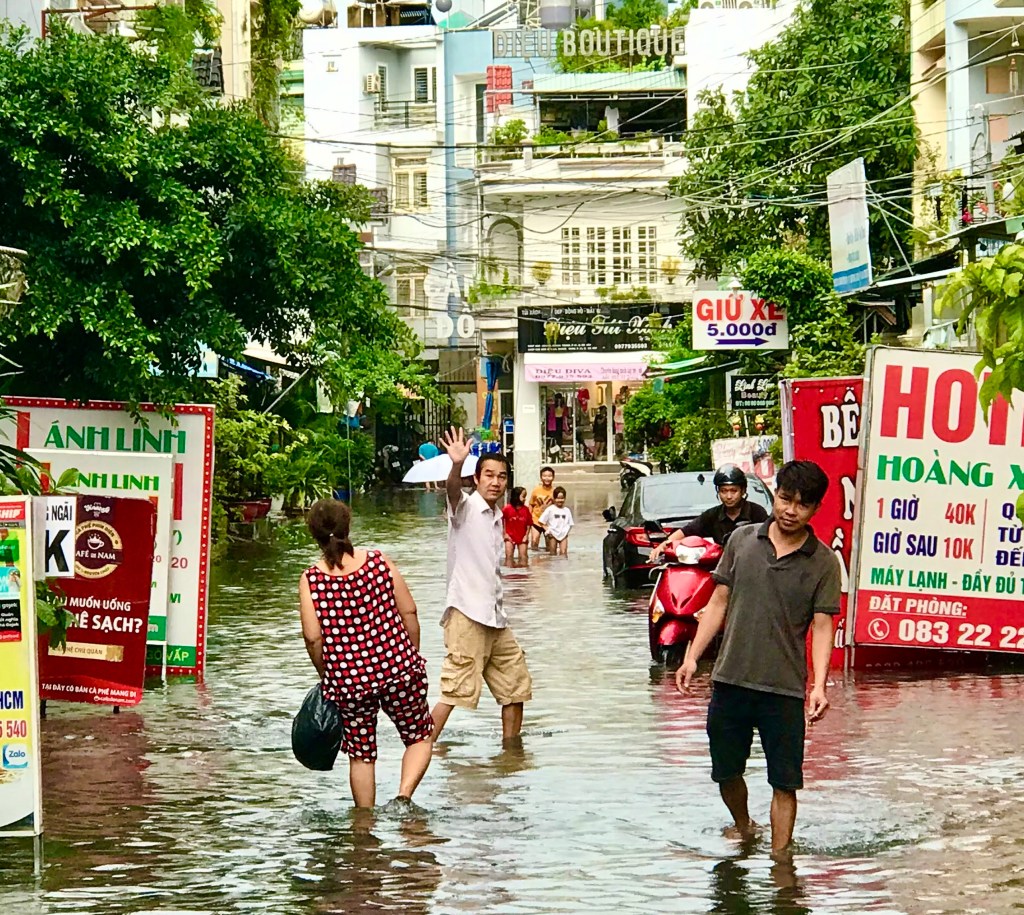
JULY


AUGUST

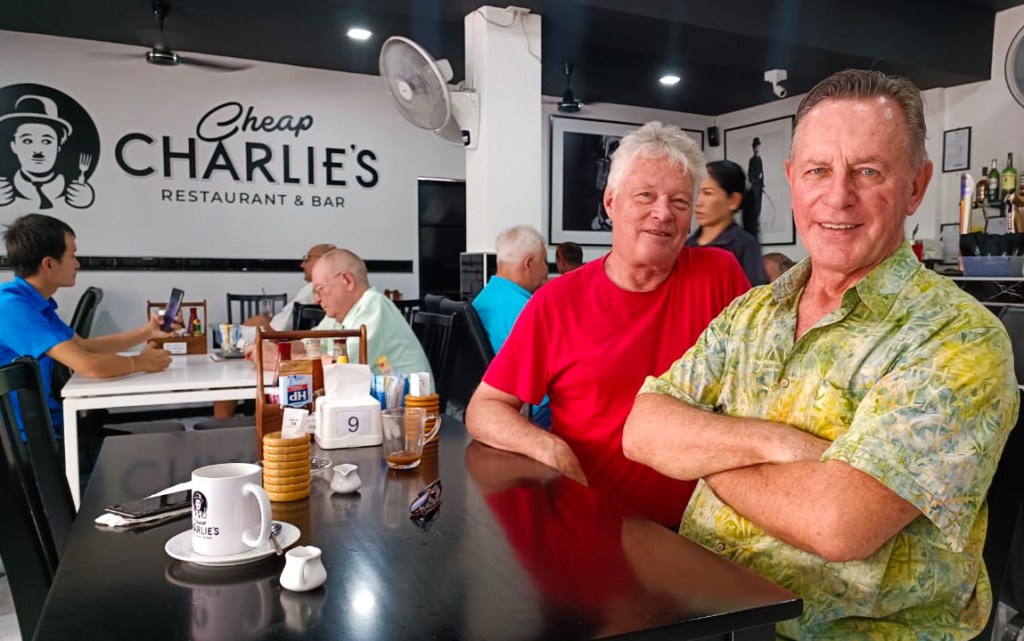
SEPTEMBER

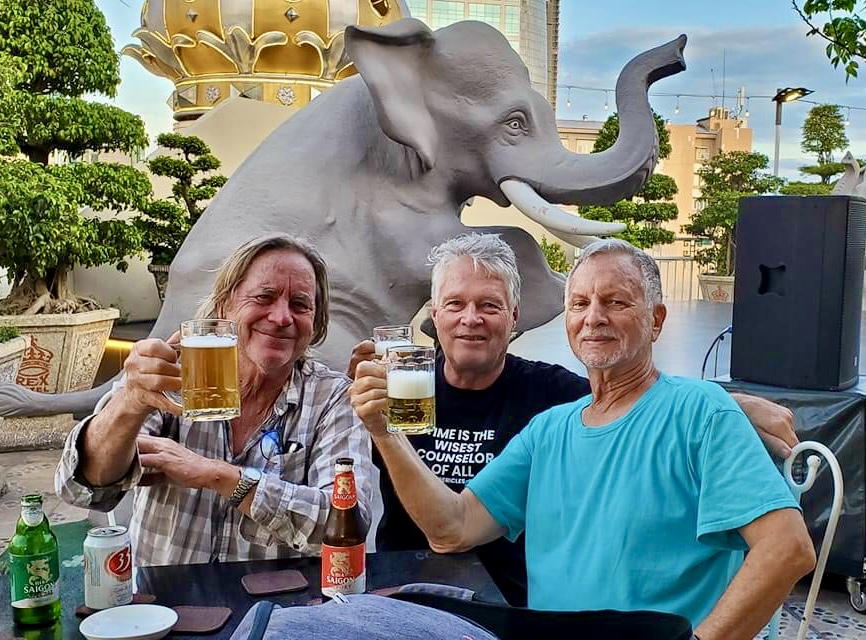
OCTOBER

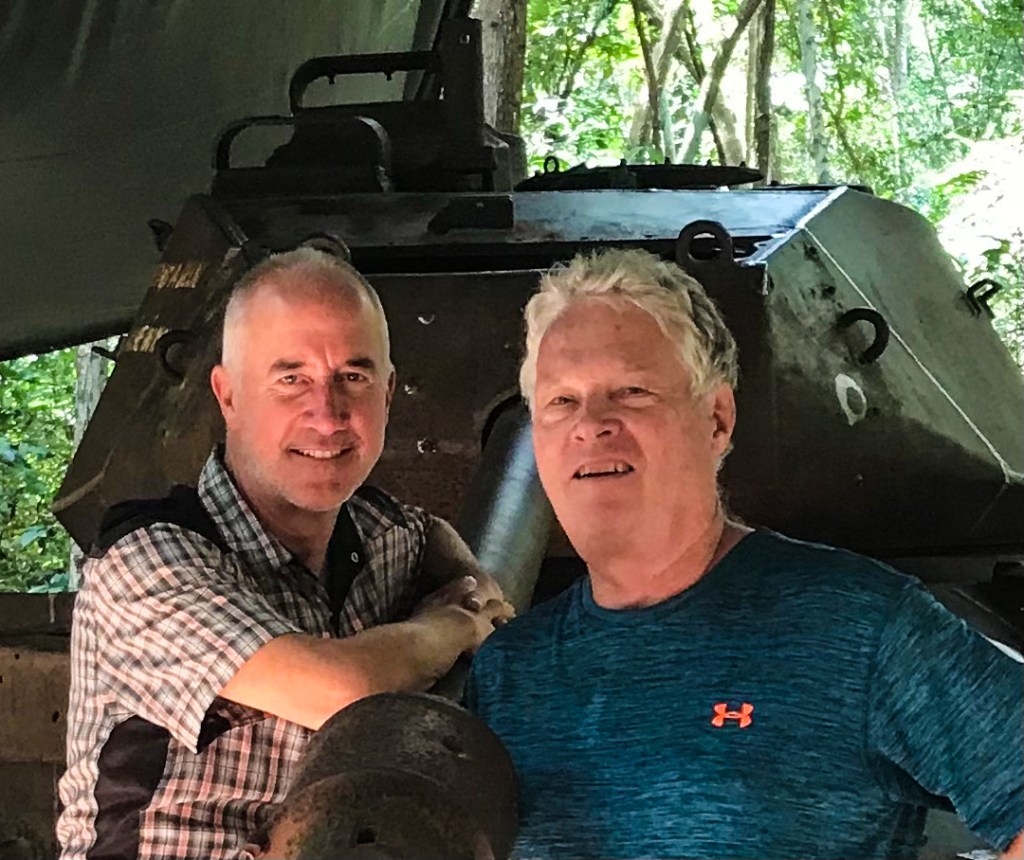
NOVEMBER


DECEMBER

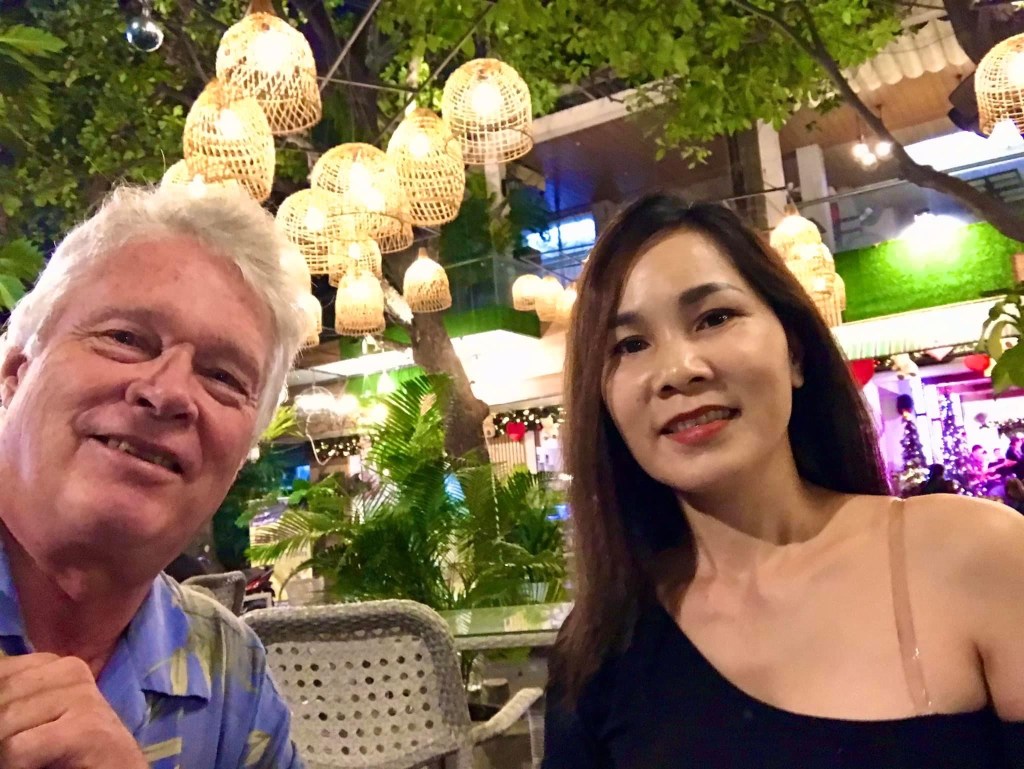
AND INTO 2023


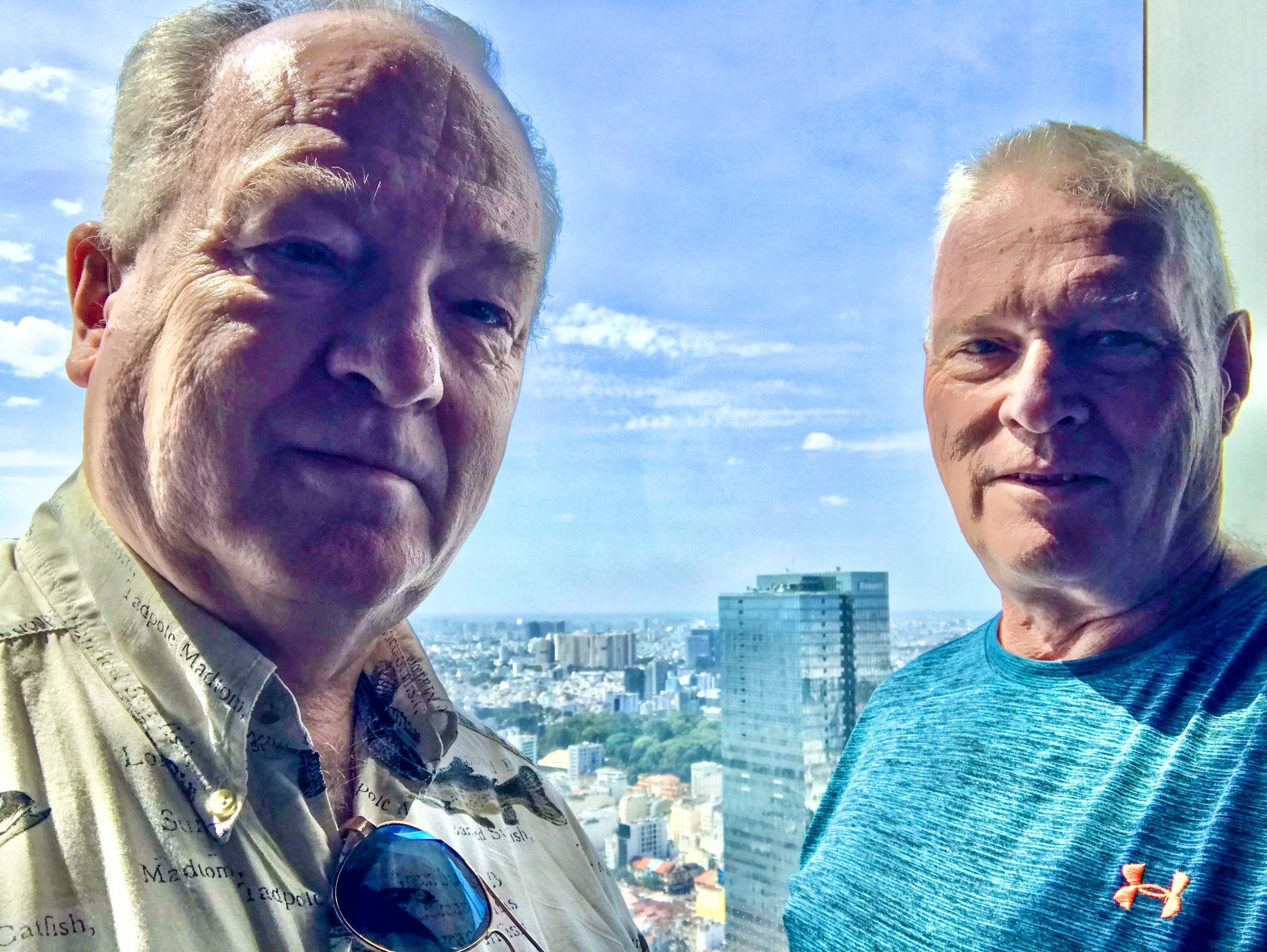
Two old pals reunite for three weeks exploring some of Vietnam’s urban and rural environments — big city to beaches, highlands and history.

Bruce Legas strolled slowly and purposefully around the 49th-floor observation deck of the Bitexco Financial Tower and looked out in all directions upon the mushrooming metropolis of Ho Chi Minh City, once known as Saigon.
“Wow!” he exclaimed. “I had no idea it was this big!”
It’s a common reaction among first-time visitors to HCMC, the largest city in Vietnam and second most populous (with 13 million people) in mainland Southeast Asia. So the skyscraper is a place I often take newly arrived friends early on their visits.
Bruce was a special case. He has, after all, been my best friend for 52 years. Our exploits go back to our rebellious college years and a wild-and-woolly road-and-rail trip to Mazatlán, Mexico. We had not seen each other since I left the United States in late 2019.
The owner of a sports bar-and-grill in suburban Seattle, Bruce had taken three weeks to focus his first trip to the Asian continent on my new corner of the world. And I wanted to give him a good, if brief, introduction to some of my favorite places and people.
This is how I organized his private tour.

Ho Chi Minh City
In the former Saigon, I placed him in a cozy but comfortable $18-a-night boutique hotel near my own apartment, a short walk from the central Ben Thanh Market. The market is one of the best places to find a broad selection of traditional Vietnamese street food, so I wasted no time in introducing my friend to dishes like bánh mì, bún bò Huế and mì quảng— and, of course, a proper phở.
I showed him some of the city’s leading sights in a short walking tour that included the statue of Ho Chi Minh, father of modern Vietnam, at the head of Nguyen Huế boulevard, and the 19th-century Opera House, among other historic remnants of French colonial rule. One early evening, we plowed through the throngs on Bùi Viện, a so-called pedestrian way that was dangerously packed with motorbikes even as nightclubs turned up their tunes and expanded their seating into the street.
Indeed, motorbikes are at once Saigon’s greatest curse and, perhaps, its biggest blessing for negotiating the many narrow lanes inaccessible by four-wheeled vehicles. It’s hard to imagine traffic without them. But the uncontrolled emissions contribute heavily to nightmarish air pollution. And crossing almost any urban street by foot takes nerve, stealth and bravado, crosswalks and traffic lights be damned.
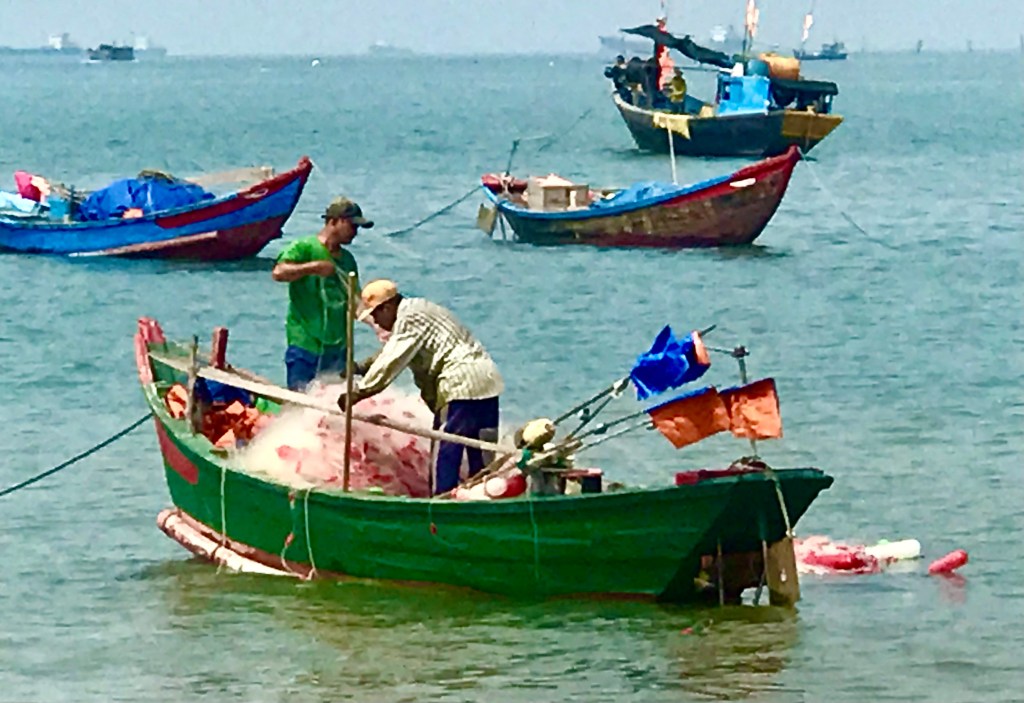
By the sea in Vũng Tàu
So I whisked Bruce away to the town of Vũng Tàu, a two-hour boat trip down the wide Saigon River, to where it meets the South China (East) Sea at the edge of the Mekong Delta.
Central Vũng Tàu is wrapped around a prominent headland incongruously topped by a 32-meter (105-foot) statue of Jesus. This rise essentially divides the town in two, with oceanfront resort hotels on Back Beach facing the ocean, and a peaceful green park promenade running along the inner river-mouth Front Beach.
Our plans for a beach getaway were stunted, as the neighborhood of our little Annata Beach Hotel still hasn’t recovered from the Covid pandemic. An adjacent set of resort properties were closed pending renovation by new investors, leaving our only practical access to a broad, flat beach, littered with colorful cone shells, nearly a half-mile away.
Instead, we were quite happy to drink beers at Australian-owned Ned Kelly’s Pub on Front Beach, and to eat an outstanding seafood dinner — river prawns the size of small lobsters, imported Atlantic salmon in a passion-fruit sauce — at the Ganh Hao 1 restaurant beside the harbor. Why import fish? A keen observer of details, Bruce had commented on the small size of the mesh he saw in fishermen’s nets here, likely a reflection of the diminished extent of South China Sea catches.
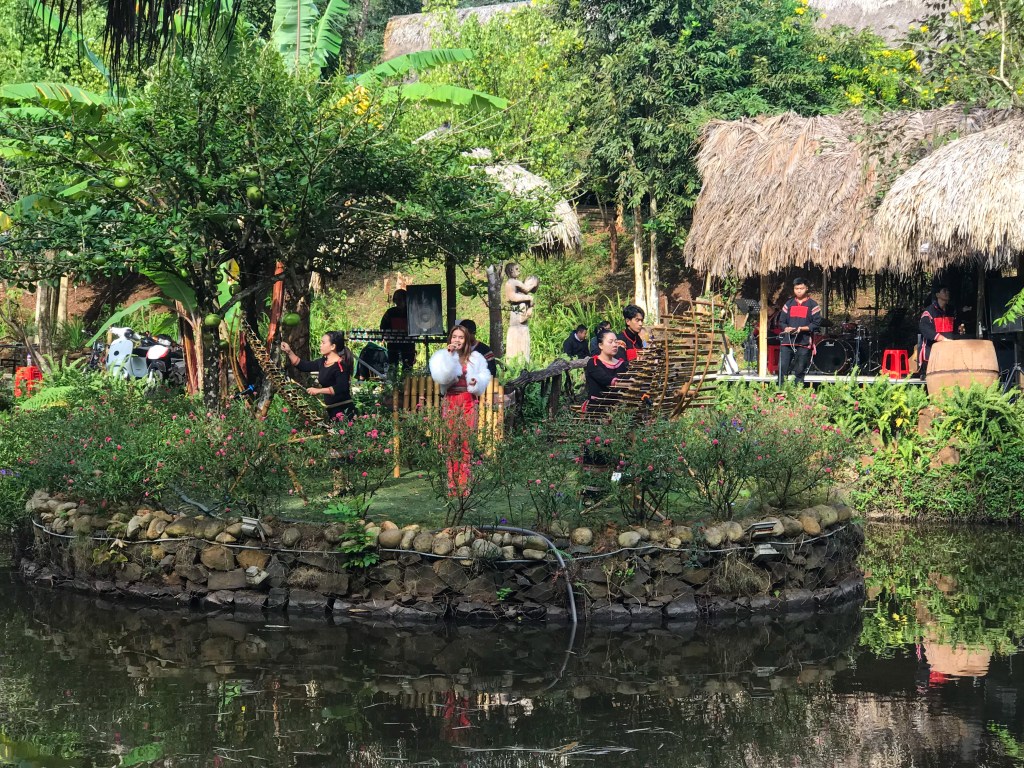
Buon Ma Thuot and Da Nang
My girlfriend, the lovely Lan Ha, lives in the Central Highlands town of Buon Ma Thuot (BMT), so it followed that we should spend the holiday there, far from severe traffic and pollution. Together with her younger sister and best friend, Lan Ha ushered us to a Christmas concert at Cà Phê Ako Ea, an open-air café and tourist village hosted by the indigenous Ede minority tribe. The following afternoon, we enjoyed lunch at the new Cốm Camp resort beside a small river in a suburban neighborhood.
Our other meals were highlighted by two bottles of cherished red wine that Bruce had carried all the way from Washington state, one of them a premium 2018 Doubleback cabernet sauvignon from the Walla Walla estate of retired football star Drew Bledsoe, a longtime acquaintance.
From BMT, we boarded a flight to Da Nang, metropolis of Vietnam’s central coastal region. To many Americans, it’s best known as the place where U.S. Marines made their first landfall in the war against the Viet Minh in 1965. Today it is so much more, a city of distinctive bridges and long sandy beaches, with more than a million people. We loved exploring the Museum of Cham Sculpture, which displays many of the finest relics of the ancient Champa Empire, a Hindu-influenced maritime realm.
Our hotel, the Pullman Danang Beach Resort, was lovely. Its relative isolation would have been perfect for a sunny, romantic retreat, but not so much for a pair of aging, straight bachelors stuck in the rain. So after two nights we snared a $10 taxi for a 27-kilometer (17-mile) run down the seacoast to Hội An, eminently walkable and endlessly interesting.
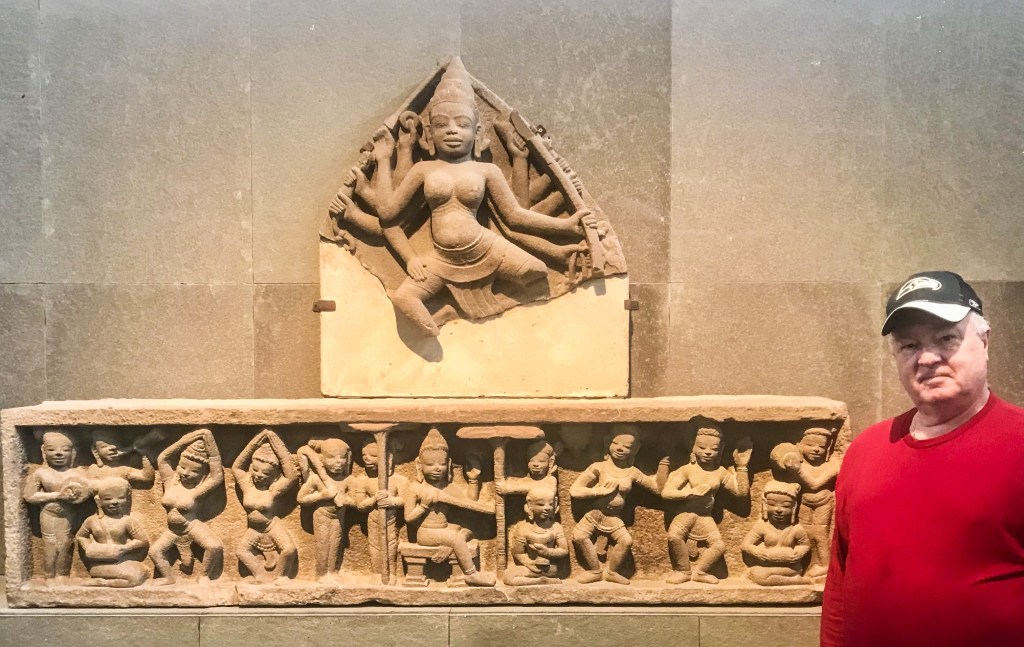
Historic Hội An
Hội An is my favorite destination in Vietnam, one that I wanted to be certain Bruce didn’t miss. The historic trade port, a city of international renown and intrigue in the 1600s and 1700s when it was known as Faifoo, is now a UNESCO World Heritage Site. No fewer than 800 centuries-old structures in its Ancient Town, the city’s core, have been carefully preserved; they are now home to custom tailors and crafts people, museums and markets, cafes and restaurants.
The Hội An Phố Library Hotel turned out to be a great place to stay. Centrally located, it’s only about a three-block stroll from the traffic-controlled Ancient Town, a couple of steps more from the pedestrian bridge over the Thu Bôn river to An Hội island. This is the hub of tourist activity in Hội An. Colorful handmade lanterns dangle from the frames of simple boats — quite a spectacle after dark — and from the ochre-hued buildings that line both sides of the waterway. On New Year’s Eve, live music burst from behind several facades, and massage spas (all of them monitored by police) did a booming business.
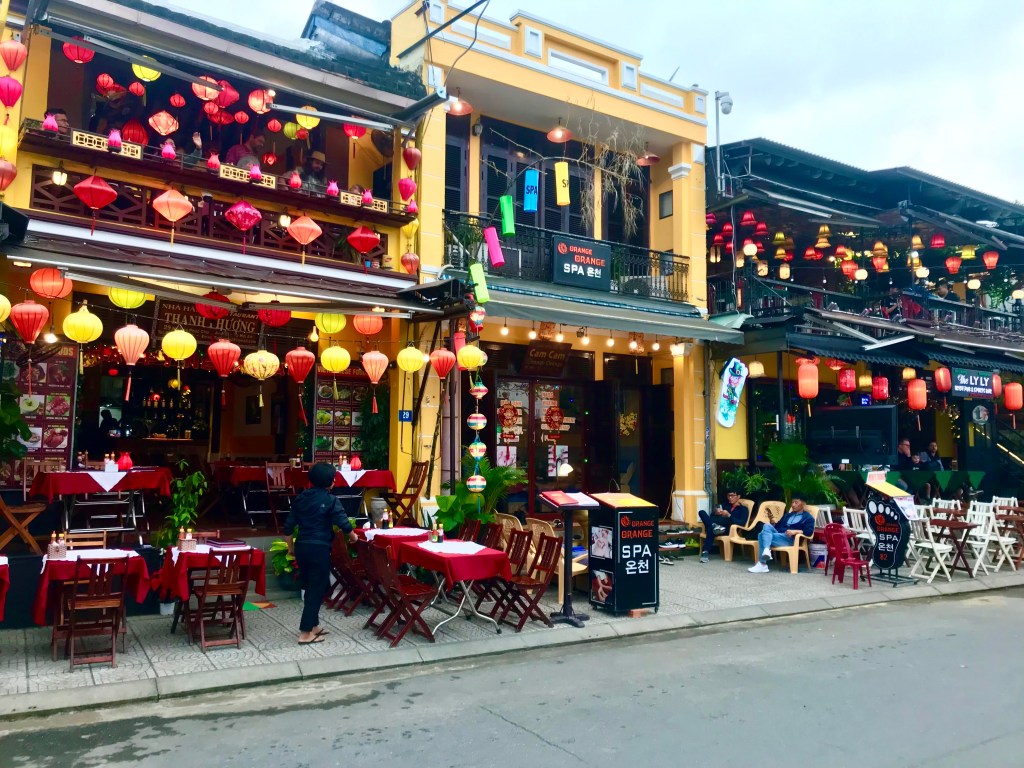
A highlight of Hội An is its unique array of Chinese assembly halls, where traders from Canton, Fujian and Hainan could gather and worship their Taoist and Confucianist deities. These colorful and ornate structures of brick and tile are often staggeringly beautiful. They are complemented by a Japanese covered bridge on the west side of the Ancient Town, built over a stream in the 1590s to link a separate Japanese ghetto to the main community.
Traditional crafts are alive and well in Hội An. Bruce and I commandeered bicycles one day and pedaled a couple of miles to the Thanh An pottery village, where we watched as an elderly woman used her foot to turn a primitive wheel as another woman shaped river silt into vases, bowls and other works of art. In the heart of town, a weaver offered a demonstration of silk textile creation by hand and machine. Restaurants in the heart of town offer a very international selection to satisfy an international clientele, but my friend Ho Hà, whom I had met on a previous visit, led us to an off-the-tourist-map Vietnamese restaurant, where we ate our fill of grilled grouper and chicken wings in nuoc cham fish sauce.

After Hội An, it was time to go home. I had to return to work in Ho Chi Minh City; Classics Sports Bar was calling Bruce, physically if not otherwise.
Another friend asked: With so much time, why didn’t I try to show him more places? Travel isn’t always about how many places you can see in how limited a time. I’ve always considered it more fulfilling to see fewer places well than many places fleetingly.
Besides, this was about two lifetime friends reuniting. We’re no longer spry whippersnappers. We’re past the peak of great lives and beginning a downhill slide. Hopefully we’ll both be around for another decade or two, but who really knows? Every opportunity for long conversations with best friends is something we truly cherish.


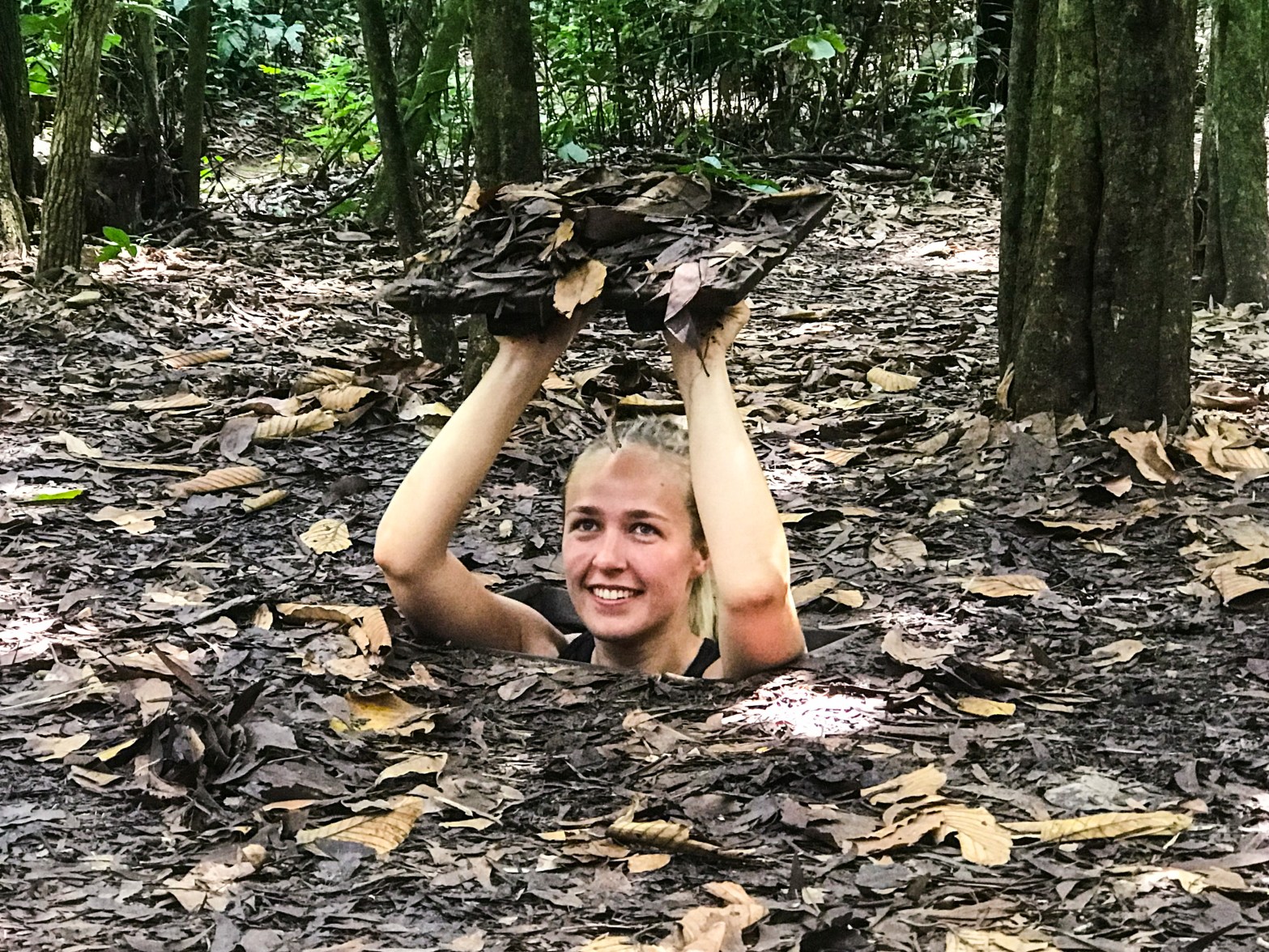
A tour of the Cu Chi Tunnels gives insight into how the North Vietnamese Army won its war against the South and its American allies.
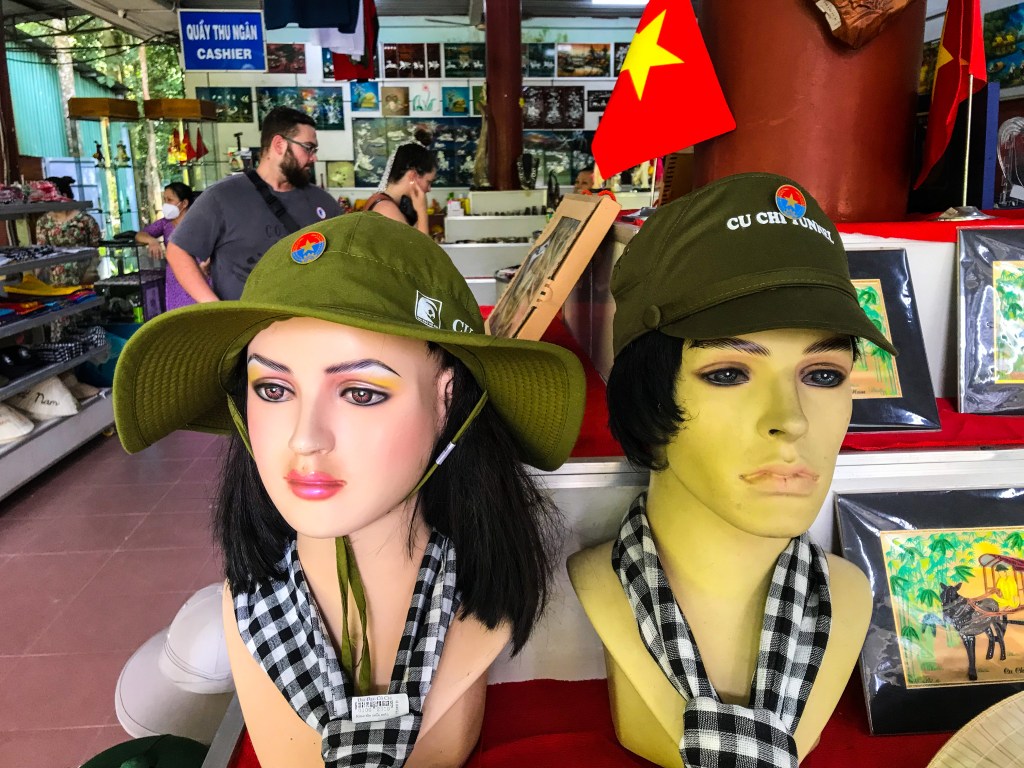
One moment, my friend is standing in front of me. I blink, and he is gone.
I shuffle over to the place I last saw David Blair and find only reddish-gray clay covered by fallen leaves. It is if the earth has swallowed him up.
Moments later, the ground moves and a trap door springs suddenly open. Like a jack-in-the-box, Blair pops out with a big smile. “It’s dark down there!” he exclaims.
We are in The Twilight Zone, foreign intruders at Vietnam’s notorious Cu Chi Tunnels.
Cu Chi is one of those places where fact dwarfs legend. From the mid-1960s to mid-‘70s — the darkest years of the conflict that Americans call the “Vietnam War” and Vietnamese remember as the “American War” — the North Vietnamese Army (NVA) built a veritable subterranean city from which its troops harassed U.S. forces allied to South Vietnam. Indeed, many historians today credit the impregnability of Cu Chi as the single most important reason why North Vietnam controlled the struggle.

Nocturnal lifestyle
The market village of Cu Chi — located about 39 km (24 miles) from the heart of Ho Chi Minh City, the former Saigon — was here long before the tunnels were built. And the tunnels are not only at Cu Chi; a complex labyrinth of interlinked burrows was constructed across the country. But here they were within shouting distance of South Vietnam’s capital city, a mere stone’s throw from an American air base.
The tunnels were much more than hiding places and supply routes. They were also living quarters, with kitchens, hospitals, communications centers and weapons caches. In their nocturnal lifestyle, emerging only at night, communist forces suffered almost unthinkable conditions. Fresh air and water were hard to come by; malaria and dysentery took nearly as many lives as battle wounds. It was taken for granted that they would share the warrens with snakes, spiders, scorpions and rats.
Today the Cu Chi tunnels are one of the most popular attractions for visitors to Ho Chi Minh City. More than 120 km (75 miles) of passages have been preserved by Vietnam’s government as a war memorial park. At two different exhibit sites, Ben Dinh and Ben Duoc, tour guides encourage exploration of restored sections of the original tunnel system. The varmints are gone (or so one would hope), but the scale of the excavations remains the same, typically about 2 feet wide and barely 3 feet high. It’s not a place for claustrophobes.

‘Like a Buddha’
David Blair is a friend from my home state of Oregon, a retired Congressional staffer who studied the Vietnam War both as a university student and a professional politico.
He and I pay a modest US $20 apiece to Joyous Travel to join a half-day bus tour to the tunnels, beginning at 7:30 a.m. Our group’s guide, a former high-school history teacher who calls hímelf Alex, tells a few too many bad jokes and repeats them twice too often. At least he speaks good English and makes an effort to be entertaining. Those two qualities are not guaranteed in Vietnamese tour guides.
Alex regularly references the city of Saigon, noting that “Ho Chi Minh City” is preferred only by migrants from the more affirmedly communist north. He speaks in hushed tones about the two postwar decades when Vietnam was closed to outside influence, and raves in glowing terms about former U.S. President Bill Clinton’s role in reestablishing relations between the countries in the ‘90s. “Bill Clinton is like a Buddha to us here!” Alex exclaims.
The drive northwest should require no more than an hour, but rush-hour traffic extends our travel. Then we make a lengthy rest stop at a roadside craft center. We turn blind eyes to giant red ants rallying their forces on a clothesline, instead focusing on artisans who demonstrate skills with broken duck-egg mosaic tiles and mother-of-pearl. David finds a work in lacquer that seems to bring to life the enchanting sway of Vietnamese hips clad in sensual ao dai dresses. It will soon adorn a wall in his Oregon home.

Deep cover
Arriving at the Ben Duoc tunnel, our tourist brigade — men and women mostly in their 20s and 30s, from Australia and various European countries — is ushered through turnstiles and down a woodland path. Alex shows us charts and maps that describe troop movement during the war, and indicates an underground conference chamber (now a video room) where such campaigns as the 1968 Tết Offensive were planned.
As we hit the trail, he warns us to be cautious around toxic foliage, and points out booby traps that might have been lethal to unsuspecting soldiers. A pit of sharpened bamboo punji sticks is especially chilling. A rusted-out American tank hints at a rapid abandonment.
The highlight is exploring the tunnels themselves. Not as young, as slender nor as athletic as my friend, I merely glimpse into the subterranean realm. He needs no encouragement to proceed through some 100 meters (325 feet) on his own. David describes the tunnel as a one-lane crawl space that, even for him, is a bit daunting.
We hear gunfire, and it’s getting closer. But we’re not in the line of fire: A controlled shooting range enables tourists to fire a variety of automatic weapons. Ammunition is sold by the bullet, and we are both more interested in exploring the merchandise at a large souvenir shop, and in enjoying cold beers as we wait for the rest of our party.

Tunnel rats
Throughout the war, U.S. armed forces made it a priority to seek out and destroy the Viet Cong tunnels, but with only minimal success. An elite squad of volunteer “tunnel rats” — armed only with handguns, knives, flashlights and string — stealthily crept through the catacombs to discover secret caches of weapons and strategic documents. After the Tết Offensive, relentless bombing missions heavily damaged some sections of the tunnels.
But Cu Chi remained a thorn in the Americans’ side until the eventual U.S. withdrawal in 1973. The incredible network of tunnels, intertwined with the Ho Chi Minh Trail, enabled the North Vietnamese Army to discreetly move troops and supplies south from Hanoi, leading to the fall of Saigon in 1975.
David and I are back in Saigon by around 2:30 p.m. It’s a long “half day,” but as we are both history enthusiasts, it’s a worthwhile one. And we are grateful we won’t be sharing our living quarters with snakes and scorpions.

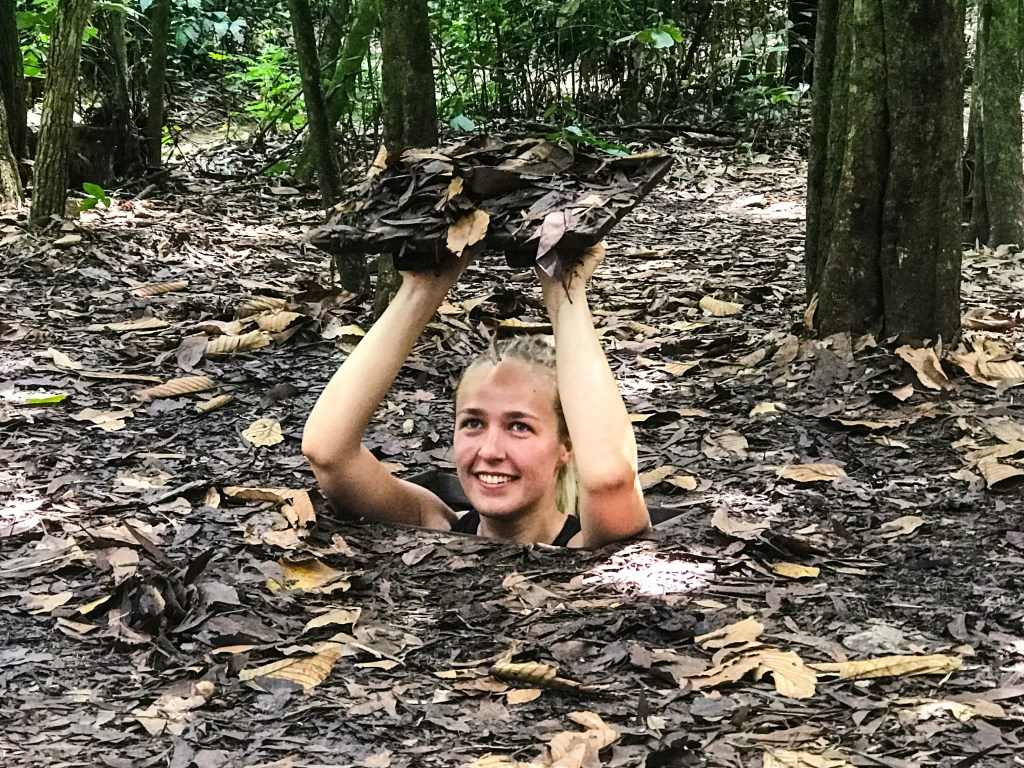

John and Calvin, his buddy from America, take in the sights, sounds, smells and tastes of Cambodia’s colorful capital city.
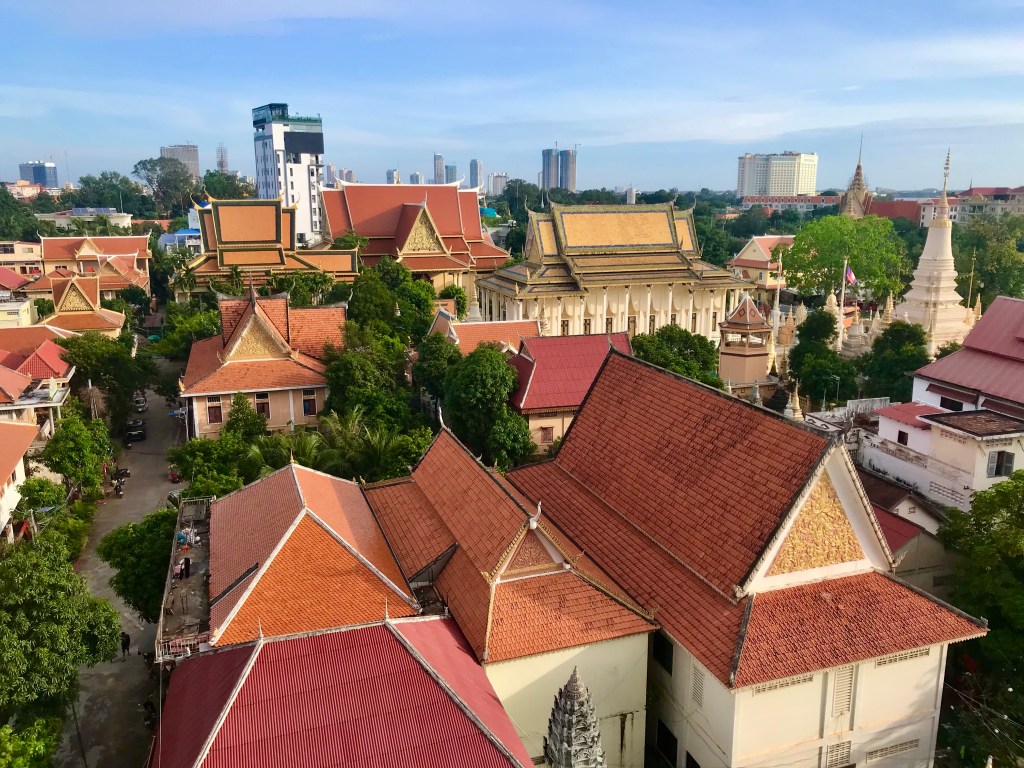
Calvin Mann is an original, and a good friend. Our acquaintance goes back to my decade and a half in Bend, Oregon, where this erudite noncomformist — a tall man with the broad shoulders and narrow waist of a swimmer — founded a company that manufactures self-contained sound booths for recording artists. We share a love of culture, food and music, whether it’s Calvin’s original guitar riffs, the countrified melodies of Jeff (the Dude) Bridges and the Abiders at the Tower Theater, or Cambodian vocalists backed by traditional tro (two-stringed fiddle), roneat aek (xylophone) and electric organ in Phnom Penh.
This saga begins there, in Cambodia, land of Angkor Wat and “The Killing Fields.” After a seven-hour bus trip from Ho Chi Minh City to renew my business visa, I was left with a long weekend to explore Phnom Penh with my pal.

Having just completed a trade commission visit to Japan and Korea with Oregon Governor Kate Brown, Calvin had chosen to extend his trip to explore new markets in Southeast Asia. He booked a stay at the Palace Gate Hotel and Residence, across a side lane from the Botum Dhammayuth pagoda and monastery. We gazed upon its tiled rooftops from our sixth-floor balcony. We could cross Wat Botum Park to use the large outdoor pool at a sister lodging, the Palace Gate Resort, which my friend made his daily regimen.
Phnom Penh is Cambodia’s national capital, a city of about 2.2 million people — diminutive versus the 13 million of Ho Chi Minh City (Saigon) but the clear metropolis of its own nation. Beyond astonishing classical architecture, a highlight is the broad palm-lined promenade known as Sisowath Quay. Following the Tonle Sap River upstream for 3 kilometers, from its confluence with the mighty Mekong to the city’s night market, it is a point of urban pride, beautifully maintained as a port of departure for nightly dinner cruises.
We were surprised by the American presence in the Phnom Penh. It was evident in the accents of aging Westerners at the open-air Riverside Bistro (where we succumbed to the temptation of burgers and beers) and in the widespread use of U.S. currency. Unlike neighboring Vietnam or Thailand, where transactions are strictly conducted in local currency (dong or baht), Cambodia seems to treat greenbacks as equal partners to riel, exchanged at a rate of 6,000 to the dollar. Both currencies are available from ATM machines.
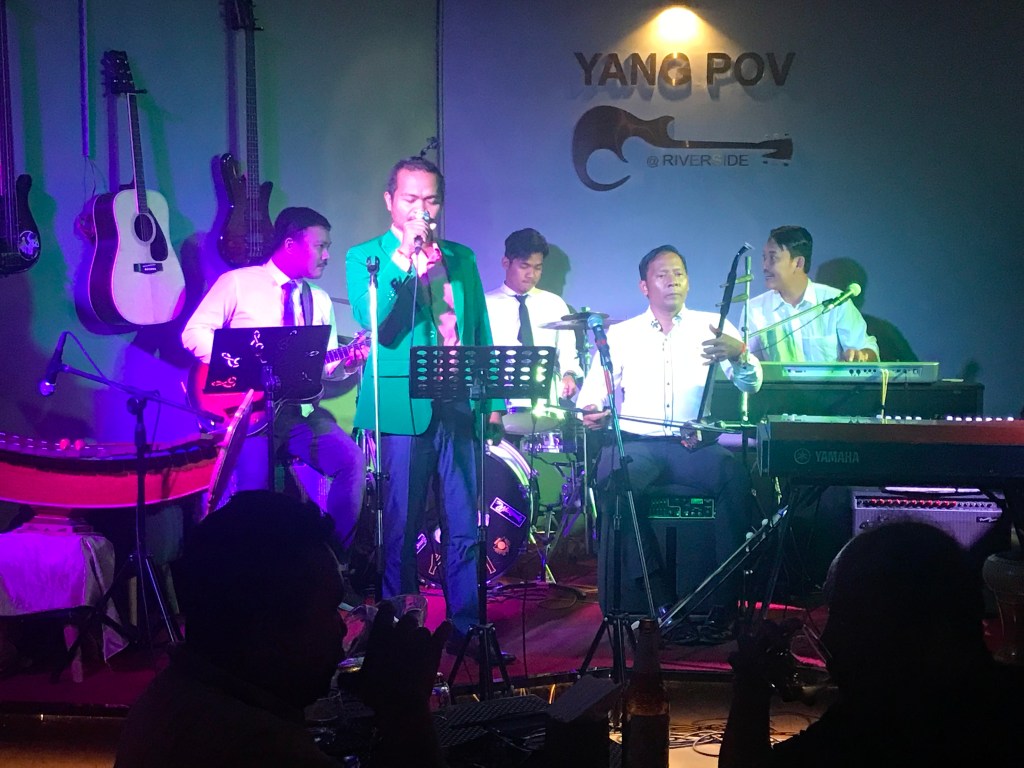
The sounds
As in Saigon, casual cocktail lounges explode after dark with bar girls engaging foreign male passers-by in seductive conversations. But it didn’t take long to discover that Phnom Penh has a much more satisfying live-music scene than its Vietnamese counterpart. At Oscar’s on the Corner, also known as The Guitar Man, for example, Srey Ka & K’n’E gave the cultural mixing pot several extra stirs in their haunting performance, noted above.
A few blocks west of the river, on obscure Palace Lane, we found a pub known only as Craft, where the Vagabond blues band was on stage. Its point man, Kevin Sysyn, told Calvin and I of his effort to bring nonsecular education to children in remote jungle villages — much to the chagrin of Jehovah’s Witnesses missionaries. The pub’s owner, Patrick Donovan (an Irish name if ever there was one), slotted Calvin in for a performance on the following Tuesday. I wish I had been there to hear it.

Calvin and I quickly got in the habit of breakfasting on street food. At the nearest corner to the Palace Gate, one open-air eatery served rice — with fried eggs, barbecued pork and vegetables — to a bustling clientele that invariably included a battalion of police. (The “bodyguard unit” was just down the block.) When we sought a change of pace, we traveled three steps to an adjacent café for a slow-cooked chicken curry, rich in coconut milk.
As coincidence would have it, we had arrived in the city for the not-so-scary Halloween observance of the birthday of the last king. Dignitaries were arriving from far and wide to pay homage to the late Norodom Sihanouk, and a large tent was erected outside the temple complex adjacent to the restaurants to offer prayers and music. We paused to greet a pair of novice monks in their tawny robes, then set out to explore the city by day.

The current king and head of state, Norodom Sihamoni, is Sihanouk’s son. His father was renowned for his support of traditional Cambodian culture and the arts, and Sihamoni himself was once a classical dance instructor. So we shouldn’t have found it unusual that no matter which direction we turned, we moved to a soundtrack of percussive melodies and evocative rhythms.
Not only was it the former king’s birthday; it was also Calvin’s. As a performing artist, he is always in the mood for a little lighthearted mischief-making.
The music led us down the broad boulevard that fronted the Silver Pagoda and Royal Palace. Opposite the century-old Chanchhaya (“Moonlight”) Pavilion, we encountered dozens of university students in their graduation gowns, taking selfies and other photos. Immediately, Calvin put his soft-shoe on public display. My friend somehow convinced me to join him in a chorus line with two graduate couples — just a step to the left, perhaps, and a jump to the right.
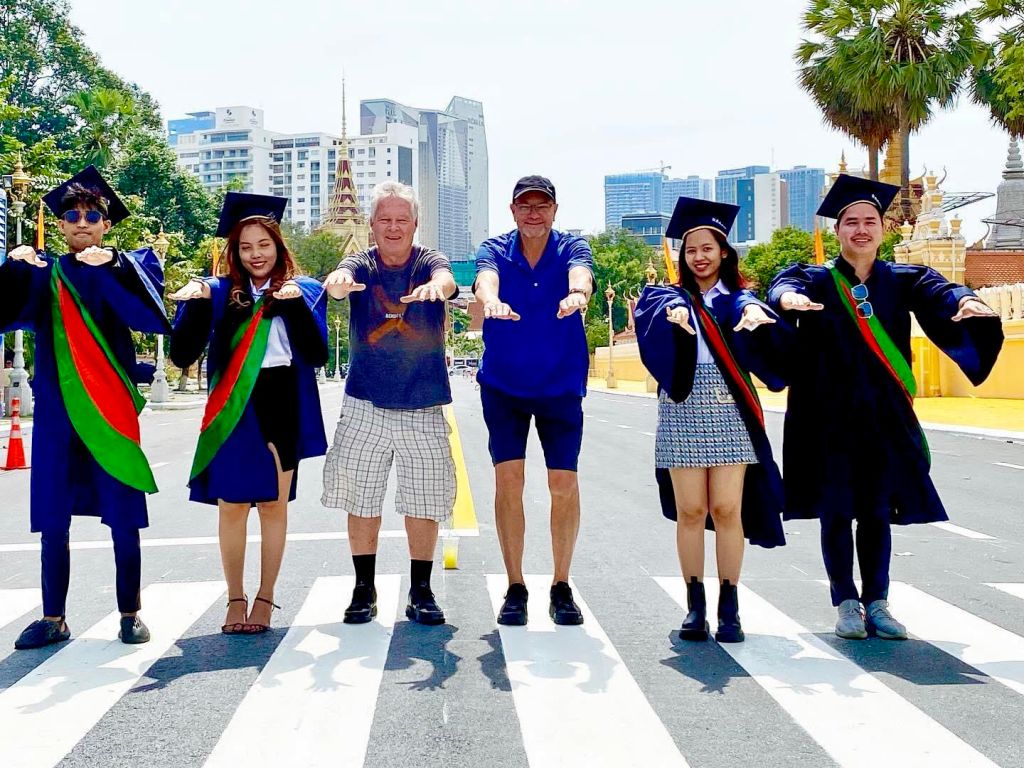
The sights
Cambodia is the home of the Khmer people, whose once-powerful empire extended across the entire Mekong Delta from the 9th to 15th centuries. Its primary capital was at Angkor, the renowned ancient temple complex near the modern city of Siem Reap. Through four centuries of warfare with Thailand, the capital moved several times until it finally landed in Phnom Penh following the French colonization of Cambodia.
The Royal Palace was built in 1866. Contained within a defensive wall, its 43-acre grounds feature traditional Khmer architecture with towering spires, chedis (or stupas), a throne hall, royal residence and murals. In late 2022, however, it was closed for maintenance, and to protect the royal family from the Covid pandemic.
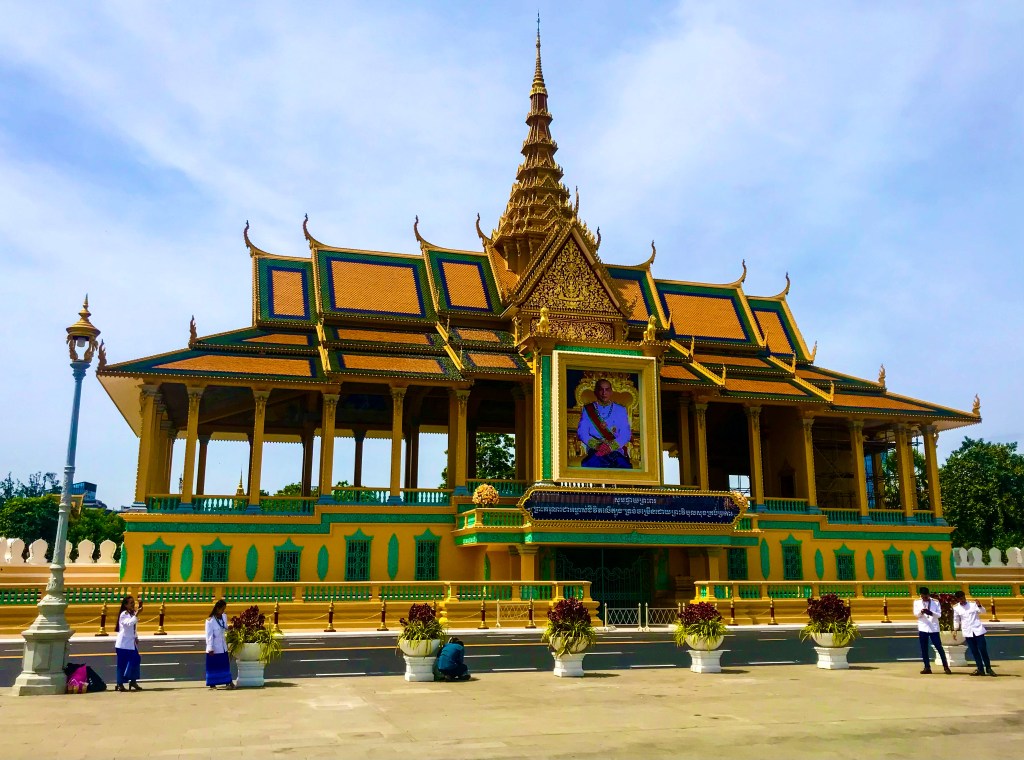
Adjoining the palace on ít south side is the Silver Pagoda (Wat Preah Keo), the Temple of the Emerald Buddha. Its national treasures include a small green crystal Buddha image, made in the 17th century, and a life-sized statue of the future Buddha, Maitreya, commissioned by King Sisowath in 1906. It weighs 90 kg (200 pounds) and is set with precisely 9,584 diamonds. At least, that’s what the literature says. We didn’t count.
Indeed, we weren’t able to visit. But our Cambodian friend Malin joined us at the nearby National Museum of Cambodia. Built in the 1920s with a design inspired by Khmer temple architecture, renovated in 1968, it has a collection of more than 14,000 items, including bronzes and ceramics. We were most impressed by the extensive exhibit of early Hindu and Buddhist stone sculptures, many of them dating from the halcyon era of Angkor Wat.

Far too much Cambodian heritage was destroyed during the tyrannous 1975-78 reign of Pol Pot. As leader of the communist Khmer Rouge movement, he perpetrated a ruthless civil war during which more than 1.7 million people (about one-quarter of the population) đied. Today this is mourned as the Cambodian Genocide.
The Toul Sieng Genocide Museum, in a former prison, and the Killing Fields mass gravesite, at the nearby village of Choeung Elk, are popular tourist destinations today. We wanted to keep things joyful on Calvin’s birthday weekend. They’ll still be there on my next visit.
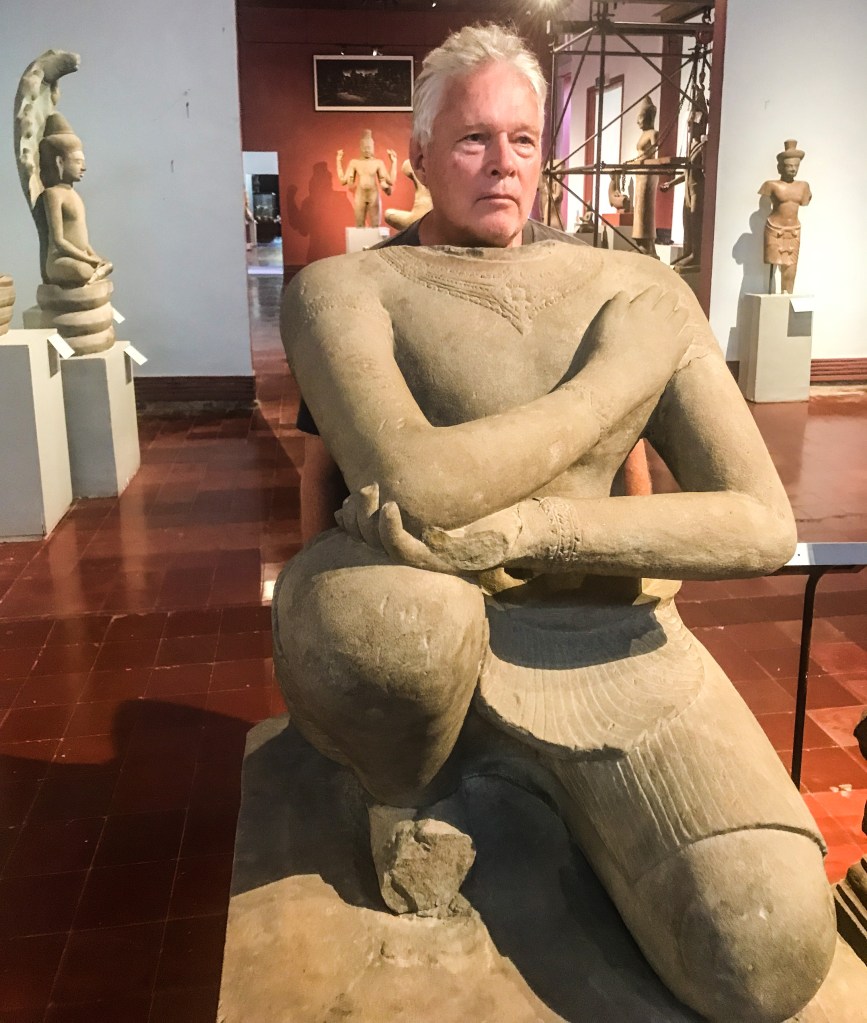
The scents
With celebration in mind, we found our way one night to a restaurant called the Oyster House, where we supped on plump river prawns and Angkor beer. The following evening we found the Kathmandu restaurant, where we followed a meal of tandoori chicken, fish tikka and navaratam korma with Chilean red wine and Calvin’ favorite post-meal treat: good cigars.
The bright-yellow Central Market (Phsa Thum Thmey) didn’t hold a lot of interest, except for its 1930s Art Deco architecture. Four arms, with arched roofs, extend from a central dome that rises 26 meters (85 feet) above the surrounding cityscape. But the myriad vendors’ stalls hold little of interest (food, clothing, jewelry, souvenirs) that isn’t available elsewhere.

I had arrived in Cambodia on a Thursday afternoon. I left by bus the following Monday morning, a US $24 fare to Ho Chi Minh City. (Calvin was continuing to Siem Reap.) The return trip took only about six hours, despite a delay at the border immigration station that was just long enough for an aging Jehovah’s Witness missionary to warn me of the spiritual evils promoted by Satan himself. We are all doomed, she said. I politely declined her conversational overtures.
No matter where you are in the world, this is how a weekend trip should be: Relaxed and fun, with no particular pressure to see and do new things. Two old friends reconnected, got to know each other even better, ate food never before tasted or shockingly familiar, and crossed paths with new friends. I’m ready to go again tomorrow.
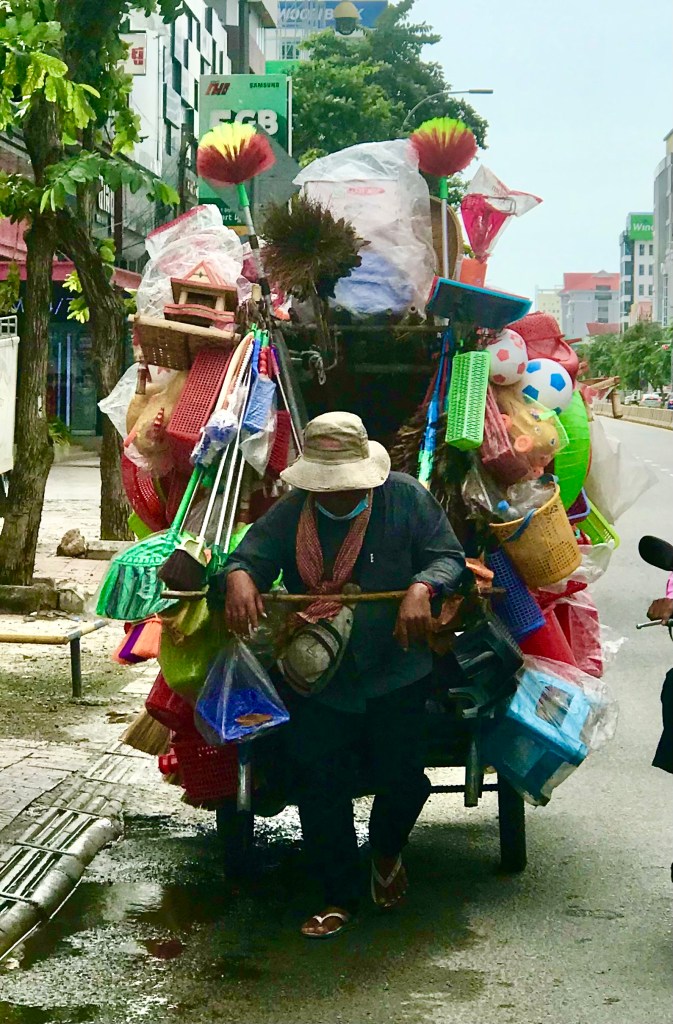
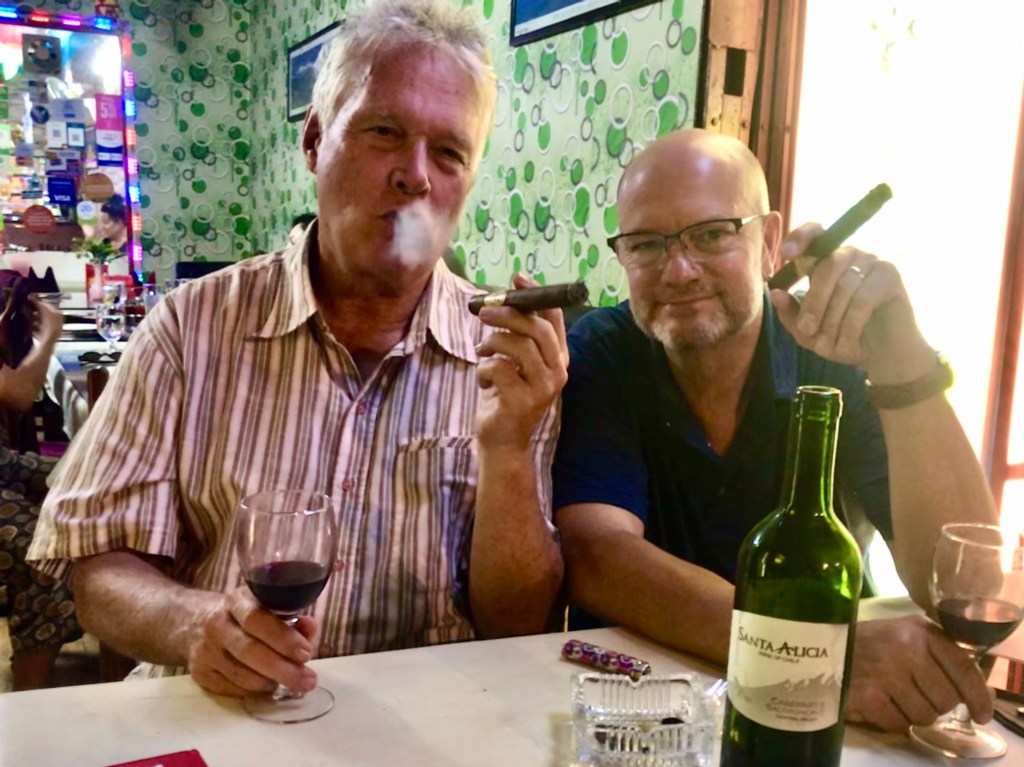

An Asian-born, American-raised chef blends two very different culinary cultures in the heart of Ho Chi Minh City.
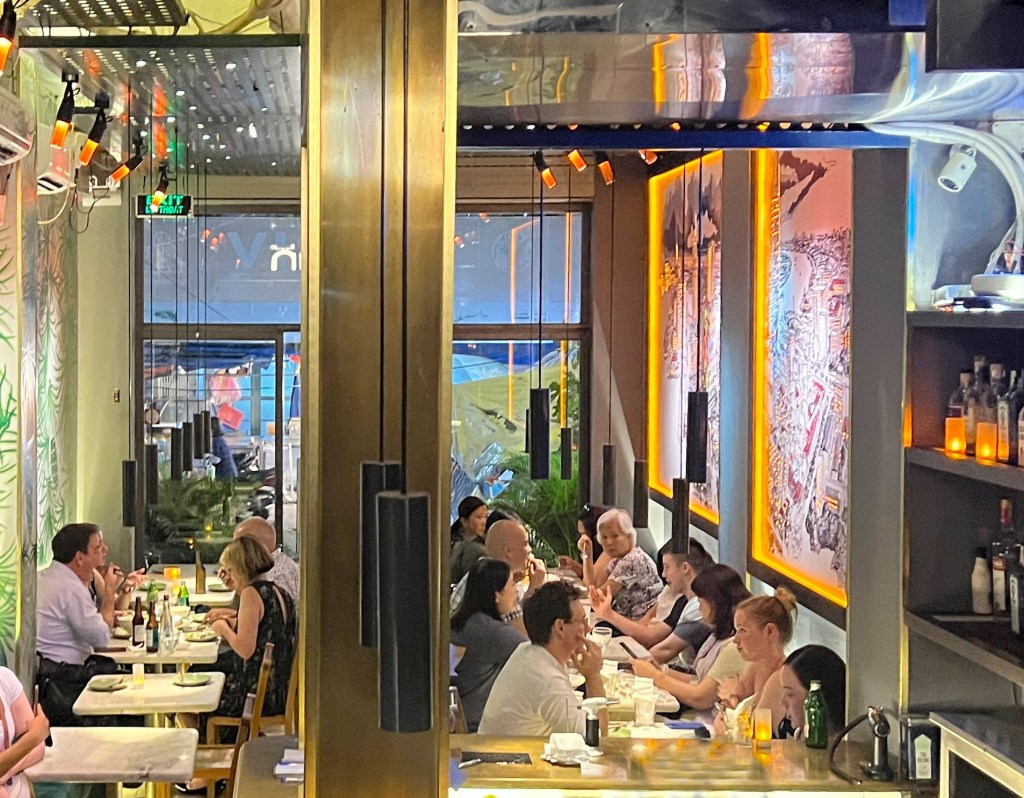
Everyday Vietnam food can be boring. Noodles and rice, rice and noodles. Day in, day out.
Noodles doesn’t mean pasta, not like spaghetti or macaroni. It means soup. Phở bò tai nam (thin rice noodles with beef in a marrow broth), bún bò Huế (another beef-based soup with broader noodles and pork knuckles), bún riêu cua (thin noodles in a tomato-based broth with minced freshwater crab) and hủ tiếu (flat rice noodles in a pork broth with shrimp) are some of the most popular varieties, always offered with “salad” (lettuce and the leaves of various herbs) to mix on top.
Rice (cơm) is an all-encompassing term for whatever you ate for lunch today. There’s “rice and fish” (cơm cá), “rice and chicken” (cơm gà), “rice and pork chop” (cơm suon), rice and whatever else you might have. Granted, there are at least a couple dozen different kinds of rice in Vietnam: fried rice (cơm chiên), sticky rice (cơm xôi), broken rice (cơm tấm), red rice and jasmine rice, to name but a few. But rice is still rice. The meat and rice are most often served with a barely palatable cooked vegetable such as water spinach (mostly stems) or sour melon, frequently stuffed with minced pork.

There’s no such thing as “slow cooking” here. As opposed to the French style of cooking favored in the West, which favors lower heat to encourage the blending of herbs and spices used in seasoning, Vietnamese meals are cooked quickly (in 15 minutes or less) and consumed even faster.
Were it not for the high carbohydrate content, Vietnamese meals could be considered healthy. Very little salt or butter are used in preparation. Fish oil (nước chấm) is the primary condiment. Every table is stocked with various sauces such as soy, typically served in a dish with sliced red peppers; processed chili sauce, a less savory relative of Western ketchup; and mắm tôm, a foul-smelling purple mash of fermented shrimp paste.
Viet fusion
Peter Cuong Franklin observed a lack of culinary sophistication in his native country. The founder and executive chef at Ho Chi Minh City’s Ănăn restaurant took the lead in combining the subtleties of Vietnamese preparations with techniques from other global cultures. His efforts in fusing Viet and Western cuisines led to Ănăn becoming the first establishment in Ho Chi Minh City, a metropolis of 13 million people, to be named to the esteemed list of “Asia’s 50 Best Restaurants” in 2021 and again in 2022.
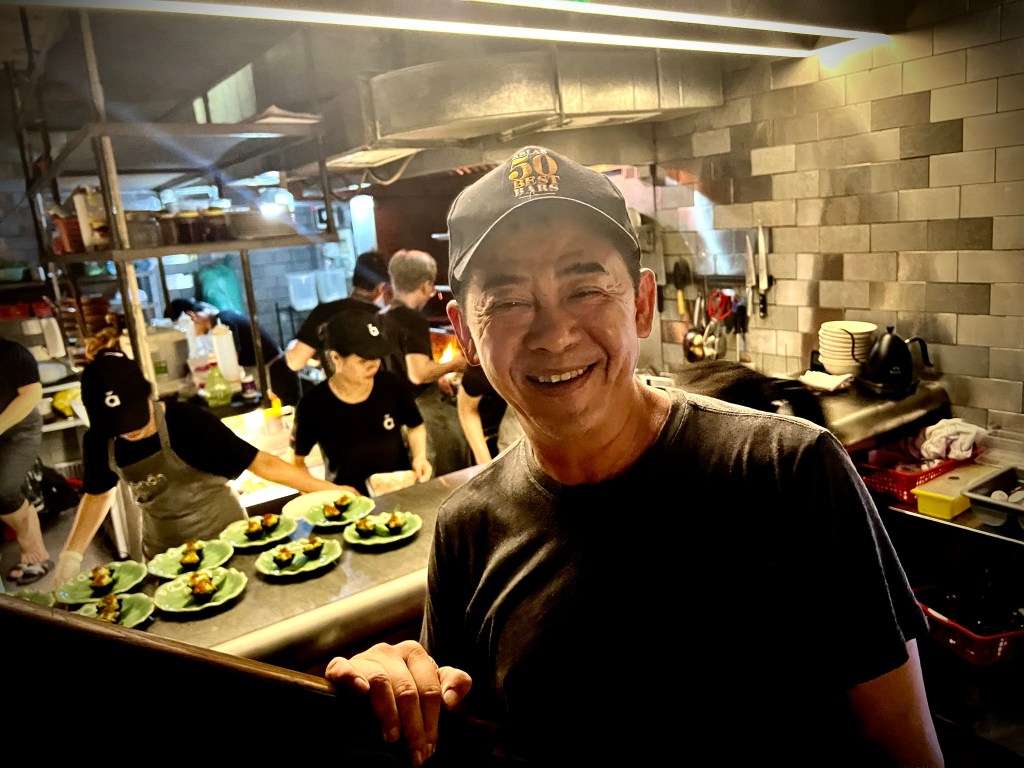
Franklin was uniquely suited for this achievement. Now 59, he was born near the hill town of Da Lat. On April 29, 1975, when he was 12, he and other children were airlifted from Saigon the day before North Vietnamese army tanks rumbled through the wrought-iron gates of the South Vietnamese capitol, now known as Independence Palace. Young Peter Cuong didn’t see his home again for decades.
He landed on his feet. Adopted by an American naval family, he had a New England education that climaxed at Yale University. He became an investment banker, first in New York, then in London and Hong Kong. But while he was making money, his dream job was in a kitchen: “I never forgot my mother’s food from those early years,” he told an interviewer in 2021. They were reunited after Vietnam reopened to the West in the mid-1990s. “She remains my true culinary inspiration,” Franklin said.
He launched his second career when he enrolled at Le Cordon Bleu in 2008, then trained at renowned restaurants in Asia and the United States, including Alinea in Chicago. In 2011, he established his own restaurant, Chôm Chôm, in Hong Kong. Ănăn followed in 2017.
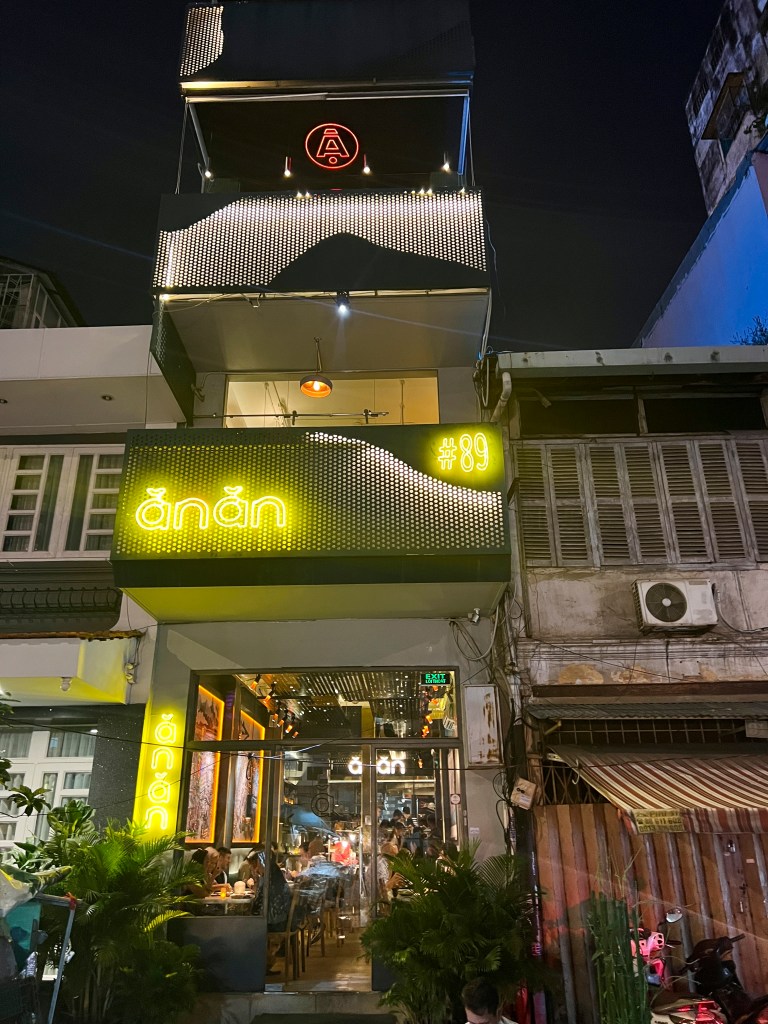
Eat, eat!
Ănăn — the name translates to “Eat, Eat” — fills the floors of a tall, narrow “tube house” that rises behind the vendors’ stalls on Tôn Thất Đạm, the last remaining wet market in downtown Ho Chi Minh City. Three intimate floors of dining find their zenith in the upper-story Nhâu Nhâu (“Drink, Drink”) cocktail lounge, itself capped by a rooftop garden.
I’ve been fortunate to dine here twice in the past couple of months, once with my photographer friends Doug Peebles and Len Kaufman, visiting from the United States; again with my frequent local dining companion, Lâm Nhi. Each time, service was gracious and of an extremely high standard from start to finish. I would have expected no less from a staff trained by an industry veteran like Chef Peter, as he is now widely known.
Franklin describes his style as New Vietnamese Cuisine. His childhood hometown of Da Lat is the incentive for many of his creations. The cooler climate of this former French hill station, at the crown of the Central Highlands 1,500m (5,000 feet) above the Mekong Delta, enables farmers to nurture a wide range of vegetables and fruits not suited for the steamy heat of lower elevations. Huge avocadoes and sweet, rich strawberries stand out in the street markets, but there is so much more.
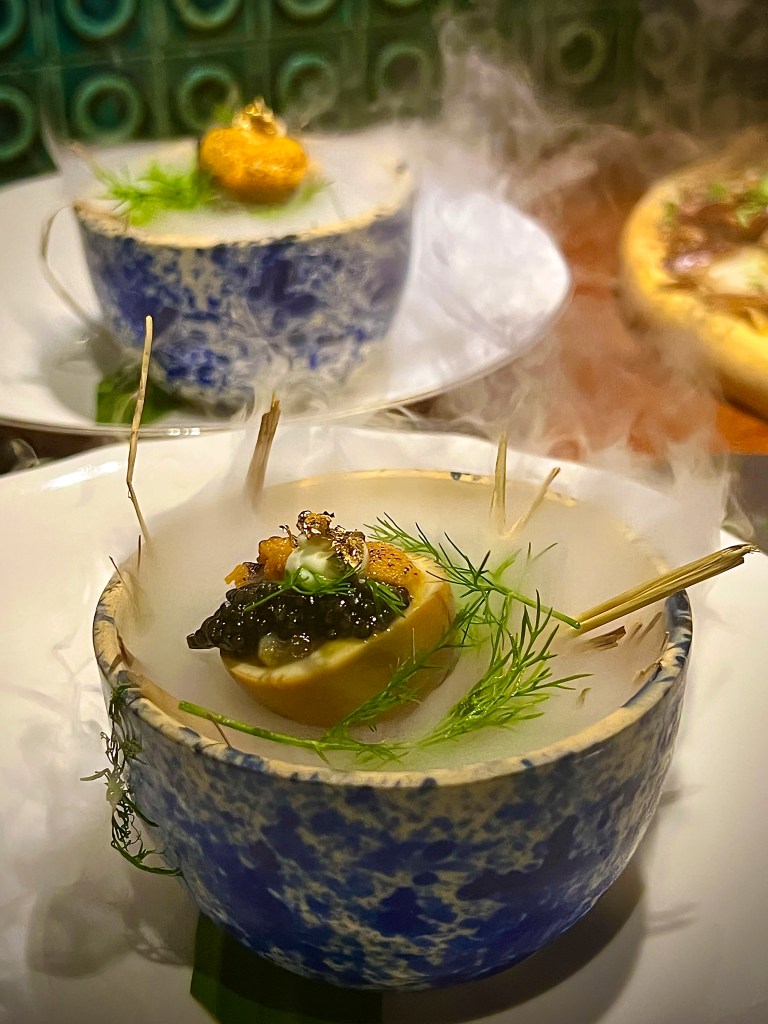
Da Lat style
There’s no doubt Chef Peter loves veggies as much as I do. One dish frequently appearing on his Specials Menu is a preparation of artichoke and asparagus, steamed with herbs and served with a dipping sauce of fermented tofu. Another is Da Lat broccolini, served with crispy chorizo sausage and an egg. The herb-rich burrata cheese salad is presented with fresh fennel, watercress, tomato, onion and basil pesto.
Anyone who has ever strolled the winding hillside streets of Da Lat knows the town’s trademark “pizza,” grilled on rice paper atop a hibachi-style grill. Da Lat pizza must have been a beloved childhood snack for Chef Peter, who now offers it with a choice of three toppings: truffle mushroom, pepperoni or roast duck. We enjoyed it with the latter, and would defintely do so again.
Although it is hours from the sea, Da Lat has a sturgeon caviar farm. One of Ănăn’s most unique offerings is the smoked caviar egg, served steaming — a “black chicken” (gà ta) egg afloat in a broth with caviar and Japanese uni, or sea urchin. Gà ta is widely revered for its high protein content and antioxidant properties.
Salmon roe, another sort of caviar, tops bánh nhúng, a dish of smoked salmon, crème fraiche and locally sourced dill.

Imperial coast
The central coast and ancient imperial capital of Huế are another region from which Chef Peter draws. During the time of French colonization, Vietnamese developed a taste for crêpes, the delicate filled pancakes that can be made either sweet or savory. The Asians made crêpes with rice instead of wheat, filling them with shredded pork, small shelled shrimp and bean sprouts. Ănăn’s bánh xèo tacos follow the same principle, but now the crêpe is seasoned with turmeric, folded and crisped like a Mexican taco — then filled filling with juicy wagyu beef or pork belly, shrimp, fresh herbs and peanut sauce.
Another regional dish is wagyu bò lá lot. Domestic Vietnamese beef is not of high quality, so the finest marbled steaks are imported from Australia or the United States. But in earlier days, Huế’s royal chefs learned to improve the tenderness and flavor of Viet beef by grilling it inside a peppery betel leaf, prized as a medicinal herb. Ănăn has continued the tradition, seasoning it with nước chấm, mild curry, lemongrass and toasted peanuts to give the tender, smoky meat a distinctive aroma.
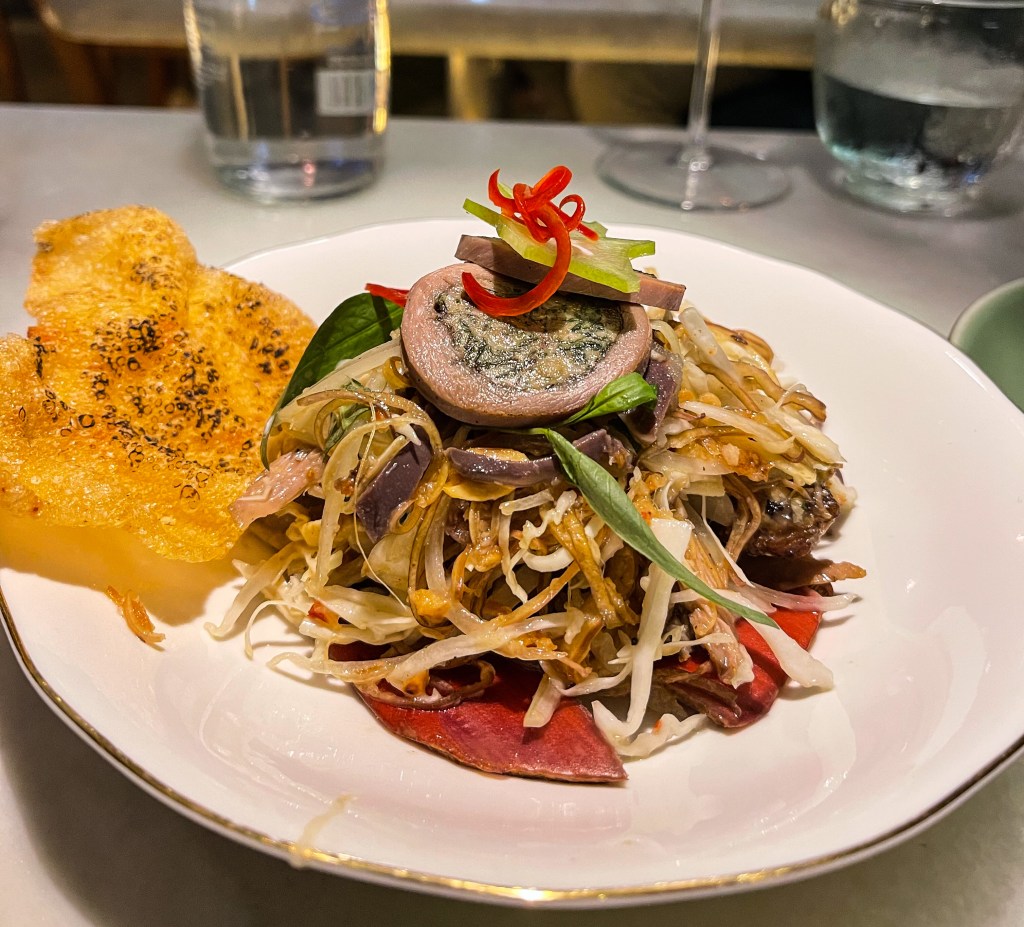
A nod to Hanoi
A northern Vietnamese dish that I enjoyed for the first time early this year in Hanoi, albeit with chicken instead of the Mekong Delta duck offered here, is banana-blossom salad. Bunched in rows at the end of banana clusters, the flowers, ranging in color from purple to gold, are rich in vitamins and nutrients: It’s amazing how many of these “superfoods” have found their ways into Southeast Asian diets! At Ănăn, the flowers and duck are tossed in a ginger nước chấm sauce with cabbage, various herbs, crispy shallots and peanuts.
Also deriving from the north is chả cá Hà Nội, featuring filet of black cod marinated in turmeric, served sizzling with a mound of sticky rice in a pool of dill sauce with fresh lacy dill and scallions. This is one of my favorite Ănăn dishes. As the Vietnamese say, it is ngon. Delicious.

Chef Peter has a unique ability to take everyday Vietnamese dishes and turn them into something special. In “one bite phở,” the iconic beef-noodle soup known the world over as phở, becomes a star of “molecular” gastronomy. In this food-science art, everyday dishes are transformed (with component properties intact) into largely unrecognizable new forms, disassembled and reassembled. Thus Ănăn diners are presented a ladle that nestles a gelatinous dome of soup, tantalizingly topped with meat, vegetables, herbs, even a flower as a finishing touch.
A similar if not molecular approach is taken with one bite bún chả,a dish traditionally identified with Hanoi. Grilled fatty pork (chả) is served with white rice noodles (bún), crispy spring rolls, herbs and dipping sauce. At Ănăn, they’re all skewered together atop a shiso leaf.

Mekong Delta
The Mekong Delta is the nation’s primary agricultural region, significantly outpacing the Red River Valley of the north. Its beast of burden, so often seen slogging through the rice fields, is the Mekong water buffalo. This powerful bovine also is raised as a protein-rich source of food, although its meat is tougher than that of its cousins, beef cattle. Indeed, farm workers will often carry a stash of buffalo jerky into the paddies, a perfect snack for long days.
Ănăn’s chefs keep the meat tasty but tender. They slice prime cuts into a buffalo carpaccio, seasoned with lemongrass, salt and green peppercorns. They also raid the barnyard for their beef tongue and pig ear salad. In true Third World style, no part of an animal is wasted when it comes to food sources.
The Mekong region is famous for its seafood. The restaurant’s lightly grilled calamari is seasoned with garlic and herbs, served with two chili sauces (one of black squid ink), and vegetables.

Sweet farewell
Not to be forgotten are the sweets that finish a meal. Vietnamese love ice cream almost as much as they love fish sauce — and so, Chef Peter reasoned, why not put the two together? In his fish sauce ice cream, vanilla ice cream is topped with a caramel blended with nước chấm, seasoned with pepper grown on Phu Quoc island, and perfumed with more fish-sauce extract.
Lâm Nhi and I preferred the bánh cam dessert — twin balls of Japanese-style rice mochi and dark chocolate ganache, toasted in sesame seeds and a sauce of ginger and calamansi (Philippine lemon). Served with bites of pineapple, strawberry and Phan Thiết dragonfruit, it was a fitting end to a memorable meal.



Assorted advice and observations for first-timers venturing to this Southeast Asian country.
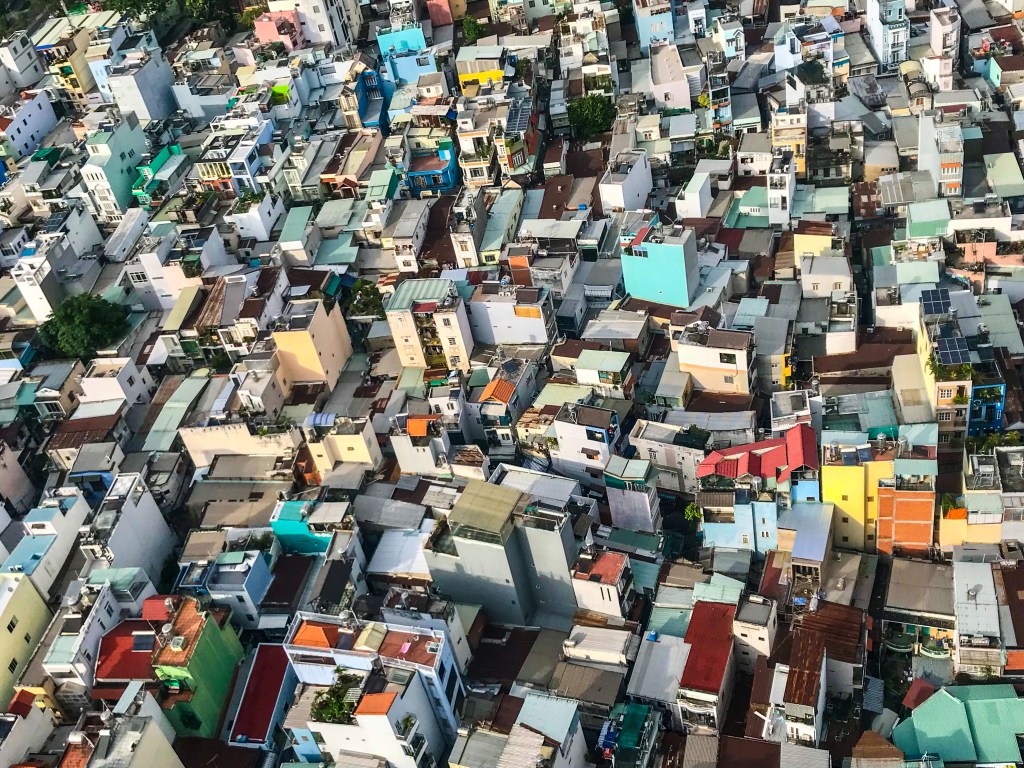
Now that Covid fears have mostly been alleviated, I’m getting a steady stream of visitors — old friends from the USA — who have promised visits. None of them have visited Vietnam previously. Most of them have never set foot in Asia.
It occurs to me to offer my friends an inventory of essential knowledge they should have before they step off the airplane. So, friends, lend an ear (or an eye). We’ll start by talking about traffic.




Evenings, beer is the beverage of choice. Tiger, Saigon and 333 are among the leading local lagers (about US$1 a can or bottle), and numerous outstanding craft brews are now being locally manufactured. Wine is still largely unknown, but spirits are cheap and good, especially Hanoi vodka (made with Russian guidance). By day, look for coconut water and outstanding fruit juices.

And a few comments on Vietnamese society:

This is reflected in an educational system that does not encourage imagination or creativity. What young people don’t see in their own culture, they find in others, especially Korean music, film and fashion.
These are just a few observations … my newly arrived friends will soon make many additional discoveries of their own!

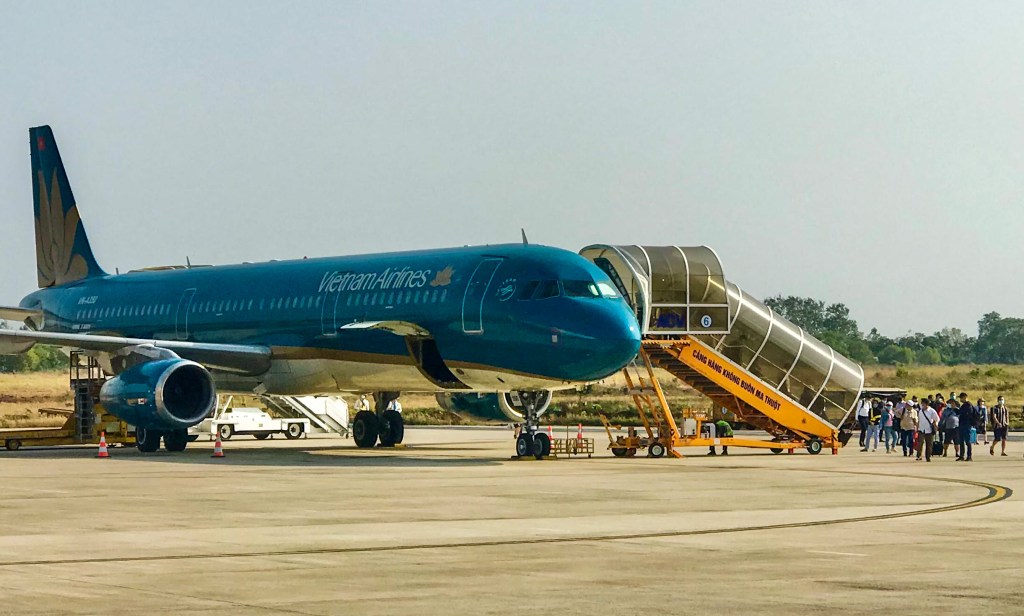
Sharing a link from the East-West News Service, which has just published my story on the ao dai, iconic fashion of Vietnamese women. (Click on the headline below to retrieve the full story.)

The author reflects on his lifelong passion for the sport of baseball, largely unknown in Southeast Asia, as his favorite team finally has a winning season.

There isn’t much baseball played in Southeast Asia. It’s true, I swung a bat in slow-pitch softball games when I was living in Singapore in the mid-‘80s, but baseball? No way, José.
In Vietnam, the sports of choice are football or soccer (bóng đá), as in much of the world, and badminton. Basketball is far from unknown, and both tennis and volleyball are growing in popularity. In parks, in early mornings and evenings, you may also see young men testing their skills in sepak takraw, the Malaysian national sport, a highbrow version of hacky sack played with a ball made of rattan.
Vietnamese take their soccer seriously — the national team is a perennial championship contender in the ASEAN Football Federation — but fans fortunately do not go as nuts as in some other Third World countries. In case you missed it, just three days ago, on the ridiculously overpopulated Indonesian island of Java, a stadium riot following a tense soccer match took 131 lives. I had thought that sort of thing only happened in South America.
My favorite spectator sport, however, remains baseball. And my favorite team, the Seattle Mariners, have just made the end-of-season Major League playoffs for the first time since 2001, when my son was a high-school senior. They have a chance to play in the World Series for the first time in their 45-year history. Even from my faraway perch here in Vietnam, modern technology enables me to stay in touch. Thanks to live audio and YouTube videos, I have been able to applaud — indeed, to closely monitor — their success.

Addicted to the game
My obsession with baseball is hardly new. Sometimes, I think it’s how I measure time. This love affair goes back to my primary school years in the late 1950s, when I sat with my dad in front of our tiny black-and-white TV to cheer for “his” team, the Milwaukee Braves of Hank Aaron and Warren Spahn, in consecutive World Series against the reviled New York Yankees of Mickey Mantle and Yogi Berra.
I was never much of an athlete, and my little-league career was destined for failure. But I learned to keep a detailed scorecard at professional games, where I got to know some of the players and was delighted when they sent me to the concession stand to buy hot dogs for them. In tedious moments, I made up card and dice games — Six of Clubs was a groundout to shortstop, Queen of Hearts was a double to center field — and kept careful score. I went to sleep with my transistor radio tucked under my pillow, as I listened to San Francisco Giant games.
At the University of Oregon, I pursued a degree in journalism with an eye on becoming a sportswriter. I attended nearly every Oregon baseball game for four years, home and away, acting as official scorer and covering for The Register-Guard. By my 20th year, I was writing baseball as a summer intern for The Honolulu Advertiser, sitting in the press box with broadcaster Al Michaels, interviewing icons of the sport like Tommy Lasorda. The manager of the Hawaii Islanders, Chuck Tanner, who had been an outfielder on the Milwaukee Braves clubs of my early childhood, took me under his wing and tutored me, one-on-one, in how best to interview young players. He had sons of his own, about my age.
“Baseball is the most perfect of games, solid, true, pure and precious as diamonds.” W.P. Kinsella, author of Shoeless Joe, upon which the movie Field of Dreams was based, wrote that. Three strikes, you’re out. Three outs makes an inning and your team is out. Three times three (nine) players are in the field. Three times three times three outs (27, if you’re counting), the game is over. But the game is never over until the last batter is out. The Kabbalah has nothing on baseball. As Annie Savoy said in Bull Durham, “the only church that truly feeds the soul, day in and day out, is the church of baseball.”

One foot in the toy store
My future as a baseball writer was all but assured. Then, somewhere between Kalakaua Avenue and Copenhagen, I took a left turn. Instead of accepting a post-graduation offer of a sportswriting career, I chose to spend six months traveling in Europe.
By the time I returned to North America, I had decided that my future would be international. I didn’t want to spend my life in “the toy store,” as one of my colleagues described the sports desk. I went back to Honolulu as a general assignment reporter. I worked for newspapers in Auckland and Sydney, Seattle and Los Angeles, and for publishers in Paris and Munich and Singapore. I made the leap into travel writing and editing. But I never lost my love for baseball.
Some of my greatest memories are the times I spent with my son at Seattle Mariners games. Erik was 5 years old when Ken Griffey, Jr. (“The Kid”) first stepped onto a Major League field in the Emerald City at age 19. For the next 22 years, as my son grew from a child to a fine young man, we closely followed Griffey’s career, defined not only by his immense talent but also by his infectious smile and passion for the game. In so many ways, he embodied what baseball meant to us.
In July 2016, after “The Kid” was inevitably and overwhelmingly voted into the Baseball Hall of Fame, the Mariners planned a weekend-long celebration to honor the greatest player in team history. I was pleased to tell Erik that I had tickets. My son glumly told me that he hoped he’d still be alive. He didn’t make it that far. Stricken with a rare cancer, he passed on Father’s Day in June. Erik watched his beloved Mariners play for the final time, an 8-4 win over the Boston Red Sox, from his hospice bed.

Past and future stars
For all the great players who have graced the Seattle roster through the years — Griffey, Edgar Martínez, Randy “Big Unit” Johnson, Ichiro Suzuki — the Mariners had made the playoffs only four times in their 45-year history, and not at all since 2001. To say these were down years would be an understatement. Twice in that span, they lost more than 100 games in a season. Finally, new management began to reverse the team’s fortunes. A year ago, they fell just short of the playoff round. This year the team started slow, but a mid-season winning streak elevated them to lofty heights: a real possibility that the playoffs were within reach.
No team can ever be carried by just one or two players. Sometimes it takes a catalyst. On the 2022 Seattle Mariners, the man who brought it all together is a joyous 21-year-old from the small Dominican Republic town of Loma de Cabrera.
Julio Rodríguez, already known to his legion of fans as “J Rod,” is like a second coming of Griffey. Playing with passion and flair, he took little time to establish himself as the team’s best player. Chosen to play in baseball’s annual All Star Game in July, he introduced himself to a national audience by slugging more home runs in an exhibition Home Run Derby than anyone had done before.
Julio was out of the lineup last week, recovering from a back strain, when the Mariners clinched their playoff berth. In J Rod’s stead, a walk-off home run from slugging catcher Cal Raleigh, himself all of 25, lifted the team over the line. Now, with one of baseball’s best pitching staffs, a solid defense and an offense capable of rising to the occasion, Seattle hopes to extend its season well into October, perhaps even November.

Fighting for a championship
One dozen teams — six each from the American and National Leagues — begin the playoffs on October 7. Over the next three weeks, 12 teams become eight; eight become four. League winners survive best-of-seven series and play for the championship of baseball in the World Series beginning October 28. No Seattle club has ever made it that far. Is this the year?
On June 26, the Mariners’ record was 10 games below .500, at 29-39, when an errant pitch ignited an infield brawl in a game against the Los Angeles Angels in California. When the dust finally cleared, a dozen players from both teams had been ejected. Unlike Java, no one died. No one suffered serious injury.
Something changed in the Seattle psyche on that Sunday. Since then, the team has had a 58-32 record. The Mariners aren’t patsies. They’re fighters. When Seattle opens the playoffs on Friday — in Canada against the Toronto Blue Jays, with J Rod patrolling center field — they will be there not merely to participate, but to try to win a world championship.
And although the Seattle baseball stadium accommodates 48,000 fans, I am secure in the knowledge that a soccer-style riot is highly unlikely.

